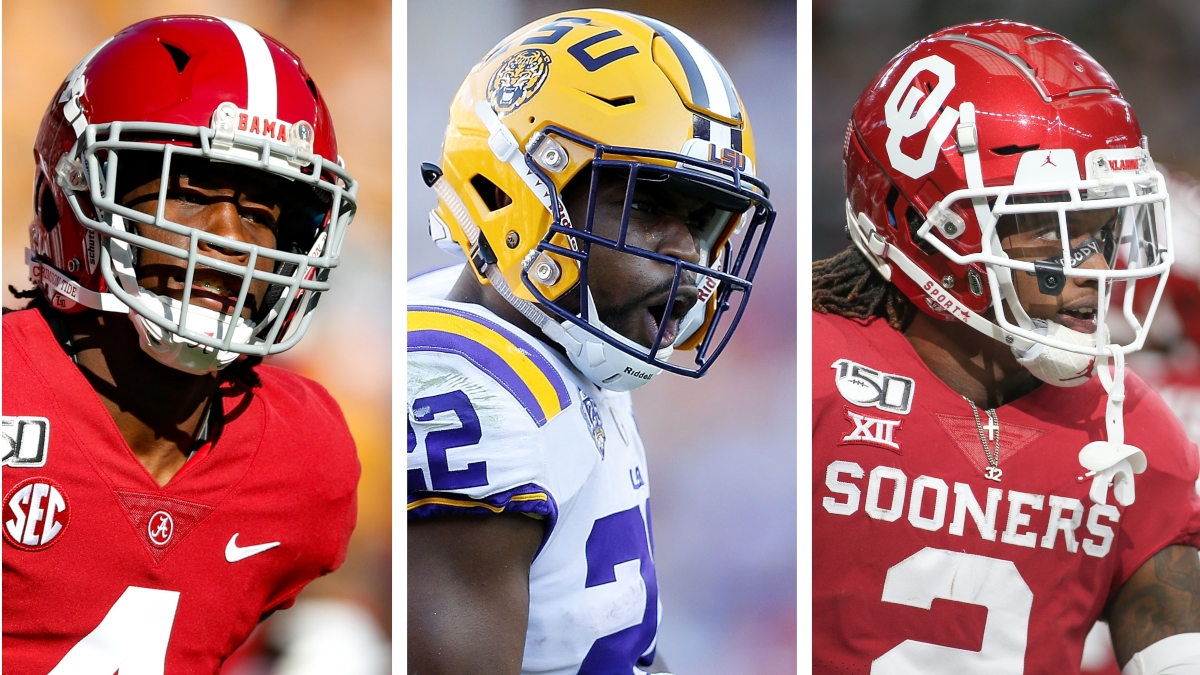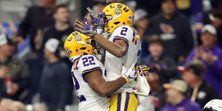2020 Dynasty Rookie Rankings: Your Fantasy Draft Guide to the Top 50
Getty Images. Pictured: Jerry Jeudy, Clyde Edwards-Helaire, CeeDee Lamb
- Matthew Freedman reveals his 2020 dynasty rookie rankings -- your comprehensive draft guide to the top 50 players.
UPDATE (Aug. 16): I have made some slight adjustments to the rankings. Most notably, Tua Tagovailoa and Darrynton Evans have been bumped up a tier. I've also dropped some Day 3 wide receivers down a tier: I was simply way too high on them in the aftermath of the NFL draft.
UPDATE (Aug. 7): These rankings have held up remarkably well over the past three months, but in the wake of the Derrius Guice release, I absolutely must update them. Antonio Gibson has been moved up significantly, and other changes have also been made. I call attention to updated rankings where I think necessary.
With the 2020 NFL Draft in the books, it’s time to update my rookie dynasty fantasy football rankings.
Here are the previous versions my rankings.
In creating these rankings, I’ve focused on draft capital, college production, physical profile, recruitment grade, projected opportunity and team fit.
A word on my player-by-player analysis: For the guys in Rounds 1-2, I've written extensive notes. For most of the prospects in Rounds 3 and beyond, I'm less verbose. Let's be honest: Most of the guys after Round 2 won't be relevant in three years anyway.
Before we dig into the rankings, let’s run through my overall process.
Pre- vs. Post-Draft Rookie Dynasty Rankings
There are a few significant changes from my latest version. For instance, Clyde Edwards-Helaire is now my No. 1 player, whereas before the draft I had him ranked No. 17. That's a massive move! I had expected him to go in Rounds 2-3, but he went in Round 1 and landed in a fantastic long-term situation with the Kansas City Chiefs.
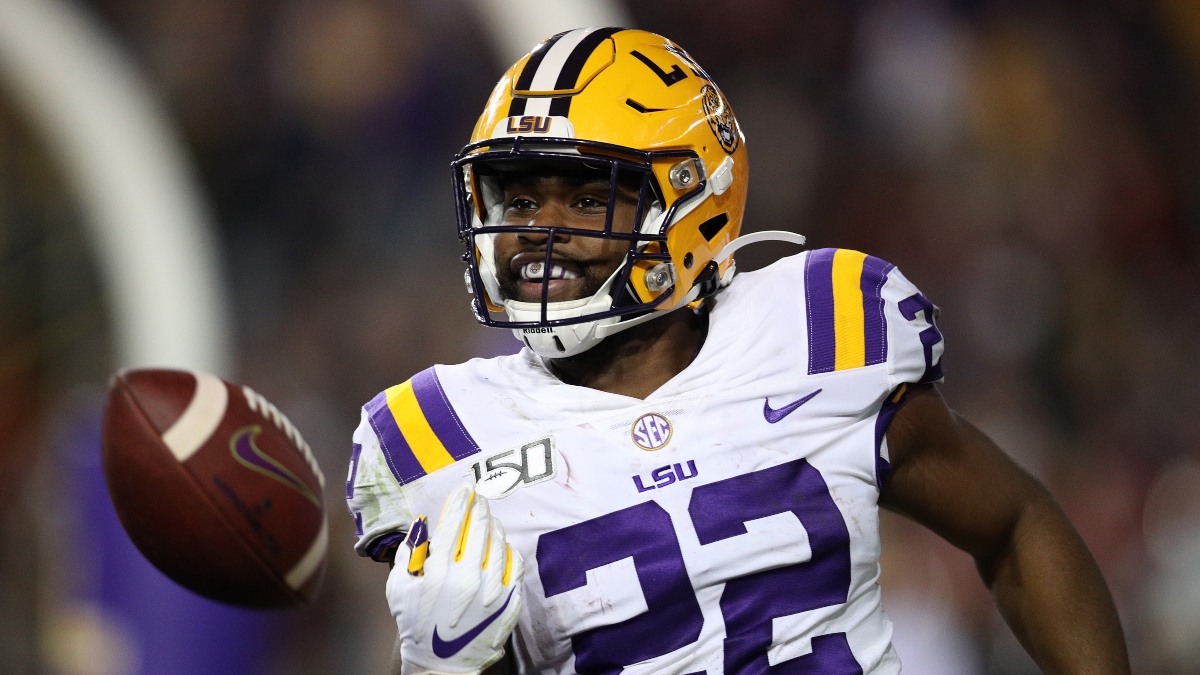
But for the most part, there aren't many big changes between the pre- and post-draft rankings, because most of my draft position projections were relatively accurate, which means that most of the factors that go into my model were already set.
You might ask: "What about landing spot?"
The tetrad of college production, physical profile, recruitment grade and draft position mean more than our initial perceptions of a guy’s early-career circumstances.
It’s not hard for us to know — to quantify — a guy’s college production, physical profile, recruitment grade and draft position. We can put exact numbers to each category. And once those numbers are in place, they never change.
But we’re not very good, especially shortly after the draft, at evaluating a guy’s landing spot and projecting the usage he’s likely to have with his team. That’s something we just can’t know.
And yet that seems to be what most people focus on immediately after the draft.
Example: Last year, people were way too low on wide receiver A.J. Brown because they focused more on the fact that we expected him to play with quarterback Marcus Mariota and behind wide receiver Corey Davis than on all the other factors that matter.
- College production: Back-to-back 1,200-yard seasons in the SEC
- Physical profile: 6-foot and 226 pounds, 4.49-second 40-yard dash, 22 years old
- Recruitment grade: 4 stars
- Draft position: Round 2, pick No. 51
We’re not great at evaluating circumstances anyway — and circumstances can and often do change. So there are a few really big changes in these rankings, but because my draft position projections were relatively good, there are also a lot of similarities.
Dynasty Rankings Methodology
Here are some general notes on my ranking process and perspective.
- Age: I place a premium on youth, which correlates with longevity and degree of future production. As a result, I tend to have younger players ranked ahead of older players: The younger players have more long-term upside.
- Production window: In creating the rankings, I’ve focused most on the production we can reasonably expect from players within the next three years. After that time frame, projections are highly uncertain, although I still value the unknown long-tailed potential younger players possess.
- Positional scarcity: I tend to devalue players at positions of depth. As a result, quarterbacks are usually low in my rankings because there are so many viable options at the position.
- Longevity: Everything else equal, I usually rank wide receivers ahead of running backs because receivers as a group last longer in the league and maintain value deeper into their careers.
- Draft position: In general, the higher a player is selected in the draft, the more productive he's likely to be in the NFL. I don't let draft position dictate my entire process, but if rank contrary to draft position, I need to have a good reason for doing so.
Positional Value in Rookie Dynasty Rankings
In dynasty, it's hard to build a consistent contender if you aren't strong at wide receiver and tight end. Patching together production is much easier to do at running back and quarterback, and that knowledge informs the way I rank players, draft rookies and build teams.
I place a high priority on finding wide receivers and tight ends with difference-making potential. Players at these positions take longer to develop than running backs, which is unfortunate, but sharp dynasty investors can use that fact to their advantage.
In search of immediate alpha, too many people take running backs early in rookie drafts. In doing so, they not only buy into volatile short-lived assets but also allow value-seeking patient investors to acquire stable long-term production at a notable discount.
Each year, there are dynasty players who crave the sugar rush of running backs taken on Day 2, and so they forego the protein of wide receivers selected in Rounds 1-2.
In the long run, such dynasty players lose.
But each year is different, and each draft is its own unique market. This year's class has notable features for each position. Let's run through each.
Quarterback
Each year, we get two to three quarterbacks who are likely to start in the NFL as either rookies or second-year players, and that's the case here with Joe Burrow, Tua Tagovailoa and Justin Herbert.
What's different about this class is that it has two quarterbacks — Jordan Love and Jalen Hurts — who are viable long-terms stashes. They both carry significant NFL draft capital, but neither is likely to see extended playing time for maybe three-plus seasons.
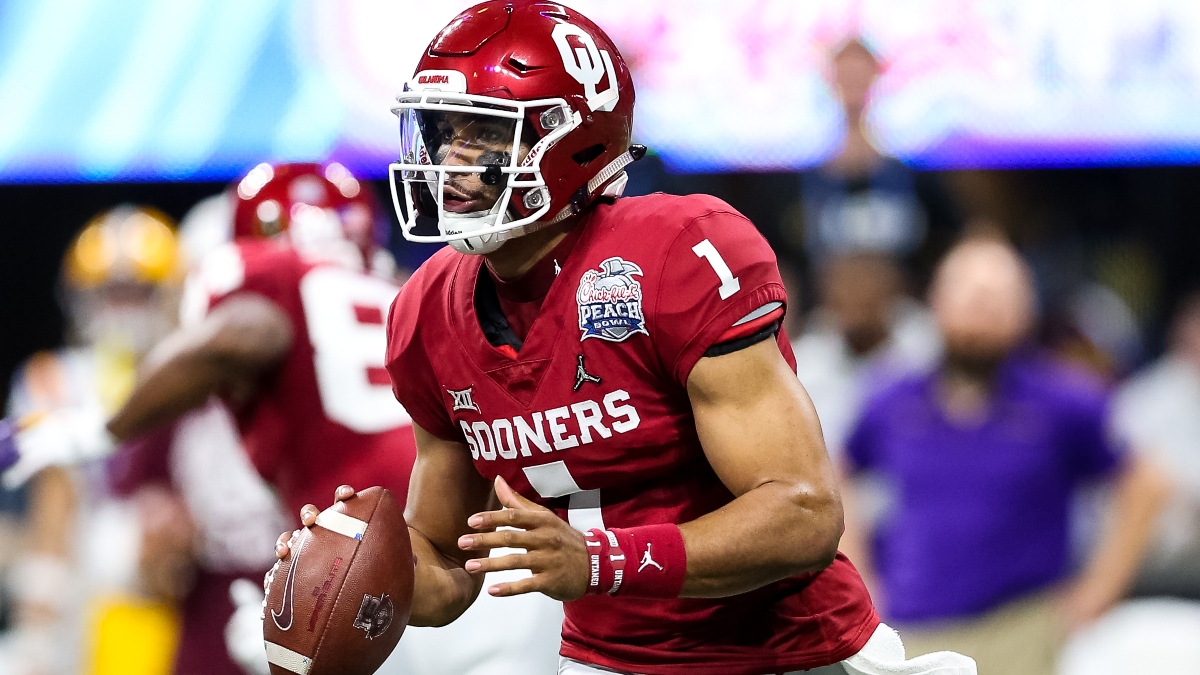
Normally, I think long-term quarterback stashes make little sense, because most of these players have almost no draft capital. Examples from this year are Jacob Eason and Jake Fromm, who were respectively selected in Rounds 4 and 5.
Because of Love and Hurts, this class might actually have some late-round quarterback stashes who are investable.
Running Back
The top-five backs in this class stack up well against the top five from any other class, but after them, there's a lot of uncertainty. The 2020 class has a disheartening dearth of backfield depth: In Rounds 5-7, just three backs were selected.
If you want a running back with a decent chance of being a long-term lead back, you'll almost certainly need to draft him in Round 1.
Wide Receiver
Many analysts think 2020 has the greatest wide receiver class of all time. I'm less certain about that, but it definitely is deep. Even in Round 3 of rookie drafts, sharp dynasty investors have a shot at getting talented receivers.
Tight End
Tight ends are notoriously hard to project to the NFL and slow to develop anyway, and entering the draft, this year's group looked decidedly subpar.
But five players were drafted in Rounds 2-3. Albert Okwuegbunam and Harrison Bryant still intrigue even though they slipped to Round 4. And in this class, we have three 21-year-old rookies, and such players have historically been prized long-term investments.
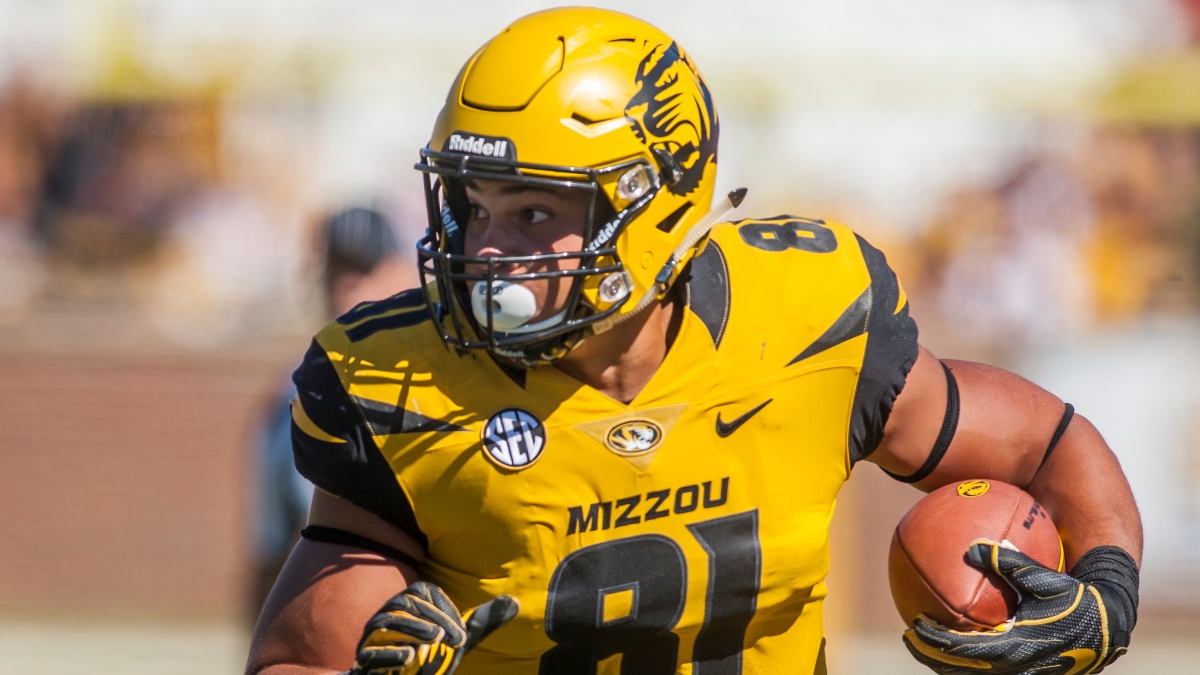
I'm cautiously beginning to think that this year's tight ends will be better than expected.
Positional Priorities by Round
Given the particulars of this class, I think dynasty investors should prioritize positions in the following fashion (subject to team needs, league format, etc.).
- Round 1: RBs and WRs. Even though I value receivers, especially young ones, backs should be prioritized early in Round 1 because quality receivers will be available with subsequent picks. Later in Round 1, investors should shift to wide receivers.
- Round 2: WRs. This round is likely to offer tremendous value at wide receiver.
- Round 3: WRs, TEs and QBs. A few promising receivers are available here, as well as some upside tight ends, although you'll need to wait multiple years for them to develop. If you require a shorter time horizon, quarterback is a reasonable option.
2020 Rookies: Supplemental Draft Picks
Before the draft, I broke down my pre-draft rookie rankings on Twitch with Ryan McDowell, Rich Hribar and Curtis Patrick.
On the show, Ryan brought up the possibility that some of the eligible prospects who decided not to declare for the draft in January might choose to enter the supplemental draft in July if it looks like the 2020 college football season will be canceled due to the coronavirus.
If that happens, a number of strong underclassmen could suddenly join the 2020 rookie class, possibly including:
- RB Travis Etienne (Clemson): 2,046 yards, 23 touchdowns (2019)
- RB Chuba Hubbard (Oklahoma State): 2,292 yards, 21 touchdowns (2019)
- RB Najee Harris (Alabama): 1,528 yards, 20 touchdowns (2019)
- RB Kylin Hill (Mississippi State): 1,530 yards, 11 touchdowns (2019)
- WR DeVonta Smith (Alabama): 1,256 yards, 14 touchdowns (2019)
- WR Tylan Wallace (Oklahoma State): 903 yards, 8 touchdowns (9 games, 2019)
- WR Sage Surratt (Wake Forest): 1,001 yards, 11 touchdowns (9 games, 2019)
If these players had declared for the draft in January, all of them might have been top-100 picks in the NFL draft. And if they actually do enter the supplemental draft, they would likely be selected in Rounds 1-2 for dynasty rookie drafts that held later in the summer.
By the fall, the 2020 rookie class could be a lot bigger than it is now — and the 2021 class might be a lot less promising.
Be sure to monitor this situation and plan accordingly.
Rookie Rankings Resources
Here are some of the resources I've used in researching the 2020 rookie class.
- Prospect Profiles From NFL Media's Lance Zierlein (Zierlein)
- 2020 Sports Info Solutions Football Rookie Handbook (SIS)
- Pro Football Focus 2020 NFL Draft Guide (PFF)
- RotoViz NFL Prospect Box Score Scout (RV)
- RotoViz NFL Combine Explorer (RV)
- NFL Combine Database (NFL)
- MockDraftable (MD)
- PlayerProfiler (PP)
2020 Dynasty Rookie Rankings
TIER 1
1. Clyde Edwards-Helaire, RB, Chiefs
- Draft Position: 1.32 | School: LSU
- Height: 5’7” | Weight: 207 pounds
- 40-yard dash: 4.60 seconds
- 2020 Age: 21 | Class: Junior
- Recruitment Stars: 3-4
UPDATE (Aug. 7): Edwards-Helaire is all the more valuable now that Damien Williams has opted out of the 2020 season due to the coronavirus. He could be a top-three dynasty pick in startup drafts next year and is the no-doubt No. 1 pick.
I expected Edwards-Helaire to be drafted on Day 2, so I had him in Round 2 of my post-free agency rankings.
But I also directly compared him to Brian Westbrook and said this about him.
Given his projected draft position, college production, age and top-tier receiving ability, Edwards-Helaire is likely to have multiple 1,000-yard NFL campaigns as an Austin Ekeler-esque multidimensional contributor.
And now that Edwards-Helaire has Round 1 draft capital, I'm taking my earlier statement and multiplying it by 2.5.
I'm all the way in on CEH.
Andy Reid won a Super Bowl in February and just drafted the second coming of Brian Westbrook.
He's in full Keith Hernandez mode right now.
— Matthew Freedman (@MattFtheOracle) April 24, 2020
Clyde Edwards-Helaire to win Offensive Rookie of the Year.
+2500 via @BetMGM.
Booked.
Get it: https://t.co/4KHbpD4mKd
— Matthew Freedman (@MattFtheOracle) April 24, 2020
I probably wouldn't draft Edwards-Helaire as a top-12 back in 2020, but I wouldn't be surprised if he were one by the end of the season.
Whether his breakout comes in 2020 or 2021, make no mistake — Edwards-Helaire is going to ball in the NFL, and that's a somewhat unbelievable statement to make given how slow he is.
I can probably run faster than Edwards-Helaire. Well, maybe not me. But I bet Jonathan Bales could.
Speed is not the name of his game. Based on his combine performance, CEH has a 36th-percentile 92.5 speed score (per PP). He's not the kind of back who outruns defenders for long touchdowns.
But he's still a good runner. He has above-average vision and makes sharp cuts. He runs with power and breaks tackles thanks to his bowling bowl-like compact frame. And despite his lack of speed, he is still remarkably explosive, as evidenced by his 39.5- and 123-inch vertical and broad jumps and 89th-percentile 128.7 burst score.
Even with his diminutive size and subpar speed, Edwards-Helaire in 2019 compared favorably as a runner to the other top backs in the class, based on his expected points added per attempt (EPA, per SIS).
- Clyde Edwards-Elaire: 0.20
- J.K. Dobbins: 0.17
- Jonathan Taylor: 0.10
- A.J. Dillon: 0.07
- D'Andre Swift: 0.05
- Cam Akers: -0.03
On top of that, Edwards-Helaire might be the best pass-catching back in the class. He certainly gives Swift a run for his money.
Although Swift has the tactical edge on CEH in that he can run a full, nuanced route tree, Edwards-Helaire is a master at turning checkdowns and screens into first downs and big plays.
And it's not as if CEH is a single-dimensional receiver: He lined up as a receiver on an astounding 21% of his snaps, more than any other back in the class with the the exception of running back/slot receiver hybrid Antonio Gibson (per SIS).
With his 55-453-1 receiving line, Edwards-Helaire last year had an impressive 0.20 expected points added per target. In Kansas City, he figures to be used immediately as a Danny Woodhead-esque pass-catching threat at the absolute worst.
Essentially, CEH is a complete player: "Not only was he the most valuable running back in college football in PFF’s wins above average, but he was the 13th-most valuable player regardless of position and third-most valuable non-quarterback" (per PFF).
Dude can ball.
The extent to which this information is relevant is uncertain, but it's at least notable that Edwards-Helaire hails from a program that has produced numerous fantasy-relevant backs over the past 25 years.
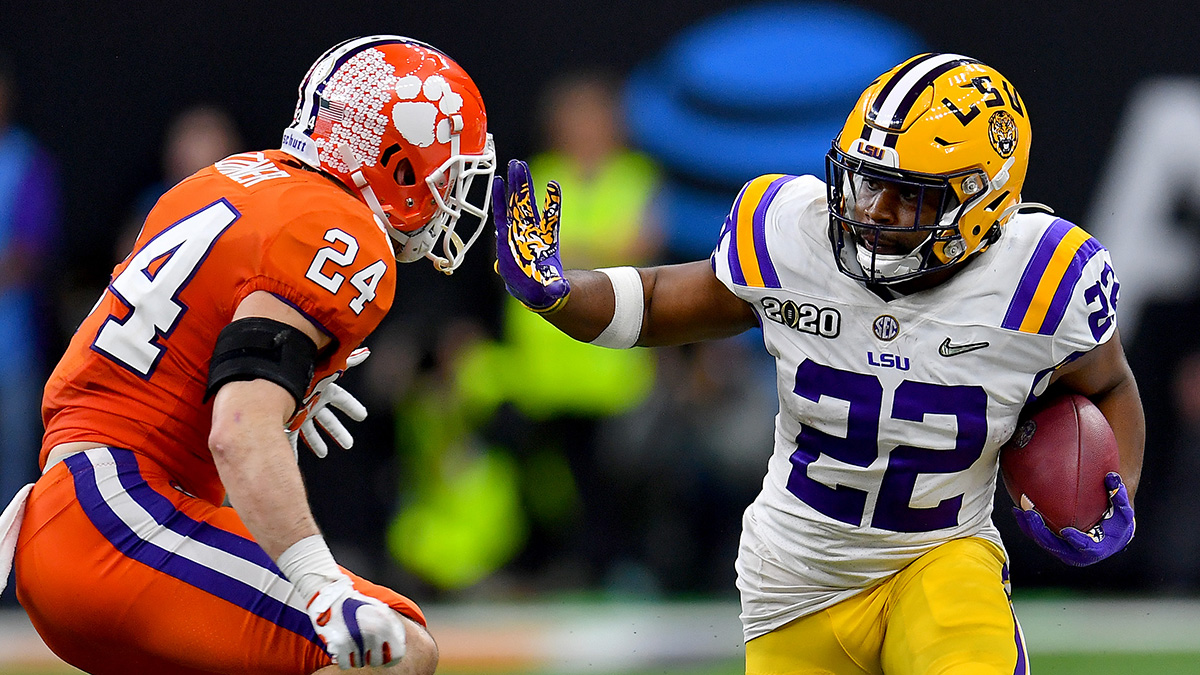
Here are all the LSU running backs to enter the NFL since 1995 as fourth-rounders or better. (Apologies, to Jacob Hester, who was more of a fullback than true running back.)
- Kevin Faulk (1999, 2.46): Two 1,000-yard seasons
- Domanick Williams (2003, 4.101): Three 1,300-yard seasons
- LaBrandon Toefield (2003, 4.132): Nada
- Joseph Addai (2006, 1.30): Two 1,400-yard seasons
- Stevan Ridley (2011, 3.73): One 1,300-yard season
- Jeremy Hill (2014, 2.55): Two 1,000-yard seasons
- Leonard Fournette (2017, 1.04): Two 1,300-yard seasons
- Derrius Guice (2018, 2.59): Waiting
But with CEH here's what really matters: He's a 21-year-old first-rounder. That's it. Not all of the 21-year-old first-round backs to enter the league over the past two decades have become stars, but with the exception of guys whose careers ended prematurely because of random injuries or criminality — David Wilson, Jahvid Best and Lawrence Phillips — all of them have had multiple seasons of fantasy utility.
And a lot of them became stars.
In the previous five drafts, five 21-year-old rookies have been selected in Round 1.
- Josh Jacobs (2019, 1.24): One 1,000-yard season
- Saquon Barkley (2018, 1.02): Two 1,000-yard seasons
- Christian McCaffrey (2017, 1.08): Three 1,000-yard seasons
- Ezekiel Elliot (2016, 1.04): Four 1,000-yard seasons
- Todd Gurley (2015, 1.10): Five 1,000-yard seasons
Each guy has had at least 1,000 yards in literally every season of his career.
How many scrimmage yards do you think CEH will have in 2020?
From Duce Staley (1999-2003) and Brian Westbrook (2002-09) and LeSean McCoy (2009-12) with the Philadelphia Eagles, to Jamaal Charles (2013-15) and Spencer Ware (2016) and Kareem Hunt (2017-18) and Damien Williams (2018-19) with the Chiefs, head coach Andy Reid knows how to get the most out of pass-catching backs.
And when he's drafted a receiving savant with a high pick — think of McCoy in 2009 and Hunt in 2017 — Reid has put that guy to work pretty quickly, even if an incumbent has already been in place.
And with all respect to Damien Williams, he's hardly an incumbent. He's a 28-year-old journeyman who entered the league as an undrafted free agent, has never started more than six games in the regular season and last year had double-digit carries for just the first time in his career.
He's on a one-year contract.
Sooner or later, Edwards-Helaire will be Patrick Mahomes' lead back, and I'm betting on sooner.
Some sharp rankers prefer running back Jonathan Taylor as the top pick, but …
There will be debates about rookie pick 1.01 given Clyde Edwards-Helaire and Jonathan Taylor’s landing spots. Easy tiebreaker for me is that one will be playing with Patrick Mahomes his whole career, while the other gets the corpse of Philip Rivers and then an unknown.
— JJ Zachariason (@LateRoundQB) April 25, 2020
… I disrespectfully disagree. They're wrong.
In 2009, not one dynasty analyst had LeSean McCoy ranked as the 1.01 — but I drafted him with the No. 1 pick anyway. I was right then, and I'm right now.
Edwards-Helaire should be the top pick in all rookie drafts.
NFL Prospect Comp: Brian Westbrook with more youth, thickness and draft capital but less production
2. Cam Akers, RB, Rams
- Draft Position: 2.52 | School: Florida State
- Height: 5’10” | Weight: 217 pounds
- 40-yard dash: 4.47 seconds
- 2020 Age: 21 | Class: Junior
- Recruitment Stars: 5
Yep, I'm going there.
I'm pretty sure every other dynasty analyst in the industry has Taylor as a top-two pick.
Bohr-ah-ring.
I think it's almost a tossup between Akers and Taylor for the No. 2 pick, but I lean ever so slightly toward Akers. And I've of course bet on Akers at +5000 to be the 2020 Offensive Rookie of the Year. He might already be a top-12 fantasy back.
If you check out the RV Combine Explorer, you'll see that a high percentage of the 20 players to whom Akers is most physically comparable as a prospect — 50% of the backs, in fact — averaged at least 10 fantasy points per game in their first three seasons.
Included in that list are Hall-of-Famers LaDainian Tomlinson and Marshawn Lynch and 2019 top-three pick Miles Sanders.
And the RV Combine Explorer looks only at physical profile: It doesn't even take into account Akers' age, production, recruitment grade or draft position.
Entering the NFL draft, I had Akers lower in my rookie rankings, but that was simply because I value wide receivers significantly more than running backs in dynasty. In terms of my overall outlook for Akers — what I expect him to do in the league — I might be the most bullish person in the industry.
I expect him to crush. Absolutely crush.
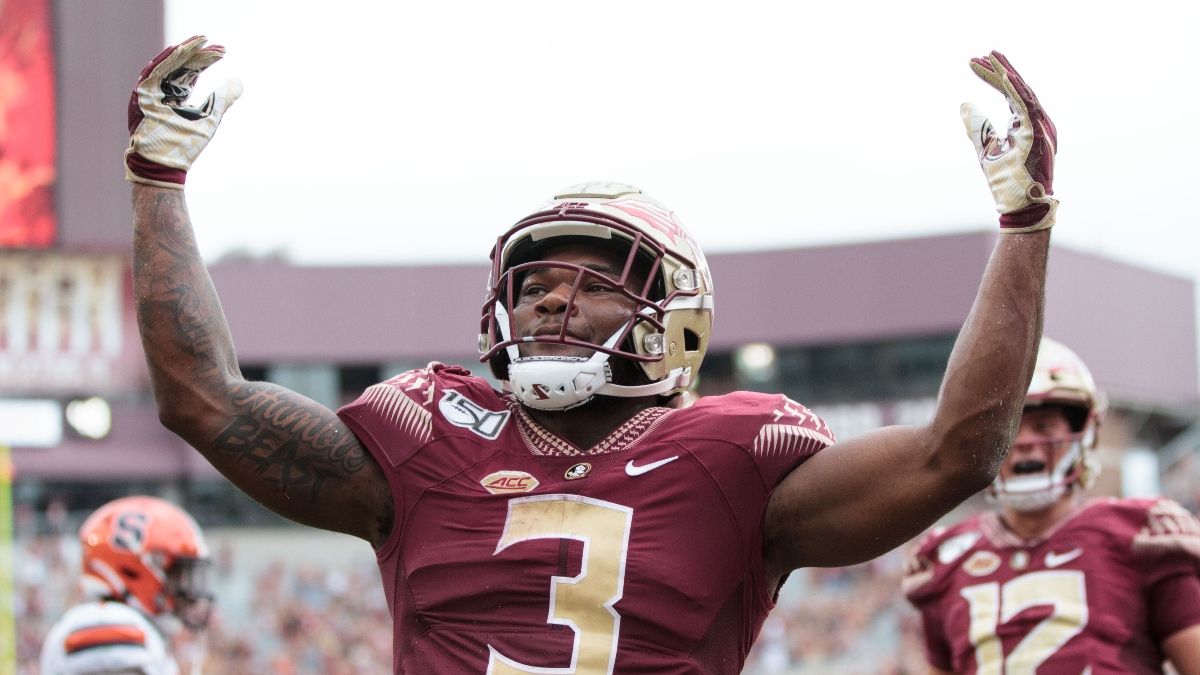
He entered college as a top-five overall recruit and a five-star all-purpose championship-winning quarterback who passed for 3,128 yards and 31 touchdowns and rushed for 2,105 yards and 34 touchdowns as a high-school senior, and in his three years as a starting running back in college, he did nothing to suggest that the evaluation people had of him as a recruit was wrong or that he won't be able to play in the NFL.
The average college football fan probably thinks that Akers is overrated. And it's true that he never had an overwhelmingly dominant season. But that's not entirely his fault, given that he ran "behind one of college football’s worst offensive lines over the past few seasons" (per PFF). To be exact, the fourth-worst Power Five run blocking unit.
As a point of comparison, some of the other top backs in the class had significant better blocking from their offensive lines in 2019.
- De'Andre Swift (Georgia): 1st
- Jonathan Taylor (Wisconsin): 6th
- Clyde Edwards-Helaire (LSU): 14th
That Akers was productive at all is a minor miracle — and he was productive. Even though he never had a full-on in-your-face campaign, in 2017 he broke Dalvin Cook's FSU rushing record for a freshman, and in 2019 he returned to form after a down sophomore campaign.
- 2017: 194-1,015-7 rushing, 16-116-1 receiving in 13 games
- 2018: 161-706-6 rushing, 23-145-2 receiving in 12 games
- 2019: 132-1,144-14 rushing, 30-225-4 receiving in 11 games
And, in 2019, Akers averaged over 100 yards rushing per game "while facing contact at or behind the line of scrimmage at the highest rate of any FBS back in the country" (per PFF).
Akers is a smooth runner, functional receiver and strong pass protector: In 324 pass-blocking snaps, he allowed only 15 pressures. And it doesn't hurt that in college he was 5-of-8 passing for 97 yards.
Akers' over/under for career Tomlinson-esque halfback touchdown passes in the NFL? I'm setting it at 1.5.
Over the past 25 years, there have been five 21-year-old second- and third-round rookie running backs to play at 210-plus pounds and have multiple 1,000-yard seasons in college.
Here's how they've done in the NFL.
- Ahman Green (1998, 3.76): Six 1,000-yard seasons
- Bernard Pierce (2012, 3.84): Nada
- Le'Veon Bell (2013, 2.48): Five 1,000-yard seasons
- Joe Mixon (2017, 2.48): Two 1,000-yard seasons
- Alexander Mattison (2019, 3.102): Waiting
Akers might be Pierce 2.0, but I think it's likelier he's a premium version of Green.
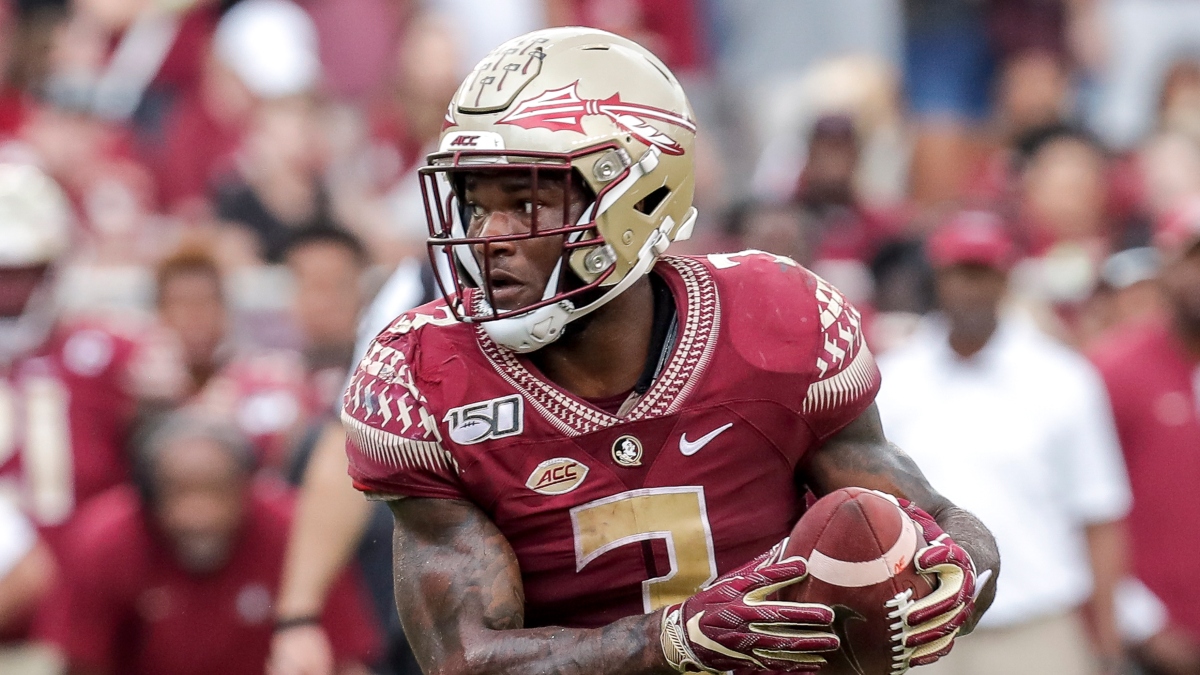
Dynasty investors might question Akers' ability as a receiver. It's true that he's not one of the best pass-catching backs in the class. But I think he's better than Taylor. Per SIS:
In the pass game, he shows that he can make an impact. He mostly ran screens, swings and flat routes out of the backfield, but showed that he has the quick feet to be a good route runner on others as well. While he doesn't possess natural hands and makes some focus drops, he can make most catches on balls thrown his way. With the ball in his hands, he is able to make defenders miss and create yards after the catch.
As a receiver, he's good enough.
Dynasty investors also might have questions about his landing spot. Last year the Rams were just No. 26 with a 53.0 PFF run-blocking grade, and they scored only 24.6 points per game after putting up 32.9 the year prior.
I'm not worried. The Rams have been a top-12 scoring team in each year of head coach Sean McVay's tenure, and I think that many of their offensive problems last season were a result of their reliance on running back Todd Gurley, who is now gone.
But in Gurley's two pre-2019 seasons with McVay — before he developed his stuck-in-molasses running style — he was an All-Pro producer.
- 2017 (15 games): 279-1,305-13 rushing, 64-788-6 receiving on 87 targets
- 2018 (14 games): 256-1,251-17 rushing, 59-580-4 receiving on 81 targets
Even if Akers isn't a great receiver, he still seems likely to get a decent number of targets if he's the lead back — and even though the Rams drafted Darrell Henderson last year with the No. 70 pick — it's hard to imagine that Akers won't dominate touches given his draft capital and overall talent.
With Gurley's departure, the Rams entered the draft with a league-high 216.5 vacated expected points at the running back position. In terms of opportunity, Akers might have landed in the best spot possible.
The Rams will need to give the ball to someone in the backfield, and Akers is a prime candidate. Starting in Week 1, he could get 15-plus touches per game. I'm not sure we can say the same for Taylor.
If you're nervous about Akers, that's fine. You're free to take Taylor, who is a perfectly good option at No. 2. But I prefer Akers. They're both big-bodied 21-year-old second-rounders with above-average athleticism and top-tier running skills, but Akers (I expect) will have more opportunities right away and is a marginally better receiver.
NFL Prospect Comp: Marshawn Lynch with less draft capital
3. Jonathan Taylor, RB, Colts
- Draft Position: 2.41 | School: Wisconsin
- Height: 5’10” | Weight: 226 pounds
- 40-yard dash: 4.39 seconds
- 2020 Age: 21 | Class: Junior
- Recruitment Stars: 3
Taylor was the No. 2 player on my board before the draft. That was a simpler time.
His landing spot is good: The Colts were No. 2 last year with an 85.1 PFF run-blocking grade. But Taylor is not a great receiving back, and as a rookie he seems likely to be in an unfortunate timeshare with running backs Marlon Mack and Nyheim Hines.
True, Taylor should still lead the backfield in 2020, as Mack is in the final year of his contract and Hines is just a pass-catching complement. And in 2021 he will probably be a locked-in high-volume dominator.
But I still can't put him above Edwards-Helaire or Akers. Despite his athletic brilliance and collegiate dominance, Taylor has his limitations, especially as a receiver. Per SIS:
His contributions on [passing] downs were essentially nonexistent his first two years and while that has increased this season, his traits need further development. His catching skills are average for a running back and his route running needs refinement to be more than a checkdown option, but he's still an electric athlete with the ball in his hands. He profiles as a linebacker mismatch if he can improve in this area.
Even though as a junior he had a respectable-looking receiving stat line — 26 receptions for 252 yards and five touchdowns — Taylor is a net negative in the passing game.
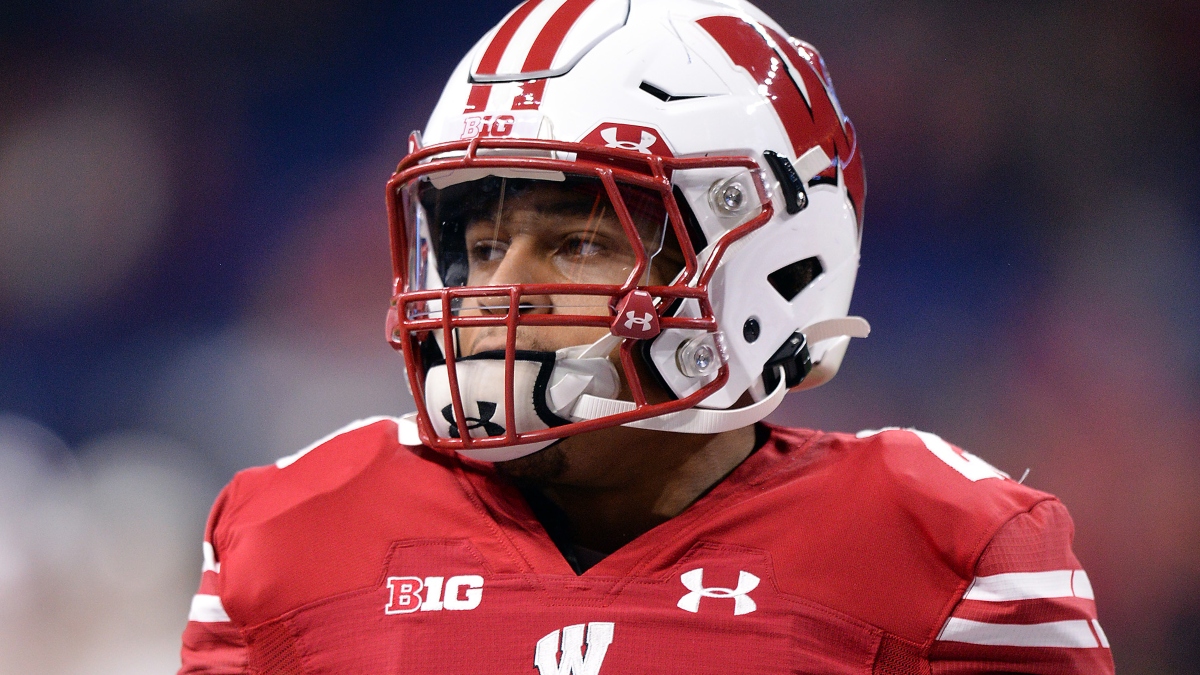
At best, he's mediocre as a receiver. He doesn't run routes. He just sort of runs to where he thinks the ball might be thrown. He can't be lined up across the formation: He's a backfield-only back. And when it comes to catching the ball, his hands might as well be elbows: On 50 catchable targets for his career, he had eight drops. On passes he should have snagged — passes that were primarily dump-offs — he had a 16% drop rate.
Not even the least reception-inclined early-down backs in the NFL have drop rates that bad.
His career receiving numbers are horrendous for a guy who was on the field for the supermajority of snaps for three straight years.
- Receptions per game: 1.0
- Yards per target: 6.1
- Catch rate: 64.5%
Every once in a while, a guy who doesn't catch the ball in college does so in the NFL. It happened with LaDainian Tomlinson — but LT is probably an exception. Almost no one compares to him. It would be foolhardy to think that any given prospect would have a career as distinguished as Tomlinson's.
And yet Tomlinson — as unbelievable as this sounds — actually is the guy to whom Taylor is most comparable as a prospect. With his elite athletic profile and college production, Taylor has an incredibly high floor.
As much as I'm dogging on him as a receiver, I fully acknowledge that Taylor is an impressive player.
PFF has Taylor ranked as the best between-the-tackles runner in the class. He's a magnificent runner. He glides.
A two-time Doak Walker Award winner as the top back in the country and a two-time consensus All-American selection, Taylor had three straight seasons of 2,000-plus scrimmage yards in college. Based on his production, he looks like the kind of historical back who would be taken high in the draft, maybe even in the top 10.
Jonathan Taylor's profile is that of a running back who would typically go top-5 overall
You can make the argument – easily in fact – that he had the greatest career of any running back in NCAA history
And yet, most experts don't even have him as the top back in this class pic.twitter.com/VezFrusf4J
— Scott Barrett (@ScottBarrettDFB) April 16, 2020
Taylor's production — especially his rushing production — is the stuff of legends.
- 2017 (14 games): 299-1,977-13 rushing
- 2018 (13 games): 307-2,194-16 rushing
- 2019 (14 games): 320-2,003-21 rushing
Based on a combination of his PFF rushing and receiving grades, missed tackles per carry, yards after contact per attempt and yards per route run, Taylor is the No. 2 backfield prospect from the 2017-20 draft classes.
Top 10 in Average Ranking:
Zack Moss* – 2.5!🧐
Jonathan Taylor* – 7.75
Darrell Henderson – 8.25
Dalvin Cook – 8.75
Joe Mixon – 11.75
Kareem Hunt – 12
Josh Jacobs – 13
Rashaad Penny – 14.5
AJ Dillon* – 15.5
Saquon Barkley – 16.5* = 2020 RB Class
# = Average ranking per metric— Michelle Magdziuk (@BallBlastEm) April 17, 2020
Now, I don't think Taylor is actually the No. 2 running back prospect from the past four years — and I definitely don't believe that Zach Moss is the No. 1 back — but pretty much any back-of-the-envelope calculation will point to this fact: Taylor is a good football player.
He's going to see heavy volume in the NFL.
If you take Taylor with a top-two pick, I can't blame you. I have doubts about his ability to finish consistently in the top 10 in PPR scoring because of his pass-catching shortcomings, but his rushing ability makes him a near certainty to have multiple top-20 campaigns.
NFL Prospect Comp: LaDainian Tomlinson with significantly worse hands and less draft capital — but also younger
4. Jerry Jeudy, WR, Broncos
- Draft Position: 1.15 | School: Alabama
- Height: 6'1" | Weight: 193 pounds
- 40-yard dash: 4.45 seconds
- 2020 Age: 21 | Class: Junior
- Recruitment Stars: 4-5
Jeudy to the Denver Broncos at No. 15 is one of the picks I got right in my final mock draft, and I like the fit.
Jeudy is more of a high-end No. 2 receiver than a "show me the money" No. 1 dominator, and in Denver, he'll get to play a complementary role alongside 2019 breakout receiver Courtland Sutton.
But just because he's a No. 2 option doesn't mean that he has diminished fantasy value. While Sutton commands defensive attention, Jeudy will be able to exploit softer matchups all across the formation thanks to his positional versatility.
Whatever targets you think wide receiver Emmanuel Sanders would get if he were still on the Broncos, you should probably assign most of those to Jeudy. He's basically a Sanders replacement, and in the post-Peyton Manning era in Denver, Sanders averaged 7.9 targets per game.
There are targets available on the Broncos. And of the six Round 1 wide receivers, Jeudy could have the highest market share of 2020 targets.
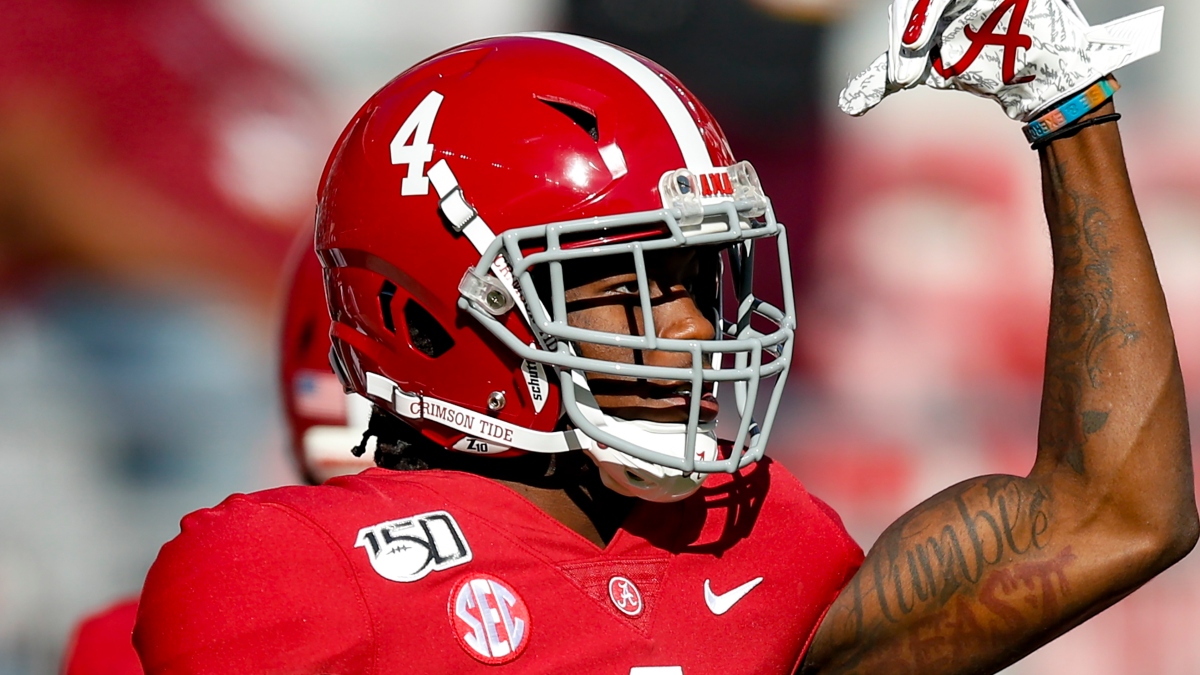
Like most rookie receivers, Jeudy might struggle early: Because of the coronavirus, it will probably be hard for him to pick up the offense and create chemistry with second-year quarterback Drew Lock, who isn't the most accurate of passers anyway.
But Jeudy will eventually find his groove, and I like him for the long term.
For most dynasty investors, the No. 1 wide receiver in the 2020 class is probably either Jeudy or CeeDee Lamb (Oklahoma). Most of the sharp rankers I know prefer Lamb, who is bigger (6-foot-2 and 198 pounds vs. 6-foot-1 and 193) and more explosive (124-inch broad jump vs. 120) and was more productive in college.
- CeeDee Lamb (2018-19, 27 games): 127-2,485-25 receiving, 14.0 yards per target
- Jerry Jeudy (2018-19, 28 games): 145-2,478-24 receiving, 11.9 yards per target
But I give the slight edge to Jeudy.
He's not much smaller than Lamb, but he's faster (4.45-second 40-yard dash vs. 4.50), and I think he's the more complete receiver. Lamb might have the higher ceiling, but Jeudy I expect has the higher floor.
Jeudy might never be an All-Pro producer, because he's not a classic No. 1 receiver. He's not a go-up-and-get-it dominator. But he does everything well. He’s a smooth route runner with good hands. He plays inside and outside. He can go deep and across the middle of the field. When he's faced press coverage, he's usually beaten it.
And he's unlikely to face lots of press coverage with the Broncos anyway: I expect he'll line up most in the slot with Sutton and second-rounder K.J. Hamler on the perimeter. Jeudy lined up in the slot on 68% of his snaps in 2018 and 58% in 2019 (per SIS). And going against slot cornerbacks, he could dominate.
The 2018-19 Alabama teams had four wide receivers who all got regular playing time and might eventually be selected in Round 1: Jeudy, Henry Ruggs III, Devonta Smith and Jaylen Waddle.
That Jeudy was able to put up back-to-back seasons of 1,000-plus yards and 10-plus touchdowns receiving while sharing snaps and targets with those three other players is nothing short of spectacular.
Although he isn't built like a No. 1 receiver, he carries himself like one. The dude is swagalicious.
Coming soon on Sundays. 👀@jerryjeudy | @AlabamaFTBLpic.twitter.com/8VNEJ605YR
— NFL Network (@nflnetwork) April 13, 2020
As the 2018 Fred Biletnikoff Award winner, Jeudy is in an elite cohort of past Biletnikoff winners to enter the league as first-round selections and play as 21-year-old rookies.
- Randy Moss (1998, 1.21): 10 seasons with 1,000-plus yards
- Larry Fitzgerald (2004, 1.03): Nine seasons with 1,000-plus yards
- Brandin Cooks (2014, 1.20): Four seasons with 1,000-plus yards
- Amari Cooper (2015, 1.04): Four seasons with 1,000-plus yards
A Cooks-sized receiver with a Cooper-esque skill set, Jeudy is unlikely to have a Moss/Fitz-caliber career, but he could be a reliable 1,000-yard producer for close to a decade.
NFL Prospect Comp: Calvin Ridley but younger and more productive
5. CeeDee Lamb, WR, Cowboys
- Draft Position: 1.17 | School: Oklahoma
- Height: 6’2” | Weight: 198 pounds
- 40-yard dash: 4.50 seconds
- 2020 Age: 21 | Class: Junior
- Recruitment Stars: 4
I still can't believe my Cowboys drafted Lamb.
CeeDee Lamb to the Cowboys.
I. Can. Not. Be. Lieve. It.
Dak Prescott QB1.
— Matthew Freedman (@MattFtheOracle) April 24, 2020
Nothing will ever make up for their decision not to draft Hall-of-Fame wide receiver Randy Moss in 1998 — but this is a start.
The Cowboys are going all in on offense, and I love it.
Playing alongside wide receivers Amari Cooper and Michael Gallup — both of whom had 1,000-plus yards last year — Lamb is going to face extremely soft coverage, and although it might seem as if he will struggle to compete with Cooper and Gallup for the ball, he should inherit many of the 166 targets vacated by wide receiver Randall Cobb and tight end Jason Witten.
Lamb will get his opportunities in the short term, and Michael Gallup is slated to be a free agent in a couple of seasons. I'm not worried about whether or how Lamb find production. It will find him.
I love the general advantageousness of his circumstances.
A first-team All-American selection, Lamb actually might be the best receiver in the class. It's pretty close to a 50/50 tossup between Jeudy and Lamb, who is the more aggressive player (13.2-yard average depth of target vs. 11), the more dynamic after-the-catch producer (11 yards after the catch per reception vs. 7.8) and, frankly, the tougher competitor (0.37 forced tackles per touch vs. 0.19).
On the football field, Lamb simply looks like the guy who is playing harder. He has a ferocity to him that every other receiver in this class lacks.
He plays receiver almost the way that Marshawn Lynch played running back: He's always in attack mode. When the ball is in the air, he attacks it. When the ball is in his hands, he attacks defenders. He doesn't seem capable of playing at anything less than full intensity.
Still, I have Jeudy ranked just ahead of him.
Lamb's fervor — his violence — gives me pause. Guys with his frame don't normally get away with the big-bodied bully routine in the NFL. If you want to be DeAndre Hopkins or Davante Adams, you probably need be built like them.
- DeAndre Hopkins: 6'1" and 214 pounds
- Davante Adams: 6'1" and 212 pounds
Instead, Lamb is nearly a doppelgänger for Tyler Boyd (6-foot-1 and 197 pounds).
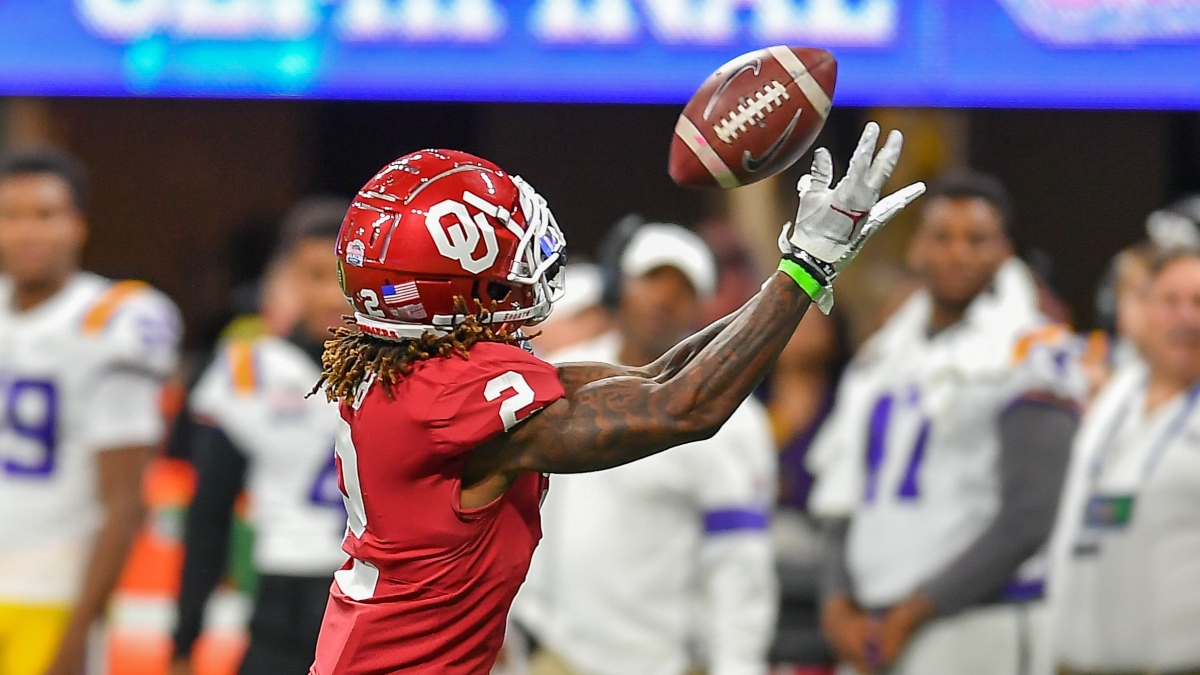
There aren't many receivers in the NFL with Lamb's thin frame — and not many of them have success. In most instances, they're unable to push around NFL cornerbacks. They lack the raw strength of their bully counterparts.
- DeAndre Hopkins: 15 bench press reps
- Davante Adams: 14 bench press reps
Last year, only two guys standing taller than 6-foot and weighing fewer than 200 pounds had 1,000 yards receiving: Boyd and D.J. Chark.
Boyd has taken the path previously trod by the similarly sized Brian Hartline (6-foot-2 and 195 pounds): Sure, he has back-to-back 1,000-yard seasons … but if the Bengals actually wanted the slot-bound player to be their No. 1 receiver, they wouldn't have franchised A.J. Green and drafted Tee Higgins with the No. 33 pick overall.
Much of Boyd's production over the past two years has come with Green on the sideline. Boyd, I suspect, is productive by default.
As for Chark, he has the speed (4.34-second 40-yard dash) of a small receiver and the strength (16 bench press reps) of a big receiver — and he's faster and stronger than Lamb (4.50, 11 reps).
None of this is to say that Lamb can't have NFL success. I find him excessively intriguing. Even as a true freshman, he had an impressive 44-807-7 receiving campaign on 68 targets at 18 years old despite playing behind John Mackey Award-winning tight end Mark Andrews and future first-round wide receiver Marquise Brown.
Lamb has always found a way to produce.
But in the NFL, I think his success will need to come as a polished route runner and climb-the-ladder receiver instead of an "I'm about to rough you up" dominator.
I know that people will say things like, "He'll just need to bulk up in the NFL." Yeah, maybe. But if he does, he'll lose speed, and I have actual doubts as to whether he'll be able to add more muscle. He's the kind of guy who just has a slight build. As a recruit, he was 172 pounds. That he put on 26 functional pounds in three years is amazing. But how much more weight can he reasonably put on?
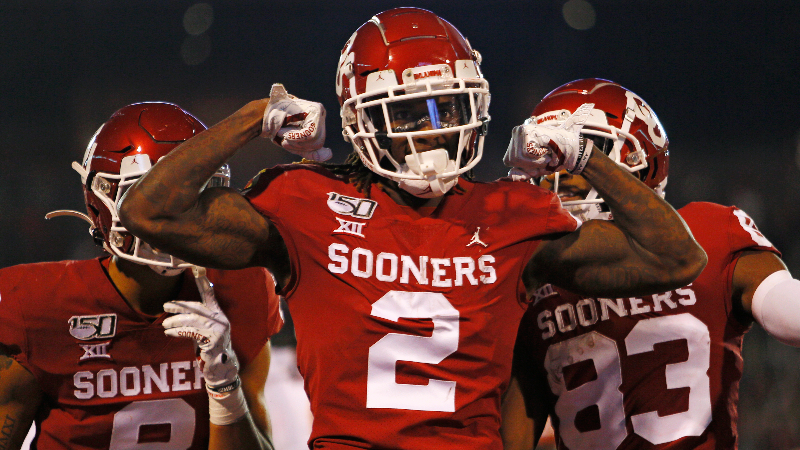
Basically, I'm saying he's not Nuk. He might have some Hopkins-esque elements to his game — but he's not Hopkins. Or at least he won't be in the NFL. I think he'll have success. He just won't get it in a total Nuk-like style.
I don't want this writeup to come across as a bunch of doom-and-gloom pessimism, because I love Lamb. I love him as much as weatherman Brick Tamland loves lamp.
He's a 21-year-old first-round receiver with multiple 1,000-yard seasons to his name.
There have been 11 such players over the past 30 years.
- Amari Cooper (2015, 1.04): Four seasons with 1,000-plus yards
- Sammy Watkins (2014, 1.04): One season with 1,000-plus yards
- Mike Evans (2014, 1.07): Six seasons with 1,000-plus yards
- Brandin Cooks (2014, 1.20): Four seasons with 1,000-plus yards
- Jeremy Maclin (2009, 1.19): Three seasons with 1,000-plus yards
- Percy Harvin (2009, 1.22): One season with 1,000-plus yards
- Kenny Britt (2009, 1.30): One season with 1,000-plus yards
- Mike Williams (2005, 1.10): LOL – the guy from USC
- Larry Fitzgerald (2004, 1.03): Nine seasons with 1,000-plus yards
- Reggie Williams (2004, 1.09): One season with 10-plus touchdowns
- Randy Moss (1998, 1.21): 10 seasons with 1,000-plus yards
The odds are pretty good that Lamb has multiple top-10 seasons in the NFL.
NFL Prospect Comp: DeVante Parker but smaller, slower and younger
TIER 2
6. Justin Jefferson, WR, Vikings
- Draft Position: 1.22 | School: LSU
- Height: 6’1” | Weight: 202 pounds
- 40-yard dash: 4.43 seconds
- 2020 Age: 21 | Class: Junior
- Recruitment Stars: 3
Jefferson makes a lot of sense in Minnesota. Drafted with the pick the Vikings received from the Buffalo Bills for Stefon Diggs, the versatile Jefferson will essentially be a one-for-one replacement for the traded wide receiver.
Athletically, they are very similar, given that they have comparable size, 40-yard dash times and vertical jumps.
- Justin Jefferson: 6-foot-1 and 202 pounds | 4.43 seconds | 37.5 inches
- Stefon Diggs: 6-foot and 195 pounds | 4.46 seconds | 35 inches
The numbers suggest that Jefferson might be even more athletic than Diggs.
And like Diggs, Jefferson can play in the slot and out wide.
Diggs had only 94 targets last year, but I expect Jefferson to get all of Diggs' former workload, and the Vikings might throw more in 2020 than they did last year. Jefferson won't be as efficient as Diggs was in 2019, and he'll need to compete for targets with wide receiver Adam Thielen, but I like the long-term situation for Jefferson.
Thielen will be 30 when the season starts, and the team could get out of his contract in 2021 (per Spotrac).
One way or another, Jefferson has a real shot to be no less than a co-No. 1 receiver with the Vikings as early as next year.

There's a lot to like about Jefferson.
As a high school recruit, he ran a 4.88-second 40-yard dash at 180 pounds, so there was a lot of curiosity entering the combine as to how fast he would run and how much he would weigh.
If the combine were a cat, Jefferson would have killed it: He was bigger, faster and more explosive than anyone thought he would be.
Before the combine, Jefferson was in about half of expert mocks. After the combine, he was a lock to go in Round 1.
A three-star recruit — which is impressive, considering how slow he was — Jefferson did nothing as a freshman: He played just 25 snaps and saw one target. As a sophomore, though, he came from nowhere to lead LSU with 54 receptions, 875 yards and six touchdowns, and then as a junior he burst onto the national scene with an all-time great season when quarterback Joe Burrow transformed into a superstar and he shifted into the slot.
Because Jefferson’s 111-1,540-18 campaign coincided with Burrow’s breakout and his full-time move to the middle of the field, it might be easy to pigeonhole him as a slot-only, passer-dependent receiver.
But that's not what he is.
Jefferson is better on the interior than the perimeter, and he feasted on zone coverage in 2019, but he can line up all across the formation, and he has excellent hands. For a mid-sized receiver, he fights for the ball with outstanding tenacity, as evidenced by his 92.3% contested catch rate (per PFF).
And he's good — or at least good enough — with the ball in his hands.
This Justin Jefferson juke. 😳 @JJettas2
(via @LSUfootball, h/t @thecheckdown) pic.twitter.com/9qdGwXDrJP
— NFL (@NFL) April 16, 2020
Jefferson needs to improve as a route runner: His technique is average, and his strength is unimpressive. He needs sharper cuts to create separation, and he needs more physicality when facing handsy defenders.
He's not without flaws: He might never be a true No. 1 wide receiver. And yet I don't think that matters. He's basically the ideal Jarvis Landry: A receiver who plays primarily in the slot and gets steady volume — but one who actually has above-average athleticism.
Ultimately, there's so much to like about Jefferson: He's a 21-year-old SEC receiver with a good physical profile and a 1,500-yard season to his name. A guy like that tends to have NFL success.
I like his odds to have multiple seasons with 1,000-plus yards receiving.
NFL Prospect Comp: Nelson Agholor but younger
7. Henry Ruggs III, WR, Raiders
- Draft Position: 1.12 | School: Alabama
- Height: 5'11" | Weight: 188 pounds
- 40-yard dash: 4.27 seconds
- 2020 Age: 21 | Class: Junior
- Recruitment Stars: 4-5
Ruggs went off the board as the No. 1 wide receiver in the draft: Who could have predicted something like that?
Even though the Raiders have wide receivers Tyrell Williams and Hunter Renfrow and tight end Darren Waller — not to mention second-round additions in perimeter receiver Bryan Edwards and slot receiver/running back hybrid Lynn Bowden — I expect that Ruggs will be more than just a field-stretching complement.
He could be the No. 1 wide receiver right away, just as the comparable Marquise Brown was last year with the Baltimore Ravens. Ruggs will be inconsistent, especially as a rookie, but he will almost certainly have multiple week-winning performances this season thanks to his big-play upside.
And his long-term potential is outstanding. For dynasty best ball in particular, he's a tempting option.
Ruggs is likely the most polarizing player of the 2020 draft class.
Film-grinding analysts tend to like Ruggs because of his world-class speed, big-play ability and under-appreciated route-running ability.
But most analytics-driven dynasty touts (for lack of a better word) dislike Ruggs because he never had a breakout season. They begrudgingly have him at the bottom of Round 1 in their rookie dynasty rankings because they know it would be utter lunacy to rank a fast 21-year-old big-play star-recruit SEC first-rounder any lower than that. But ultimately, they want nothing more than to bury him in the middle of Round 2 and then watch him fail for the next three years before falling out of the league.
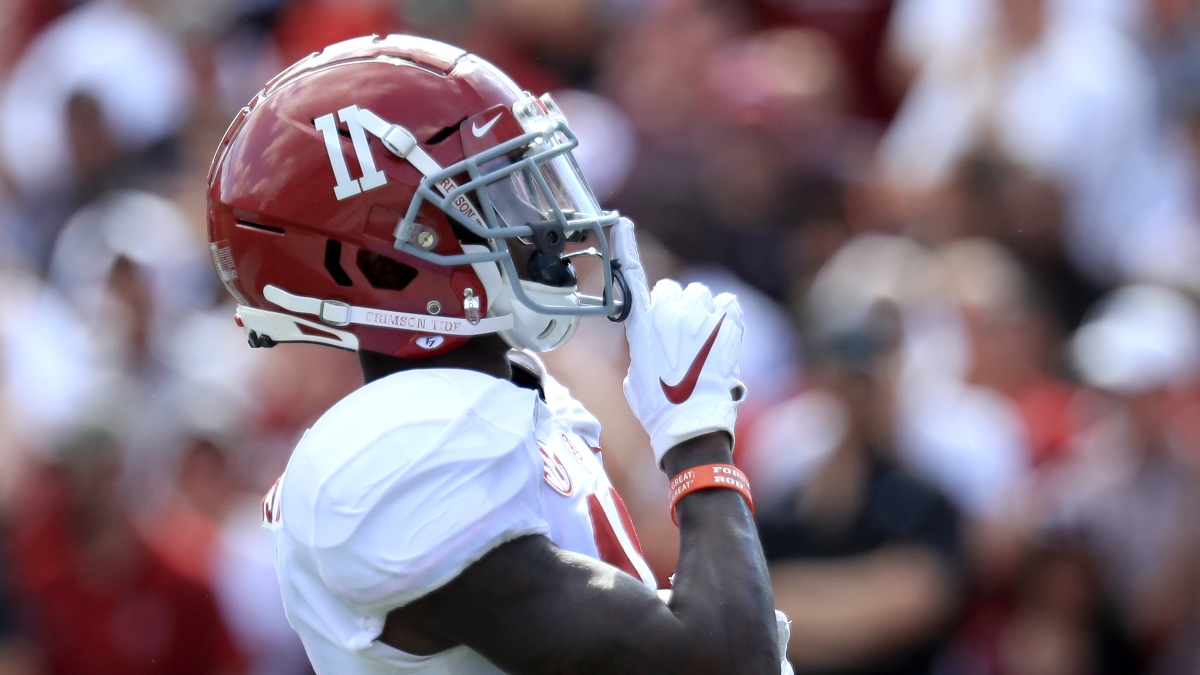
I usually caucus with the analytics folks — we see most players in a similar fashion. But we part ways when it comes to Ruggs.
I'm not convinced that he'll be a star. It's suboptimal that he never had a big collegiate campaign. But that's all that he's lacking. He has everything else.
Dynasty investors who focus on numbers tend to privilege production above all else, and that makes sense. College production is predictive of professional performance. If a guy puts up stats in college, he has a respectable chance of doing so in the NFL.
But strong college production I've found is normally accompanied by — or maybe even driven by — good marks in other areas. If a guy does well in college, he tends to be young. He tends to enter the NFL as an underclassman. He tends to have a good physical profile. He tends to have a high recruitment grade. He tends to be selected early in the draft. He tends to play at a good college program. He tends to be efficient with his opportunities.
That's Ruggs. He checks all the boxes — except for the big one at the top: He doesn't have the voluminous production.
And that's what I think a lot of the analytics community is missing with Ruggs: College production I believe is the result of — the evidence of — all these other factors, which are the true determinants of NFL success. Production is just a proxy. A signifier.
But people act as if it is the signified — in the words of King Lear, "the thing itself." Production is not the thing. It's merely a symbol of what a player really is.
Ruggs hasn't declared himself to be a king — but he's wearing the regal robes and a crown, he's carrying a scepter and he's marching toward us with an army. We should probably assume he's a monarch.
When it comes to prospects, the proof is ultimately in the pudding of the NFL draft. The market is sometimes inefficient, but it never lies, and Ruggs went off the board as the first receiver selected in Round 1. That wasn't a fluke.
Over the past four years — essentially, since speedster Tyreek Hill’s rookie season — the NFL has privileged speed at the wide receiver position, and as a result, we’ve seen fast receivers go off the board as either the first player at the position or a top-10 pick.
- 2019: Marquise Brown, 1.25 (1st) – No pre-draft workout because of injury, reportedly ran a 4.33 as a junior college recruit
- 2018: D.J. Moore, 1.24 (1st) – 4.42 at 210 pounds
- 2017: John Ross, 1.10 (3rd) – 4.22 at 188 pounds
- 2016: Corey Coleman, 1.15 (1st) – 4.37 at 194 pounds (pro day)
Unlike Brown, Moore, Ross and Coleman, the electric Ruggs never had a breakout season in college, but I’m not faulting him for that.
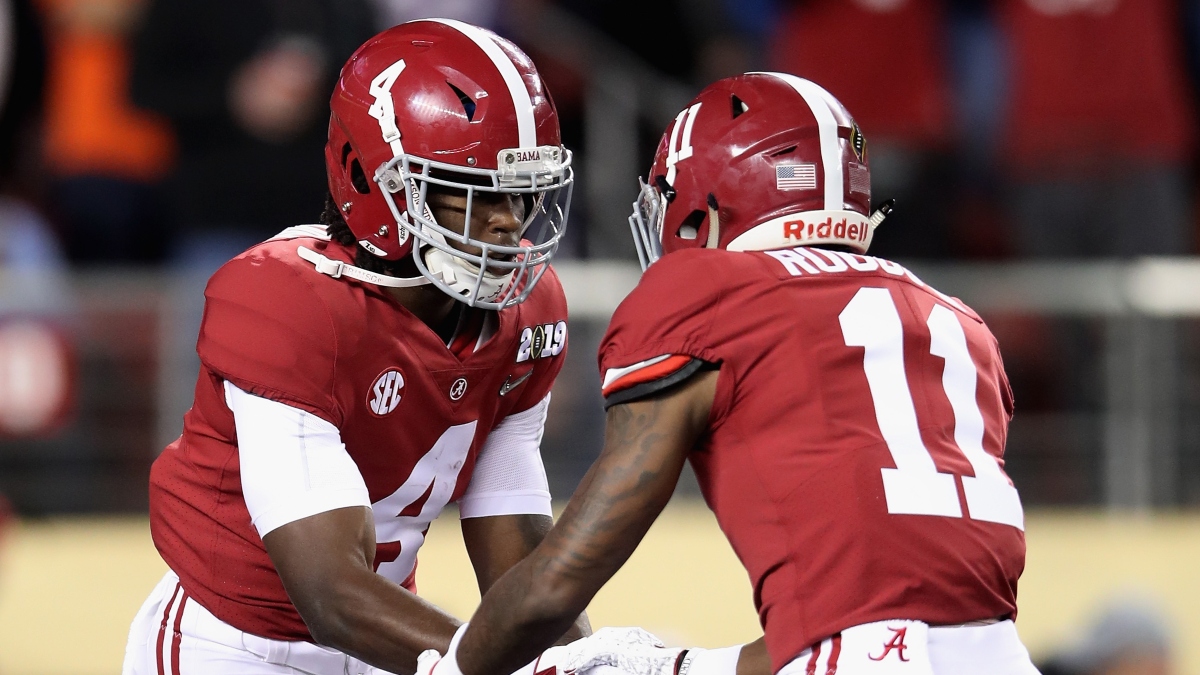
With Alabama’s assortment of pass-catching talent and offensive dominance, Ruggs was never called upon to be an alpha receiver. The team didn't need him to do a lot for it to roll over opponents, and Ruggs had to compete for targets with Jerry Jeudy, Devonta Smith and Jaylen Waddle, all three of whom are Round 1-caliber players.
Ruggs' lack of overall production is understandable and excusable. And it's not as if he contributed nothing at Alabama. For his career, he turned 100 touches from scrimmage into 1,791 yards and 25 touchdowns.
That’s elite efficiency, and he is a better receiver than most numbers-based analysts think: Ruggs is an above-average route runner with strong contested-catch skills for his size, and his elite deep speed makes him a threat to score whenever he touches the ball. For his career, he gifted his quarterbacks with a 151.4 passer rating when targeted (per PFF).
Among draft-eligible receivers, Ruggs trailed only Lamb last year with his mark of 13.6 yards per target (per SIS).
As you might expect if I told you only that Ruggs is a fast 21-year-old big-play star-recruit SEC first-rounder, he's actually a good receiver.
Henry Ruggs won’t waste a second becoming a big threat in the NFL. pic.twitter.com/vOr8FJrs2f
— AJ Spurr (@SpurrFM) April 11, 2020
Because of how he forces defenses to play when he's on the field, Ruggs ultimately might be more valuable to his NFL team than his fantasy franchises. But I expect that, at a minimum, he will have some Tyreek-esque week-winning performances regularly through his career.
At his best, Ruggs will likely be a Brandin Cooks-caliber producer — and that's not nothing. People like to forget how good Cooks has been throughout his career: Over the past six years, he has averaged 1,000-plus yards and six touchdowns per season. And he could have a few more 1,000-yard campaigns ahead of him.
At his worst, Ruggs will be John Ross, maybe Curtis Samuel. Let's keep in mind that Ross had 510 yards and three touchdowns in eight games last year and that Samuel has seven touchdowns in each of the past two years while playing primarily with backup quarterbacks.
If Ruggs turns into Ross or Samuel, that might not be a negative outcome.
NFL Prospect Comp: Mecole Hardman with more speed and way more production
8. Jalen Reagor, WR, Eagles
- Draft Position: 1.21 | School: TCU
- Height: 5’11” | Weight: 206 pounds (combine), 198 pounds (pro day)
- 40-yard dash: 4.47 seconds (combine), 4.28 (pro day)
- 2020 Age: 21 | Class: Junior
- Recruitment Stars: 4
My comp for Jalen Reagor entering the draft was "Jeremy Maclin with less production and draft capital."
- I guess the Eagles have a type.
- I guess I was wrong about the draft capital bit.
As a first-round pick, Reagor has moved significantly up my board. He is likely to play right away, and if/when veteran wide receivers Alshon Jeffery and DeSean Jackson miss playing time in 2020, Reagor could see a big boost in target volume.
Even though he's a rookie, and even though he underwhelmed in his final season at TCU, Reagor could finish 2020 as the No. 1 wide receiver on the Eagles.
The landing spot for Reagor is very advantageous … and yet I'm conflicted about him.
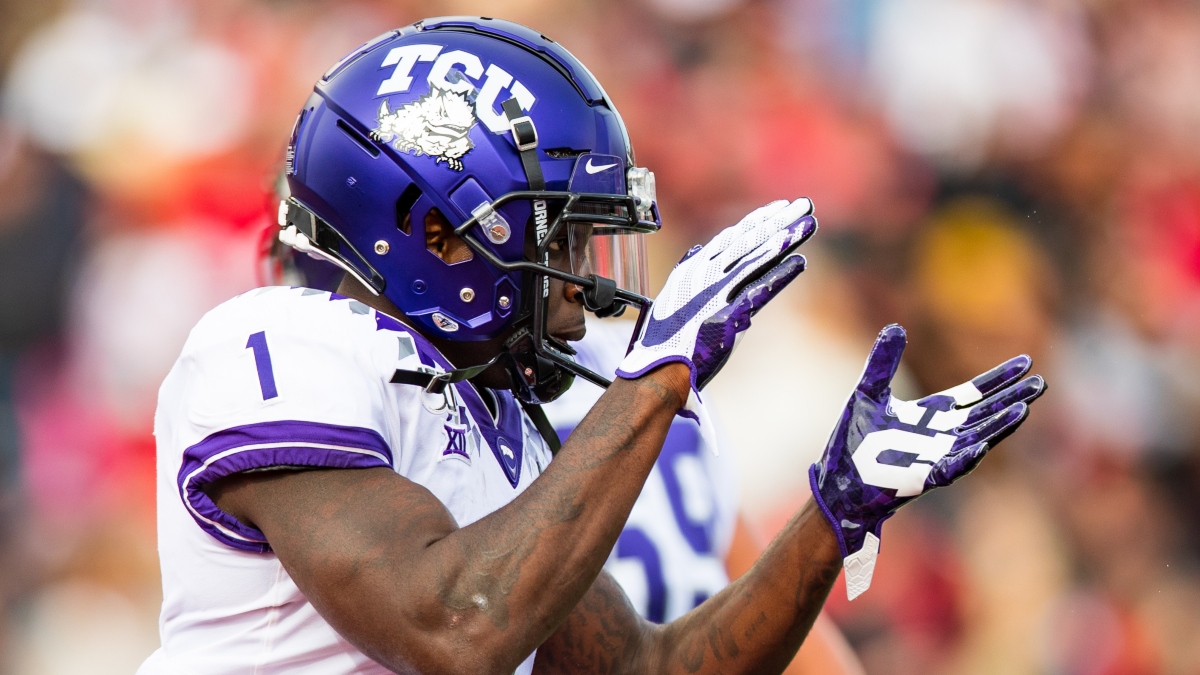
Under defensive-minded head coach Gary Patterson, TCU hasn't sent one successful wide receiver to the NFL over the past 20 years: Josh Doctson, Josh Boyce, Jeremy Kerley … pretty much any TCU receiver whose first name starts with the letter "J." It hasn't been pretty. That's not great news for Jalen.
More importantly, Reagor massively underproduced in 2019 with just 611 yards and five touchdowns on 43 receptions and 92 targets (per SIS). He did manage to chip in with 14-89-0 rushing and two punt return touchdowns, but on the whole, his junior campaign was a catastrophe, given what he accomplished as a sophomore.
Perhaps the depths of his disappointment can best be explored by comparing his 2019 numbers to those of the other Round 1 receivers, specifically expected points added per target (EPA) and positive play rate vs. man coverage (PVM, per SIS).
- Justin Jefferson: 0.67 EPA | 67% PVM
- CeeDee Lamb: 0.64 EPA | 48% PVM
- Henry Ruggs III: 0.59 EPA | 58% PVM
- Jerry Jeudy: 0.53 EPA | 48% PVM
- Brandon Aiyuk: 0.50 EPA | 41% PVM
- Jalen Reagor: -0.08 EPA | 32% PVM
There's no denying that last year Reagor's production was subpar. But his poor performance wasn't entirely his fault.
Per PFF: "There are legit excuses for that, like him statically lining up at right wide receiver every snap, almost never getting thrown screens, and having one of the worst quarterback situations in the country. The ability to consistently get behind defenses was still very much there even if the numbers don't show it."
Quarterback play in particular is the primary reason for Reagor's collapse, per PFF: "Only 30.7% of Reagor’s targets in 2019 were charted as accurate. Only three other FBS receivers had it worse this past season."
Basically, I'm Robin Williams in Good Will Hunting, and I'm telling you over and over that it's not Reagor's fault.
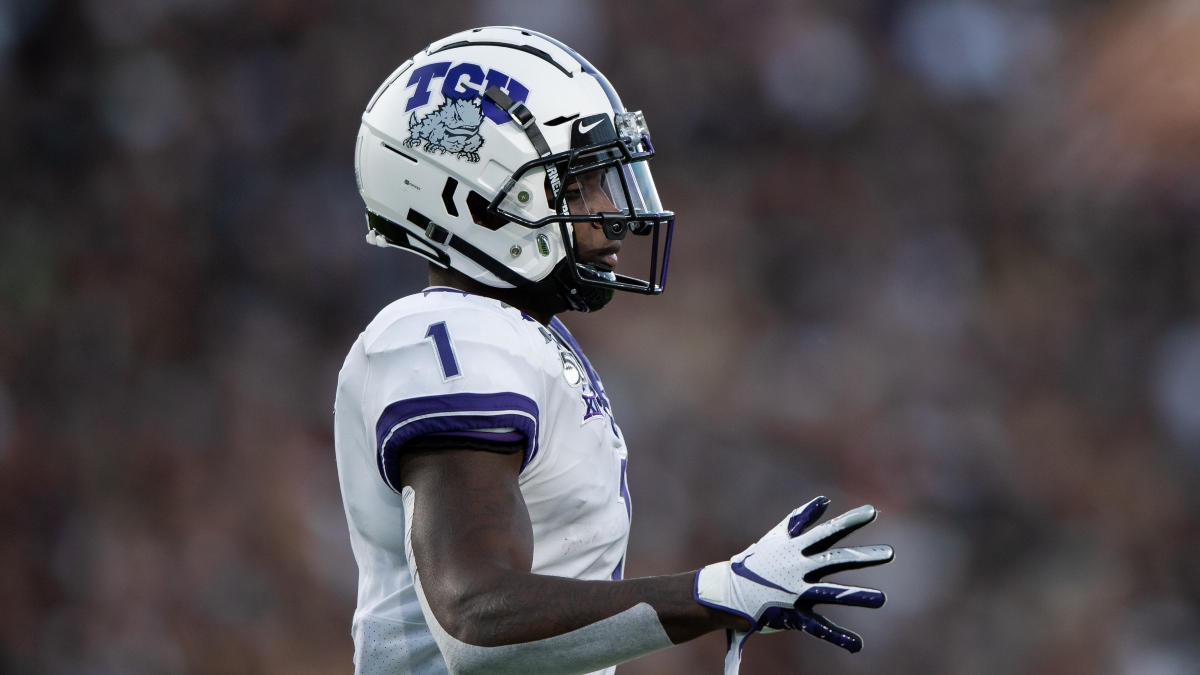
But even so — even if Reagor is not to blame for his lack of production in 2019 — it still materially hurts his long-term prospects: He is naturally hindered as a player by the fact that he failed to develop last year. He's not as far along the path of progress as he otherwise would be if all had gone according to plan.
So there's a significant bear case to be made about Reagor.
The bull case, though, is not unpersuasive. With the exception of Ruggs, Reagor is probably the best downfield receiver in the draft. He's not strong against press coverage, and he's more of a speedster than a sophisticated route runner, but he's physical at the catch point, and he has a wide catch radius thanks to his explosiveness (42-inch vertical and 138-inch broad jumps).
He can play inside and outside, and his versatile skill set as a receiver, rusher and returner speaks to his overall ability. He's a playmaker. And his 19-year-old sophomore season really was impressive (72-1,061-9 receiving, 13-170-2 rushing).
Entering the combine, Reagor was expected to compete with Ruggs for the fastest 40-yard dash at the position, but he showed up at the event weighing a bulked-up 206 pounds (TCU listed him at 195), and as a result he had a sluggish 4.47-second 40.
He also disappointed with his hilariously slow agility drills (per MD).
- 20-yard shuttle: 4.46 seconds (8th percentile)
- Three-cone drill: 7.31 seconds (5th percentile)
But at the combine he displayed elite explosiveness thanks mainly to his jumps, scoring a 99th-percentile 140.4 burst score (per PP), and at an unofficial pro day, he had a reported hand-timed 4.28-second 40 at a slimmed-down 198 pounds.
An NFL team asked former TCU WR Jalen Reagor to do a pro day this week and film it. Here is the film that went out: pic.twitter.com/eTJ6sAqWLL
— Adam Schefter (@AdamSchefter) April 11, 2020
Am I incredulous about his "pro day" "40 time"? Yeah. But even if you adjust it to 4.38 seconds, that's still good. The dude is a legitimate athlete.
A boom/bust prospect, Reagor has the upside for multiple 1,000-yard seasons and the downside to be forgotten in three years.
NFL Prospect Comp: Jeremy Maclin with less production
9. J.K. Dobbins, RB, Ravens
- Draft Position: 2.55 | School: Ohio State
- Height: 5’9” | Weight: 209 pounds
- 2020 Age: 22 | Class: Junior
- Recruitment Stars: 4
UPDATE (Aug. 7): I have moved Dobbins ahead of Swift. Immediately after the draft, I stuck to my model, which preferred Swift because of his superior draft position, younger age and pass-catching prowess. The market, however, is significantly higher on Dobbins, and although his updated ranking still trails his average draft position, I'm slightly bumping him up as a modest sign of humility. It's not as if Dobbins is a talentless player, and he has significant upside in the Ravens offense.
In 2020, Dobbins will likely replace both Gus Edwards and Justice Hill in Baltimore's committee backfield as the complement to Mark Ingram. While I normally don't get excited about No. 2 backs, Dobbins could have some fantasy relevance right away with how frequently the Ravens run the ball.
And next year, Dobbins might take over as the lead back, given that Ingram turns 31 in December and the Ravens could look to get out of his contract after the 2020 season (per Spotrac).
Whenever Dobbins becomes the lead back in Baltimore, he will have top-eight upside playing next to quarterback Lamar Jackson.
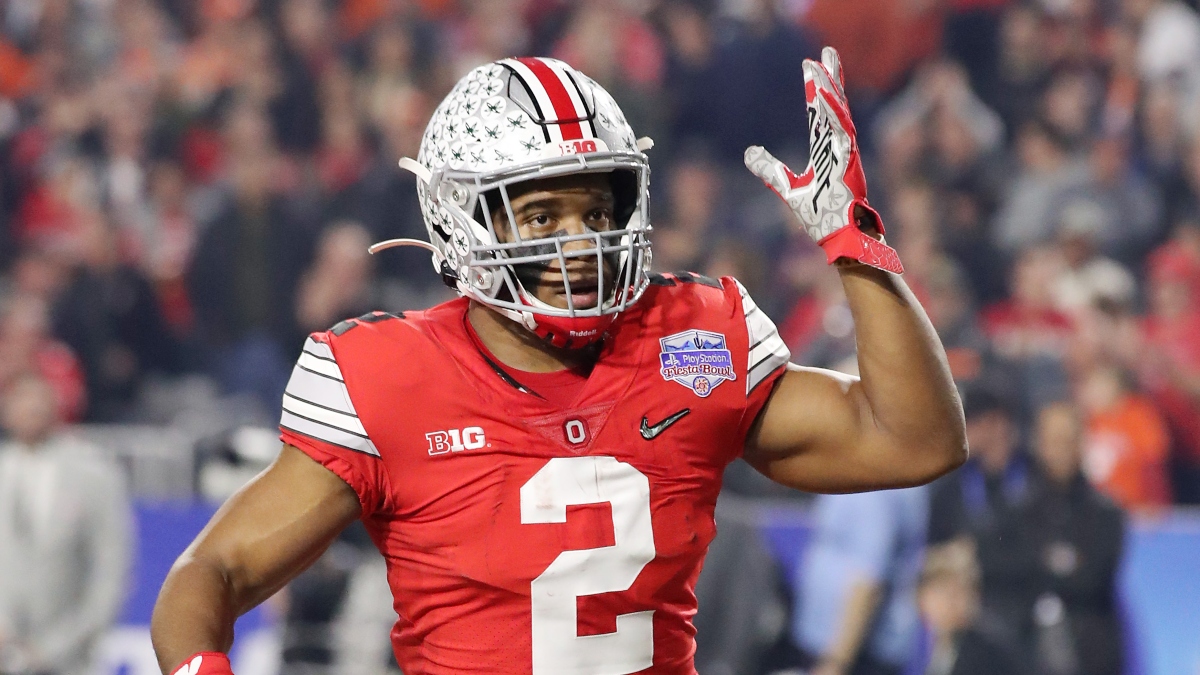
That said, I'm almost certainly lower on him than most analysts are, but my ranking has less to do with him and more to do with how I value running backs, wide receivers and draft position.
If you pick in the top half of Rounds 1-2 and you absolutely want to take a running back and wide receiver with your top rookie selections, then you should go with a back in Round 1 and receiver in Round 2. And if some of the top backs are off the board by the time you pick in Round 1, then Dobbins is a great fallback option.
I have Dobbins ranked lower than the other top-five backs but can see how he might be the most productive of the group three years from now.
But in a vacuum, I don't want to put him near the top of my draft board, because in dynasty I value wide receivers ahead of running backs: Receivers in general are longer-lived assets, and their success is easier to project because it's less tied to the vicissitudes of workload.
Essentially, I can't put Dobbins as high on my board as I otherwise might because this class is so stacked at receiver, and in 95% of situations, I'm going to rank 21-year-old first-round wide receivers ahead of a 22-year-old second-round running back.
That's just how I do business, and I believe that in the long run I'll be more profitable if I stick with my investing discipline.
But that doesn't mean I don't like Dobbins: I like him a lot. Of the backs in this class, he probably provides the most bang for your dynasty buck, because he could arguably be a top-three pick but he almost certainly won't be selected there in rookie drafts.
Of the big five, Dobbins is the oldest and almost the smallest. But he entered college as a highly desired recruit, and in his three years with the Buckeyes, he put up numbers.
- 2017 (14 games): 194-1,403-7 rushing, 22-135-1 receiving
- 2018 (14 games): 230-1,053-10 rushing, 26-263-2 receiving
- 2019 (14 games): 301-2,004-21 rushing, 23-247-2 receiving

As a runner, Dobbins compares favorably to the other top-five backs with his breakaway percentage and yardage after contact per attempt (per PFF).
- J.K. Dobbins: 47.6%, 4.01 yards
- Clyde Edwards-Helaire: 44.7%, 3.65 yards
- Jonathan Taylor: 39.3%, 3.93 yards
- D'Andre Swift: 37.5%, 3.55 yards
- Cam Akers: 33.3%, 3.91 yards
And although he doesn't match CEH and Swift as a receiver, Dobbins is more than just a checkdown option: On almost 10% of his snaps last year, he lined up outside of the backfield, and he holds his own as a pass-catching threat, based on his career marks for catch rate, yardage per target and expected points per target (per SIS).
- Clyde Edwards-Helaire: 85.2%, 7.3 yards, 0.20 EPA per target
- D'Andre Swift: 81.1%, 7.1 yards, 0.14 EPA per target
- J.K. Dobbins: 80.7%, 7.3 yards, 0.19 EPA per target
Aesthetically, some film-grinding enthusiasts probably don't like Dobbins' running style. To my untrained eye, he's a one-cut upright downhill runner more than a shake-and-bake juker, which means that he's not likely to create a lot of yards on his own with great vision and creativity.
That lack of free-lancing improvisation doesn't bother me. In general, I tend to like the runners who seek to maximize what their blockers give them within the structure of each designed play.
Dobbins' size also might bother some potential investors. At 209 pounds, he's not built like a traditional lead back even though he runs with a workmanlike mindset. But I'm not worried about his size. He packs a lot of power in his frame, and he has good functional strength. At the combine, he had a top-five mark with 23 reps on the bench press.
Even though Dobbins did literally nothing at the combine besides the bench, I have absolutely no questions about his athleticism. As a recruit in 2016, Dobbins had the No. 1 overall athletic score at The Opening, where he competed alongside all the other top recruits in the country.
The 2016 Nike+ Football Rating Champion | @Jkdobbins22pic.twitter.com/63nlT0kaCZ
— The Opening (@TheOpening) July 8, 2016
Ranking in the 99th-percentile with his size-adjusted speed (4.45-second 40-yard dash), explosiveness (43.1-inch vertical jump) and agility (4.09-second 20-yard shuttle), Dobbins is one of the most elite all-around athletes in the 2020 class.
Given his productive consistency, receiving ability and elite physicality, it wouldn't have been a stretch for Dobbins to be the first back selected in the draft.
Dobbins has a good shot to have multiple top-20 finishes in his career.
NFL Prospect Comp: Jerick McKinnon, but a running back instead of a running college quarterback
10. D'Andre Swift, RB, Lions
- Draft Position: 2.35 | School: Georgia
- Height: 5’8” | Weight: 212 pounds
- 40-yard dash: 4.48 seconds
- 2020 Age: 21 | Class: Junior
- Recruitment Stars: 4-5
Entering the draft, Swift was the No. 1 rookie on my board. And now … he's not.
I'm probably overreacting by dropping him to No. 9, but given his landing spot, it's hard for me to justify (at least to myself) ranking a workload-uncertain second-round back ahead of any 21-year-old first-round wide receiver.
So I have Swift at No. 9. I hate the situation, and I hate myself.
I'm still bullish on Swift for the long term. Because of his skill set, he should have multiple 1,000-yard campaigns in his career. But for this year at least, Swift seems likely to be at best the lead back in a committee and at worst a glorified Giovani Bernard-like pass-catching change-of-pace supplement — unless the Lions part ways with third-year second-round running back Kerryon Johnson.
But I doubt that will happen … because the Lions seem to like him … because they just drafted another version of him.
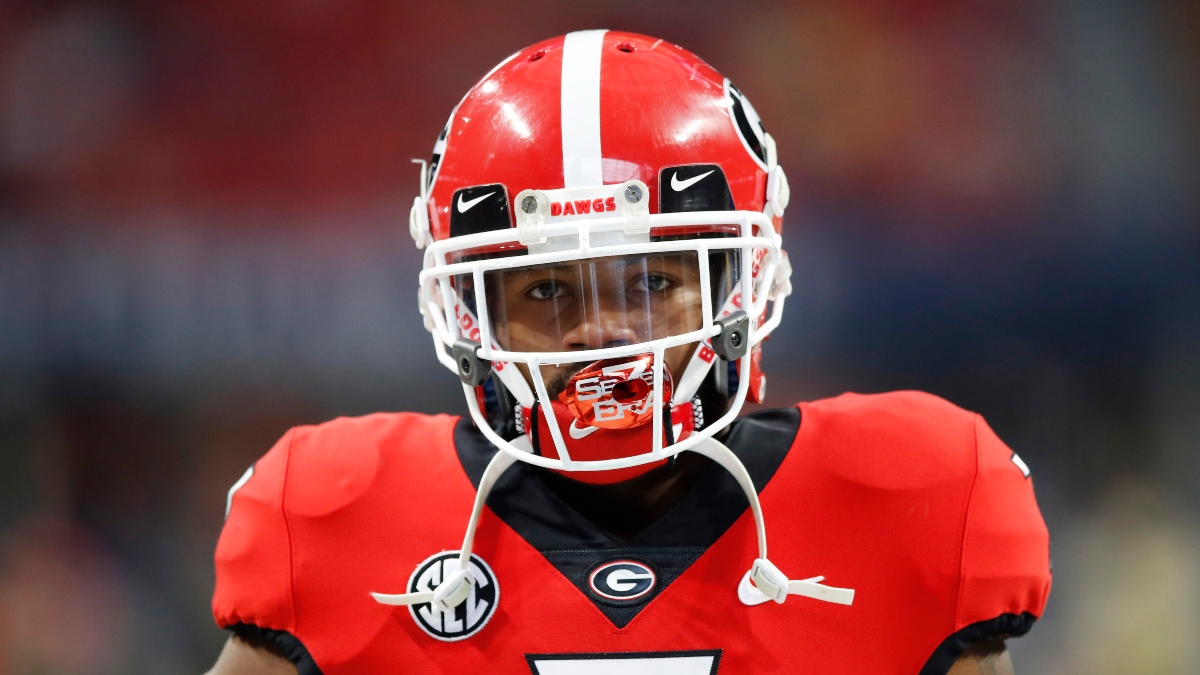
If you look in the RV Prospect Box Score Scout, the player to whom Swift is most comparable (based on draft position and a number of college production metrics) is Johnson.
I don't want to be too down on Swift, because he's a 21-year-old second-round back, and over the past two decades, those guys have provided great value. I'm talking about guys like Clinton Portis, Maurice Jones-Drew, Ray Rice, LeSean McCoy, Le'Veon Bell and Joe Mixon.
Of course, as fate would have it, the most recent 21-year-old second-rounder to enter the league hasn't panned out, and I doubt he will … because his team just drafted D'Andre Swift.
My fear is that the Lions drafted Swift not because they want him to replace Johnson but because they want him to replicate him. And if that's the case, then replication will inevitably lead to cannibalization. Self-cannibalization.
"Soylent Green is people" — and those people are Johnson & Swift.
But perhaps I'm wrong.
Maybe Swift will be the lead back in Detroit and dominate touches: He's a promising player.
Per PFF, he's the No. 1 receiving back in the class, and that should give him a significant edge over Johnson.
And as the NFL continues to shift toward a pass-heavy format and as more fantasy leagues shift from standard to PPR scoring, Swift's value will grow.
As a runner, Swift was efficient and explosive with 6.6 yards per carry and a 37.5% breakaway percentage. He's a perfectly fine runner.
But his receiving is really what sets him apart. Whether he's running routes out of the backfield, in the slot or out wide, he's precise and smooth. He can create separation at will. He has a full route tree. And he doesn't drop the ball. In 90 targets across three seasons, Swift had just three drops. And he had no drops in his final season.
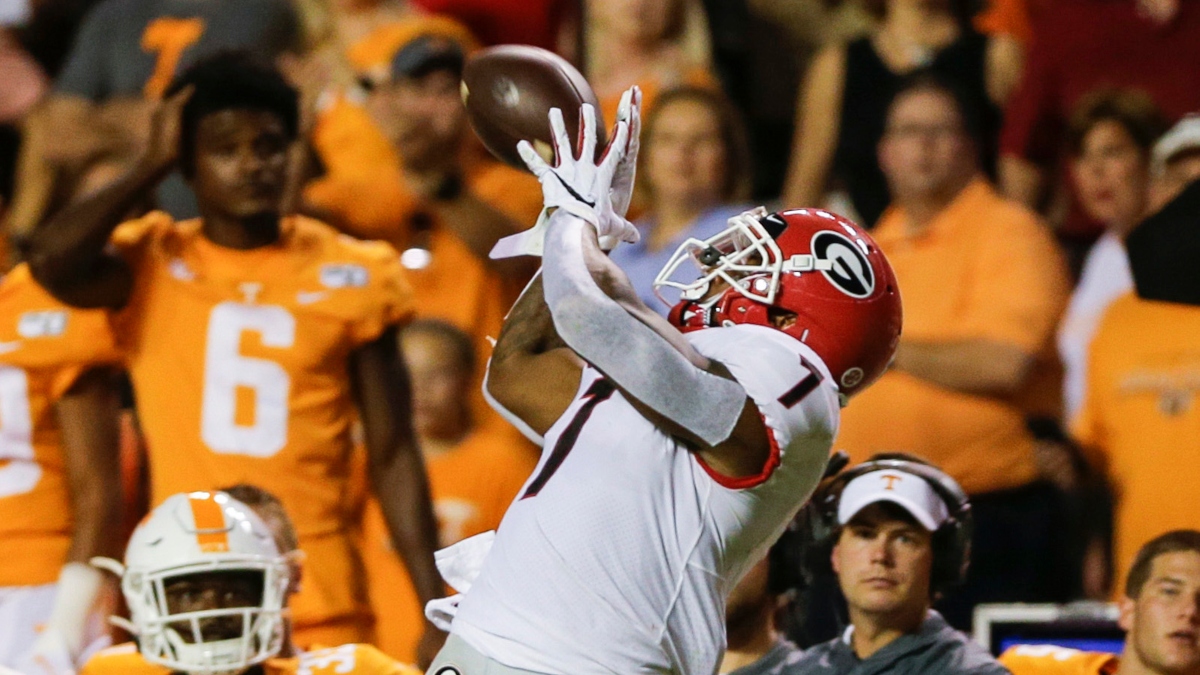
Swift vs. a linebacker in coverage is just unfair. In his two seasons as the lead back at Georgia, he was a true receiving weapon.
- 2019: 82.8% catch rate, 7.5 yards per target
- 2018: 82.1% catch rate, 7.6 yards per target
If he can beat out Johnson and become a true lead back, Swift has some real Christian McCaffrey-esque potential.
Like McCaffrey, Swift enters the NFL as a small-yet-big-enough producer with top-tier pass-catching ability and two lead-back seasons.
The parallels aren't perfect, but there aren't many backs like Swift.
He's a 21-year-old SEC producer with elite pass-catching ability and second-round draft capital. He's good enough as a runner, and he's probably already a top-eight receiving back in the league.
Even if all he ever becomes is Giovani Bernard, it's worth remembering that Bernard averaged 1,146.7 yards and 5.7 touchdowns per season his first three years in the league.
Based on his age, physical profile, college production, receiving ability and draft position, Swift should probably have multiple top-10 fantasy seasons in his career … if the Lions manage not to screw him up.
NFL Prospect Comp: Maurice Jones-Drew with less speed and return ability
11. Antonio Gibson, RB/WR, Redskins
- Draft Position: 3.66 | School: Memphis
- Height: 6’ | Weight: 229 pounds
- 40-yard dash: 4.39 seconds
- 2020 Age: 22 | Class: Senior
- Recruitment Stars: 3-4
UPDATE (Aug. 7): I was already planning on moving Gibson up before the Guice release, but a move from No. 21 to No. 11 wasn't what I expected. Life changes fast. Gibson is now securely on the borderline of Rounds 1-2 borderline.
Is Antonio Gibson now a 2020 Round 1 pick in dynasty leagues yet to have their rookie drafts?
— Matthew Freedman (@MattFtheOracle) August 7, 2020
He now has the opportunity to match his upside. I'll be thrilled if I'm able to get him in Round 2 of any future rookie drafts.
I might need to move Gibson up my board, because he has some real David Johnson-like potential as a receiver-turned-runner offensive weapon.
People are going to sleep on him right now, but he has the talent to take over the backfield for the Redskins.
RIP: Adrian Peterson & Derrius Guice
Redskins take RB Antonio Gibson at 3.66.
— Matthew Freedman (@MattFtheOracle) April 25, 2020
Although Gibson worked out with the wide receivers at the combine, he has been projected to the NFL mostly as a running back throughout the evaluation process.
I will let you know if I find a RB coach or even a team that doesn't like Memphis RB Antonio Gibson. Only one team I've spoken with sees him as a WR – all others see him as a RB. One coach likened him to a lesser version of Joe Mixon
— Lance Zierlein (@LanceZierlein) April 16, 2020
And, sure enough, after drafting Gibson, the team said that it intends to use him at running back — or as a running back/receiver hybrid — and to line him up all over the field in two-back sets so that Peterson or Guice could be in the backfield and he could be in the backfield as well or in the slot (per Grant Paulsen and Albert Breer).
So right now the team seems to view Gibson as a supplemental player. He'll probably start out in Washington by returning kicks and getting occasional usage — just as Johnson did as a rookie.
But what happens if, in a Johnson-esque fashion, Gibson proves to be more efficient and explosive with his touches than are the 35-year-old Peterson and the injury-slowed Guice?
They'll give him a chance to lead the backfield.
And if Gibson gets his chance, I expect that he will run away with it. He'll make the full-blown transition from part-time gadget player to full-time lead back with the potential for 250 carries and 100 targets.
And why shouldn't he? Even though he played 87% of his snaps in the slot in 2019, as a runner he led the nation with 11.2 yards per attempt and 8.0 yards after contact per attempt (per SIS).
Based on the SIS data, I don't think Gibson ran one single time in between the tackles last year. Oh, man. But does that really matter? That doesn't mean he can't do it. Lots of tape-grinding analysts thought that Johnson's ineffectiveness as an interior rusher would prevent him from being a full-time back in the NFL. It didn't.
If a guy can catch the ball and turn enough of his carries into big plays, his team probably won't care if he's a below-average interior runner — because how many yards do up-the-gut rushing plays get anyway?
As a slot receiver, Gibson can catch the ball, and as an offensive player, Gibson can break enough tackles to make big plays. Last year he led the college ranks with 38 broken tackles per 100 touches (per SIS). Specifically, he had 16 broken tackles on 33 carries and 17 broken tackles on 38 receptions. As a receiver, he led all draft-eligible prospects with 11.7 yards after the catch per reception (per PFF).
Those numbers are beyond elite. The sample is small, but Gibson's ability is undeniable.
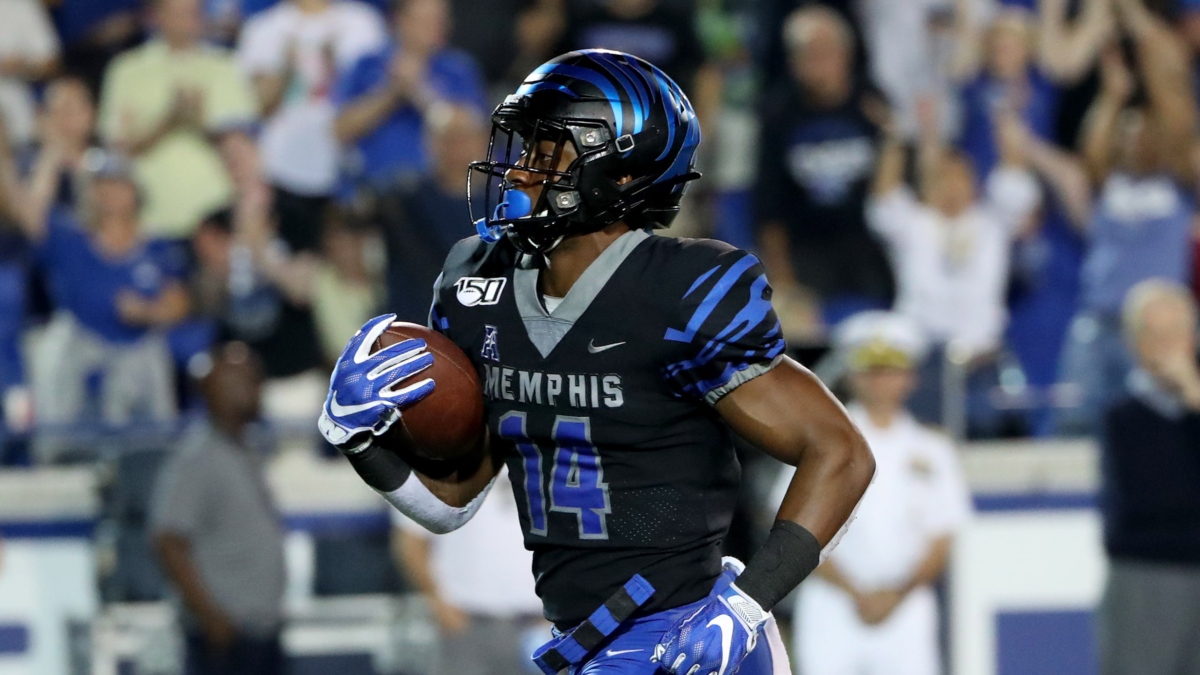
It's less than ideal that Gibson started out at junior college, but he was the No. 1 receiver as both a freshman and sophomore (50-871-13 receiving in 19 games), and he had an age-18 breakout with 39.1% of the receiving yards and 37.5% of the receiving touchdowns in his first year at East Central Community College (MS).
He leveraged that production into 3-4 stars as a JUCO recruit, and after serving as a depth receiver at Memphis in 2018 while Darrell Henderson, Patrick Taylor and Tony Pollard dominated touches in the offense, he exploded as a senior, playing to perfection the backfield/slot receiver role that launched Pollard to the NFL as a fourth-rounder in last year's draft.
Gibson's 2019 production can be described only as pornographic.
- Receiving: 38 receptions, 735 yards, eight touchdowns on 56 targets
- Rushing: 33 carries, 369 yards, four touchdowns
- Kick Returning: 23 returns, 645 yards, one touchdown
That's 1,104 yards from scrimmage and 13 all-purpose touchdowns — on highly limited usage — in 14 games.
Unreal.
I admit that Gibson might totally fail in the NFL as a running back. It's a projection, because he didn't really play the position in college. He just occasionally lined up there. Most of his handoffs came on jet sweeps.
But he was a back in high school, so the position isn't totally foreign to him.
He's a boom/bust player, and that's why I have him ranked after most of the second-round receivers — but I'm willing to bet on his ability to boom.
He's not a nuanced runner or smooth route runner. He's just an explosive playmaker, and near the end of Round 2, that's worth investing in.
In the RV Combine Explorer, the running back to whom he's most physically comparable is Ronnie Brown; wide receiver, A.J. Brown. Except he's significantly faster than both. Naturally.
He's basically the more explosive Shenault.
- Antonio Gibson: 6'0" and 228 pounds, 4.39-second 40 time
- Laviska Shenault: 6'1" and 227 pounds, 4.58-second 40 time
He's the arbitrage Taylor.
- Antonio Gibson: 6'0" and 228 pounds, 4.39-second 40 time
- Jonathan Taylor: 5'10" and 226 pounds, 4.39-second 40 time
He's a league winner.
NFL Prospect Comp: Ty Montgomery but bigger and much faster with more draft capital and less polish
TIER 3
12. Brandon Aiyuk, WR, 49ers
- Draft Position: 1.25 | School: Arizona State
- Height: 6′ | Weight: 205 pounds
- 40-yard dash: 4.50 seconds
- 2020 Age: 22 | Class: Senior
- Recruitment Stars: 3
UPDATE (Aug. 7): With Deebo Samuel (foot) uncertain for the start of the season, I remain convinced that Aiyuk belongs in Round 1 of rookie drafts.
Aiyuk might not be a strong producer right away, but the 49ers needed a wide receiver after Emmanuel Sanders left in free agency, and like Sanders — and Deebo Samuel, for that matter — Aiyuk is a versatile player who can line up all across the formation and even take handoffs out of the backfield and on jet sweeps.
Aiyuk will probably play behind Samuel in 2020, but he will likely be a Week 1 starter, and by 2021, he could be the No. 1 receiver.
And he should definitely — definitely! — be a locked-in, no-doubt first-rounder in 2020 rookie dynasty drafts, especially since he was selected in Round 1 of the NFL draft.
Don't sleep on Aiyuk.
He gets knocked as a one-year wonder because he didn't have a breakout campaign at the FBS level until his 2019 senior season, but that perspective overlooks what he accomplished at Sierra College, where he dominated the junior college ranks.
After a respectable freshman season (29-573-5 receiving), Aiyuk tore up the CCCAA in 10 games as a sophomore in 2017.
- Receiving: 60 receptions, 960 yards, 14 touchdowns
- Rushing: 13 carries, 59 yards, one touchdown
- Kick Returning: 11 returns, 418 yards, two touchdowns
- Punt Returning: 14 returns, 313 yards, one touchdown
That's 1,019 scrimmage yards and 18 all-purpose touchdowns at 19 years old. Pretty good.
In fact, it was good enough to get Aiyuk scholarship offers to 10 different FBS schools — including Alabama — but he chose Arizona State because he was promised the opportunity to compete for a starting receiver spot right away. And he did earn a starting spot with the Wildcats in 2018, playing in three-wide sets behind 2019 first-round wide receiver N'Keal Harry and racking up a modest 33-474-3 stat line on 47 targets.
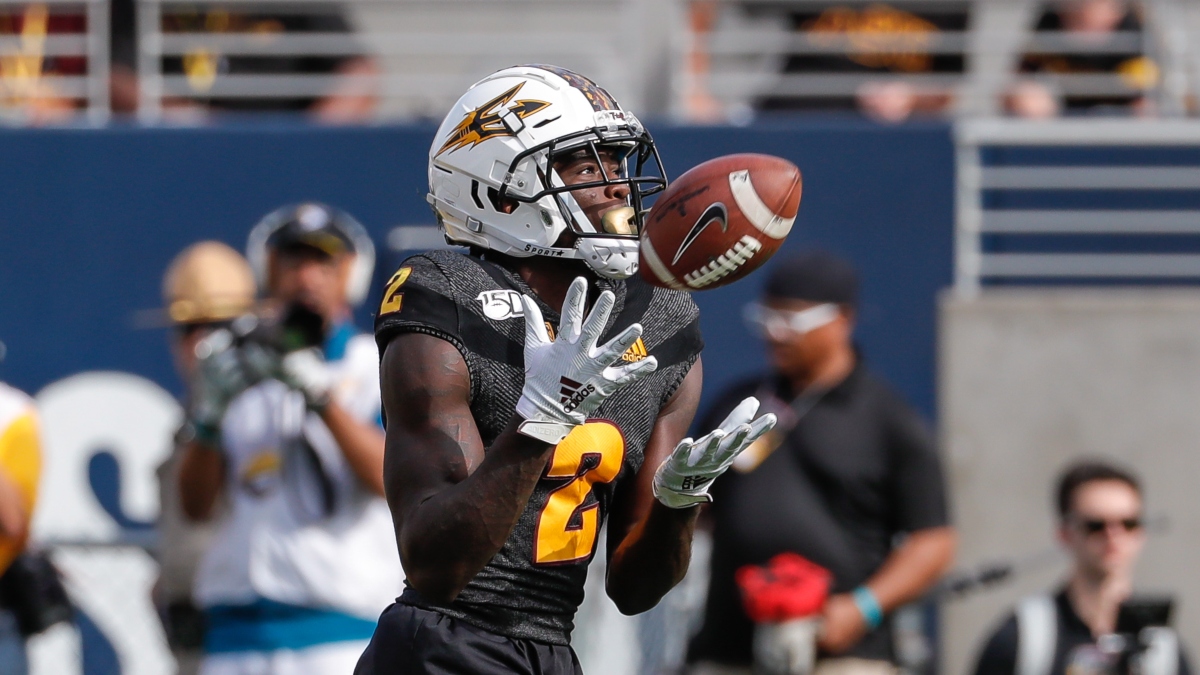
And then in 2019, with Harry gone, Aiyuk stepped up as the No. 1 wide receiver on the team, flashing once again with 1,198 yards and eight touchdowns from scrimmage plus a return score in 12 games.
Clearly Aiyuk is more than a one-year wonder.
He isn't an overly physical receiver or polished route runner. He's hardly a contested-catch artist. But Aiyuk is a playmaker and versatile enough to line up all across the formation. He can make plays downfield, as evidenced by his 90.4 deep receiving grade (per PFF), and he's one of the best after-the-catch receivers in the class, which isn't a surprise, given how good he is in the return game.
If you look at the wide receiver leaderboard in the SIS Football Rookie Handbook, you'll see that Aiyuk is a top-five receiver — up there with guys like Jeudy and Lamb — in a number of key statistics.
- Yards per target: 11.5 (4th-t)
- Yards after catch: 10.9 (2nd)
- Yards per route: 3.2 (2nd-t)
Although he'll probably be more of an upside No. 2 wide receiver or an ensemble contributor than a true No. 1 option — think of Michael Gallup — Aiyuk has plenty of NFL potential thanks to his all-purpose versatility. He looks like a guy with a reasonable chance of having a couple 1,000-yard seasons.
NFL Prospect Comp: Robert Woods but older and more athletic
13. Tee Higgins, WR, Bengals
- Draft Position: 2.33 | School: Clemson
- Height: 6’4” | Weight: 216 pounds
- 40-yard dash: 4.54 seconds (pro day)
- 2020 Age: 21 | Class: Junior
- Recruitment Stars: 4-5
I love that Higgins landed with the Bengals. In quarterback Joe Burrow, Higgins has a sharp passer who will throw the ball up and let him make plays.
The Burrow-Higgins connection could be something special.
Tee Higgins to the Bengals at 2.01.
Cincy winning Super Bowl, Burrow winning MVP.
— Matthew Freedman (@MattFtheOracle) April 24, 2020
Higgins figures to start right away, and by 2021 at the latest, he should have a lot of targets coming his way.
Wide receiver A.J. Green is yet to sign the franchise tag. There's an outside chance he won't play in Cincinnati this year. And even if he does, it figures to be his last season with the Bengals.
Wide receiver Tyler Boyd has four years left on the contract extension he signed last summer, so he's probably not going anywhere, but the team could get out of the contract after 2020 if he disappoints (per Spotrac).
Wide receiver John Ross is entering his fourth season, and the Bengals are yet to pick up his fifth-year option, so he might be a free agent in 2021.
And the undrafted wide receiver Auden Tate is probably not much of a concern anyway, but he's a restricted free agent after 2020.
Higgins sure looks like a future No. 1 receiver.
Of course, I'm saying all of this as an extreme Higgins optimist. You've been warned.
Although he went No. 33 overall as the first pick in Round 2, I think Higgins probably should've been selected in Round 1.
Higgins saw his draft stock drop after a mediocre pro day, but I still expect him to have a successful NFL career thanks to his difference-making ability.
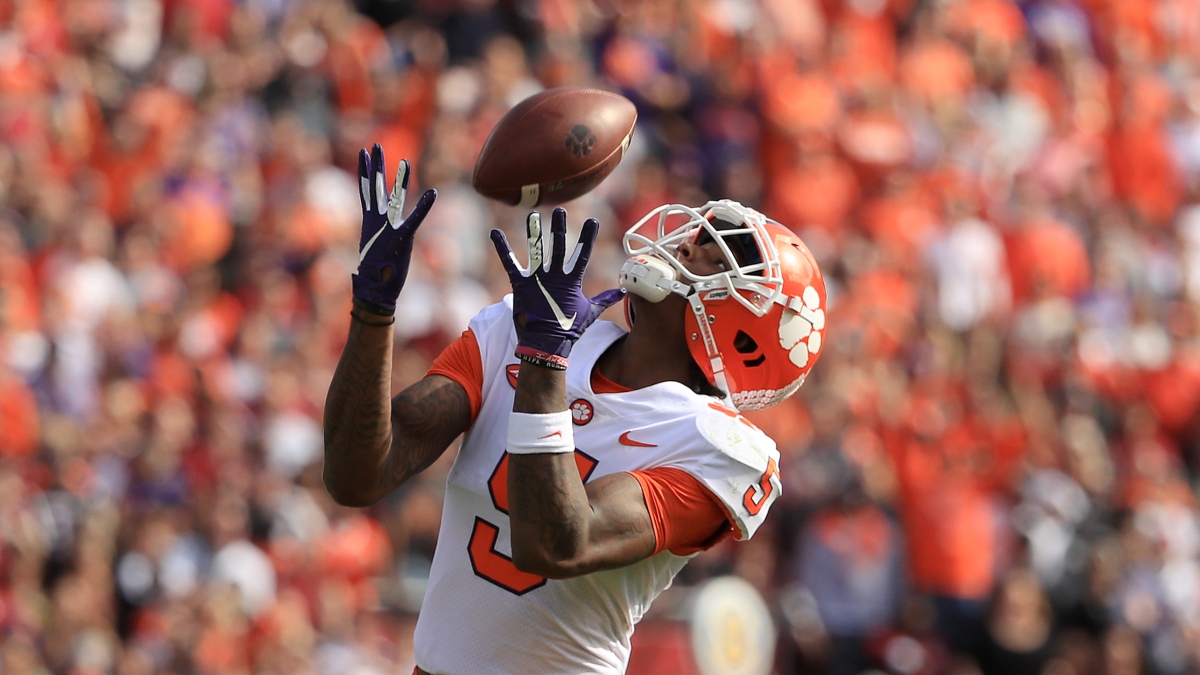
It’s LOL adorable that #NFLTwitter evaluators think Higgins’ athleticism is a problem. Athleticism is extremely overrated for wide receivers, especially for big guys with a respectable amount of draft capital and good college production (Higgins is 118-2,103-25 receiving, 1-36-1 rushing over the past two years).
Based on age, size, speed, college production and draft position, here are the five NFL prospects of the past decade to whom Higgins is most comparable:
- Courtland Sutton: 2.40 (2018) – 6’3″ | 218 pounds | 4.54-second 40 time
- JuJu Smith-Schuster: 2.62 (2017) – 6’1″ | 215 pounds | 4.54-second 40 time
- Davante Adams: 2.53 (2014) – 6’1″ | 212 pounds | 4.56-second 40 time
- Allen Robinson: 2.61 (2014) – 6’2″ | 220 pounds | 4.60-second 40 time
- DeAndre Hopkins: 1.27 (2013) – 6’1″ | 214 pounds | 4.57-second 40 time
That's not a bad cohort, no?
Clemson head coach Dabo Swinney played receiver in college and started out at Clemson as the wide receivers coach. His eye for talent at the position is unparalleled. If a guy has the official Swinney imprimatur, he’s likely to exceed expectations in the NFL.
Of all the Clemson receivers Swinney has had a hand in recruiting, here are the six (other than Higgins) to enter the NFL as top-150 draft selections.
- 1.04 (2014): Sammy Watkins – 1,048 yards, nine touchdowns in second season
- 1.07 (2017): Mike Williams – 11 touchdowns in second season, 1,003 yards in third season
- 1.27 (2013): DeAndre Hopkins – five 1,000-yard campaigns and three All-Pro selections
- 4.108 (2010): Jacoby Ford – 625 yards, seven touchdowns as a rookie with limited playing time
- 4.118 (2014): Martavis Bryant – 1,102 yards, 14 touchdowns in first 16 NFL games
- 5.149 (2019): Hunter Renfrow – 504 yards, four touchdowns in final eight games of rookie season
I defy you to name another college program that has so reliably produced NFL-ready receivers over the past decade.
Alabama? Kevin Norwood (4.123, 2014) and ArDarius Stewart (3.79, 2017) beg to differ. Ohio State? DeVier Posey (3.68, 2012) and Devin Smith (2.37, 2015) think otherwise. USC? Patrick Turner (3.87, 2009), Damian Williams (3.77, 2010) and Marqise Lee (2.39, 2014) laugh at you.
Some tape-grinding enthusiasts think that Higgins is too soft to succeed in the NFL. They say he lacks the physicality necessary to beat NFL corners.
Maybe. I don’t know. A lack of physicality hasn't been a problem in the past.
Tee Higgins: 97.6 grade on tight-window targets.
1st among 2020 NFL Draft WRs pic.twitter.com/axaRKRlvWQ
— PFF Draft (@PFF_College) April 14, 2020
Over the past two years, Higgins has been a top-10 receiver with PFF grades of 90.5 and 87.7.
In perusing the SIS Football Rookie Handbook, one can see easily that Higgins compares well to the top-tier duo of Jeudy and Lamb in key statistics, such as yards per target (YPT), yards per route (YPR), average depth of target (aDOT), expected points added per target (EPA) and positive play rate vs. man coverage (PVM) for the 2019 season.
- Tee Higgins: 12.8 YPT | 3.7 YPR | 14.3 aDOT | 0.68 EPA | 62% PVM
- Jerry Jeudy: 10.6 YPT | 3.2 YPR | 10.8 aDOT | 0.53 EPA | 48% PVM
- CeeDee Lamb: 14.3 YPT | 3.9 YPR | 11.2 aDOT | 0.64 EPA | 48%PVM
It's overwhelmingly positive that Higgins has had so much success against man coverage, which he's likely to see in the NFL.
Higgins has the skills to succeed as a professional perimeter receiver. He tracks the ball well and high points it in contested situations with strong hands and a big catch radius. And with the ball, he's at worse an adequate after-the-catch producer.
Higgins is not a detail-oriented route runner — but he runs go, post and out patterns. He doesn't need to be a nuanced technician to run those routes effectively. All he has to do is beat the smaller guy defending him — and he usually does.
With a wide receiver class this stacked, it's tempting to look at Higgins and imagine the ways in which his athletic shortcomings will limit him. In the big picture, though, it seems foolish to anticipate anything other than NFL success for a productive 21-year-old big-bodied star-recruit Clemson receiver.
NFL Prospect Comp: Mike Williams but younger and with less draft capital
14. Laviska Shenault Jr., WR, Jaguars
- Draft Position: 2.42 | School: Colorado
- Height: 6’1” | Weight: 227 pounds
- 40-yard dash: 4.58 seconds
- 2020 Age: 22 | Class: Junior
- Recruitment Stars: 3
UPDATE (Aug. 7): I'm still not a fan of the landing spot, but Shenault is just so talented that I had to move him above all the Round 2 wide receivers other than Higgins. He's a gift from the fantasy gawds at his average draft position.
I'm happy that Shenault went early in the top half of Round 2, but the landing spot is subpar. The Jags are a run-focused team with a second-year sixth-rounder as the starting quarterback. I like Gardner Minshew as much as the next self-proclaimed psuedo-redneck — but maybe he's not the quarterback Shenault would've chosen?
On top of that, Shenault will have to compete with wide receivers D.J. Chark, Chris Conley and Dede Westbrook for playing time and targets — at least as a rookie.
And who knows if Shenault will even start right away? Chark was drafted in Round 2, and he saw almost no action as a rookie in 2018.
So for 2020, I'm pessimistic, and that's partially why I have Shenault ranked lower than Mims and Pittman.
But I need to remind myself that talent tends to find a way and circumstances can change: Conley and Westbrook are both slated to be free agents after the season, so in 2021, Shenault could be in line for a lot of targets.
Even with the Jags, there's cause for long-term optimism with Shenault.
Honestly, maybe I'm too low on him.
Dede Westbrook is 26, Chris Conley is 27, neither has an 800-yard season at the NFL level.
Laviska Shenault is an underrated prospect with one of the best landing spots of the weekend. If he's not in your rookie first round, you're wrong.
— Ben Gretch (@YardsPerGretch) April 26, 2020
In a vacuum, I would love to move him into Round 1. He feels like a rookie first-rounder. But this is a loaded year at the position. If he had been a 22-year-old second-rounder in last year's class, he almost certainly would've been a Round 1 pick in rookie drafts.
Even though I have him in Round 2, I really like him.
When asked in a post-game interview about playing through an injury, Shenault said, "When I do something, I feel the pain. But, it's pain. (Laughs.) It's just pain. That's all it is."
To Shenault, pain ain't nothing. This dude is a pain factory. He's the physical embodiment of a Nine Inch Nails song. Of all the receivers in this class, he's the most punishing one with the ball in his hands. When Shenault is on the attack, defenders aren't defending just their end zone. They're defending themselves.
I don't want to be hyperbolic, but in his free time, Shenault is Chuck Norris' personal trainer. (Probably.)
In his debut game at Colorado, Shenault scored his first college touchdown on an untouched 55-yard special teams fumble recovery return. That's the kind of stuff that happens only to players destined for Action Network rookie write-ups.
When it comes to Shenault, I struggle to maintain my objectivity.
He's not without flaws.
He's an average-at-best route runner. He has a limited route tree. Much of his production — especially as a scorer — was manufactured for him via screens, short patterns and wildcat carries. In his two final seasons, he dealt with significant injuries that limited his availability and effectiveness (toe, 2018; abdominal, 2019).
In his final season, he was a limited producer with just 56-764-4 receiving and 23-161-2 rushing in 11 games.
And at the combine, despite being widely expected to run faster than 4.50 seconds in the 40-yard dash, he had a time of just 4.58, which tanked his draft stock. Before the combine, Shenault was universally expected to go in Round 1. Clearly, that didn't happen.
But his combine performance needs to be put in proper context. First, Shenault actually has an above-average 40 time for a guy of his size. As a point of comparison: If Davante Adams looked at himself shirtless in the mirror and said, "Nah, I can get buffer," and then he put on 15 pounds of muscle without losing any speed, he'd be Shenault.
Given his size and 40 time, Shenault had a 78th-percentile 103.2 speed score at the combine (per PP). In no universe is that a bad number.
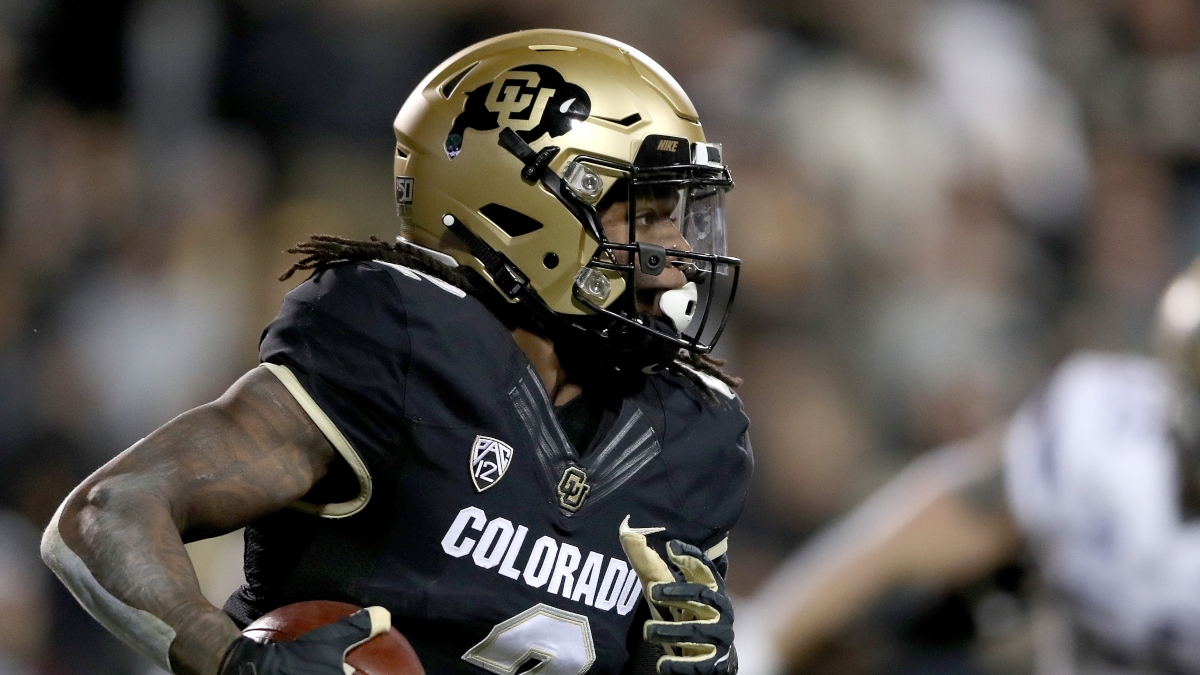
Secondly, Shenault intentionally ran the 40 with a core injury that he knew needed surgery and in fact was operated on a few days after the combine. Why did he work out despite the injury?
To Shenault, pain ain't nothing. Don't forget it.
He's not a speedster, but Shenault is an Anquan Boldin-esque tackle-breaking bully whom PFF ranked as the No. 1 after-the-catch receiver in the class.
He underwhelmed last year, but he was dealing with the core injury, a new coaching staff and poor quarterback play. As a sophomore in 2018, he had a breathtakingly dynamic campaign, amassing 86-1,011-6 receiving and 17-115-5 rushing in just nine games.
And what Shenault did over his college career, especially in 2018-19, places him in the top tier of his peers.
SIS has tracked yards per route (YPR) for the past two years and positive play rate vs. man coverage (PVM) for the past three years. Over those periods of time, Shenault distinguished himself in those respective metrics relative to the six receivers who went in Round 1.
- Laviska Shenault Jr.: 3.5 YPR | 62% PVM
- CeeDee Lamb: 3.5 YPR | 58% PVM
- Jerry Jeudy: 3.4 YPR | 53% PVM
- Brandon Aiyuk: 3.0 YPR | 36% PVM
- Justin Jefferson: 2.5 YPR | 55% PVM
- Henry Ruggs III: 2.2 YPR | 50% PVM
- Jalen Reagor: 2.1 YPR | 39% PVM
Shenault didn't score an unholy number of receiving touchdowns because his offense simply wasn't that good, but since 2018, he's been as good as the best receivers in this class at turning routes into yards — and he has outright dominated against man coverage since his freshman year.
Additionally, he leads all receivers in the class with 44 missed tackles forced since 2018 (per PFF). This guy is a juggernaut.
Even with his subpar 2019, Shenault looks like he might be the most dominant receiver in the class — and, remember, he chipped in 40-276-7 rushing over the past two years.
Whether he’s taking a direct snap as a wildcat quarterback, catching a screen pass at the line of scrimmage or running a deep slant, Shenault is simply a playmaker.
That doesn’t mean he’ll have NFL success. Shenault feels a lot like a slower, non-return man version of Cordarrelle Patterson.
That said, we should remember that C-Patz had 479 scrimmage yards and seven touchdowns in the final eight games of his rookie year. There’s a universe in which Patterson becomes an NFL star — and that universe might be Shenault’s.
NFL Prospect Comp: A.J. Brown with less receiving production and speed but more rushing production and attitude
15. A.J. Dillon, RB, Packers
- Draft Position: 2.62 | School: Boston College
- Height: 6’ | Weight: 247 pounds
- 40-yard dash: 4.53 seconds
- 2020 Age: 22 | Class: Junior
- Recruitment Stars: 3
UPDATE (Aug. 7): I've given Dillon a slight bump to ensure that he stays ahead of his average draft position and to remind Chris Raybon that Dillon is coming from Aaron Jones' workload.
If I weren't such a wimp, I'd have Dillon ranked ahead of Vaughn. In fact, I'd have him ranked in Round 1 — right next to Taylor.
Because, really, what is the difference between Taylor and Dillon?
Yes, Taylor is better. Fine. And he's younger.
But they are still incredibly similar.
Big-bodied Round 2 back with pass-catching concerns but also elite athleticism and three years of high-volume college production who is poised to take the starting job from an overachieving, money-seeking Day 3 back in a contract year.
Jonathan Taylor? Yes.
But also A.J. Dillon.— Matthew Freedman (@MattFtheOracle) April 26, 2020
Tell me I'm wrong.
If you're bullish about Taylor, you should be bullish about Dillon.
If you're a Packers fan and you're disappointed that the team selected Dillon in Round 2, I get it. It would've been better for the team and aging quarterback Aaron Rodgers if a wide receiver had been taken.
But it's not as if Dillon is a massive reach. He doesn't address a strong need, but he's a justifiable pick in Round 2, as I first suggested in February. (Cough.)
@MattFtheOracle AJ Dillon 2nd round pic.twitter.com/PkHnAWk0kH
— Dan Back (@dan_back) February 20, 2020
As an early-down grinder, Dillon will have limited upside in PPR leagues, but given his college production, physical ability and draft capital, he seems likely to get significant playing time right away.
I wouldn't be surprised if he's the lead back for the Packers this year. And if he is — if he overtakes Aaron Jones — he could be a 1,000-yard, 10-touchdown back as a rookie.
In the words of Freddie Mercury, "Get on your bikes and ride!"
A.J. Dillon runs the way Danny Donahue feels on a Saturday morning — with an excess of pain.
He's a high-volume downhill rusher who intelligently follows his blockers and consistently takes what the defense gives him instead of looking to break long runs every play.
And that's not to say that he can't get chunk yardage. He absolutely has the ability to turn short gains into big plays thanks to his tackle-breaking power and elite size-adjusted speed and explosiveness (per PP).
- Speed Score: 117.3 (97th percentile)
- Burst Score: 135.2 (97th percentile)
Dillon runs a bit upright, but he cuts through arm tackles like scissors through crate paper — and I'm not even sure what crate paper is. Only Taylor and Zack Moss have more than Dillon's 198 broken tackles over the past three years (per PP). The dude trucks defenders as well as anyone in the class.
Since his first day on campus at Boston College, he was the lead back.
- 2017 (13 games): 300-1,589-14 rushing, 0-0-0 receiving on 0 targets
- 2018 (10 games): 227-1,108-10 rushing, 8-41-1 receiving on 11 targets
- 2019 (12 games): 318-1,685-14 rushing, 13-195-1 receiving on 16 targets
Like BC forerunner Andre Williams, Dillon doesn't offer much as a receiver — and that is absolutely cause for concern — but I want to make the case that, perhaps, he's not as much of a pass-catching nonentity as most people believe.
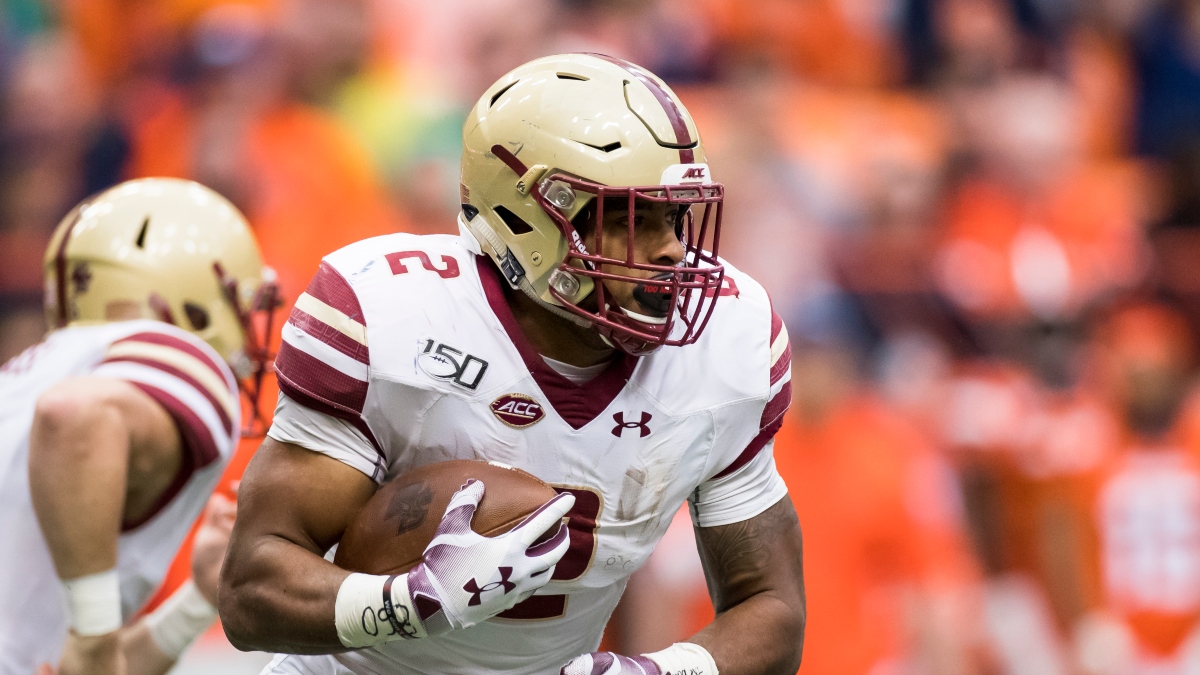
It's incredibly suboptimal that he dropped three of his 24 catchable targets (per PFF), but he has improved as a receiver each year. Last year, he dropped just one pass.
It's not as if Dillon was used extensively in the passing game, and he lacks route-running sophistication, but in expected points added per target (EPA) and yards per route (YPR), he was comparable to the top-five backs in the class in 2019 (per SIS).
- A.J. Dillon: 0.35 EPA | 2.1 YPR
- J.K. Dobbins: 0.52 EPA | 1.4 YPR
- Clyde Edwards-Helaire: 0.20 EPA | 1.2 YPR
- D'Andre Swift: 0.06 EPA | 1.3 YPR
- Jonathan Taylor: 0.05 EPA | 2.7 YPR
- Cam Akers: -0.21 EPA | 2.0 YPR
It's not probable, but it's possible that Dillon has some under-appreciated James Conner-like potential as a receiving back.
And even if Dillon is only ever a two-down grinder, he might still have significant success as the lead back in a committee. We've seen several big-bodied early-down grinders have multiple seasons of success in recent history, including:
- LeGarrette Blount (2010, Undrafted): Two 1,000-yard season
- Jeremy Hill (2014, 2.55): Two 1,000-yard seasons
- Carlos Hyde (2014, 2.57): Three 1,000-yard seasons
- Jordan Howard (2016, 5.150): Three 1,000-yard seasons
As a prospect, Dillon is comparable to Blount, Hill, Hyde and Howard — except he's bigger and faster, and those factors are significant.
Dillon has a real shot to be a 1,000-10 back for multiple seasons.
Because of his rare physical attributes and voluminous college production, Dillon is unlike the vast majority of backs … but there is one player to whom he is screamingly similar, even if the comparison is imperfect.
And you know exactly who I'm talking about.
NFL Prospect Comp: Derrick Henry minus three inches of height, the SEC pedigree, the Heisman Trophy and a little bit of draft position
16. Cole Kmet, TE, Bears
- Draft Position: 2.43 | School: Notre Dame
- Height: 6’6” | Weight: 262 pounds
- 40-yard dash: 4.70 seconds
- 2020 Age: 21 | Class: Junior
- Recruitment Stars: 4
UPDATE (Aug. 7): I'm holding my ground. Kmet should be targeted aggressively at his early-Round 3 average draft position.
If it smells like garbage and tastes like garbage, don't eat it — because it's probably garbage.
The Bears signed TE Jimmy Graham to a two-year deal this offseason with $9M in guarantees — and then they just drafted TE Cole Kmet in Round 2.
I'm starting to think the Bears don't know what they're doing.
— Matthew Freedman (@MattFtheOracle) April 25, 2020
The landing spot for Kmet is not great. The Bears are in disarray on offense, and organizationally they don't really seem to know what they're doing.
Was just thinking the Bears needed (checks notes) their 4 billionth tight end
— Matthew Berry (@MatthewBerryTMR) April 25, 2020
But it's important to remember that circumstances change, whereas the factors most predictive of NFL success are static.
I'm still bullish on Kmet: He seems likely to be an every-down contributor in 2021 when the team inevitably moves on from Jimmy Graham, and by 2022 he could be a top-10 player at the position.
But 2020 will be a sewage recycling plant, and 2021 might not be much better.
Still, he's a 21-year-old Notre Dame tight end with Round 2 draft capital. That's notable.
Over the past five years, Notre Dame has had something of a dry spell. But in the decade before that, the Fighting Irish sent a high-end tight end prospect to the NFL seemingly every other season.
- Anthony Fasano: 2.53, 2006
- John Carlson: 2.38, 2008
- Kyle Rudolph: 2.43, 2011
- Tyler Eifert: 1.21, 2013
- Troy Niklas: 2.52, 2014
In Kmet, the Irish have another top-tier draft pick at the position.
Full disclosure: I'm higher on Kmet than most people in the industry, and I don't care. I'm planting a flag.
I know that there's nothing obviously great about Kmet when you watch him play. He's not a remarkable route runner. He's not a fierce playmaker. He's not an after-the-catch dynamo. He's about average when lined up in the slot and out wide. Per PFF:
Overall, he’s not really a player that is going to create on his own or win consistently in single coverage. Well over half of his 515 receiving yards were underneath the coverage or from finding a hole and when in single coverage he had just a 54.0 receiving grade.
His career positive play rate is significantly better against zone defense than man coverage (per SIS).
- Positive play rate vs. man: 41%
- Positive play rate vs. zone: 67%
What he gets is basically what the defense allows him. He's a chain mover, not a difference maker.
On top of that, he's a below-average run blocker — and that's a problem considering that he's most effective as a receiver when inline.
And as an athlete, he has no agility. At the combine, he had a 13th-percentile three-cone time of 4.41 seconds (per MD). He has no wiggle.
But other than all of that … he's great. Wait, why are you walking away from me?
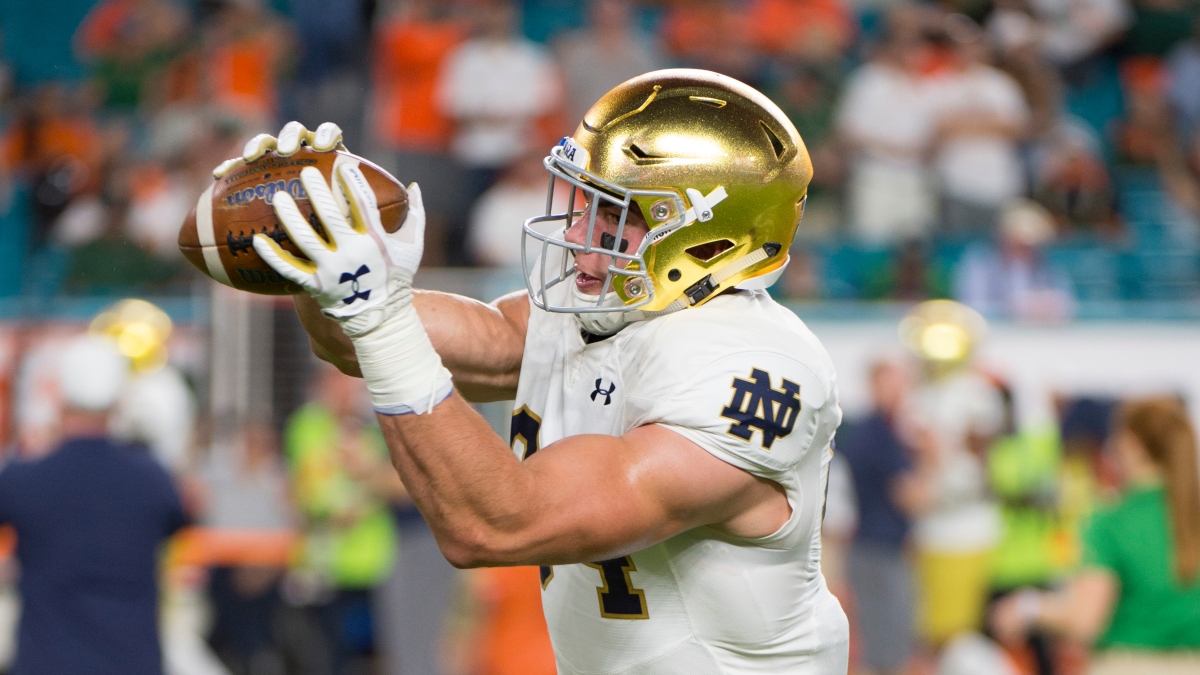
Here's what I like about Kmet: He's an inline-sized Day 2 pick, and most of the best players at the position over the past decade have been second- and third-rounders weighing 245-plus pounds, such as:
- Rob Gronkowski (2010, 2.42): Six top-six seasons
- Jimmy Graham (2010, 3.95): Six top-six seasons
- Travis Kelce (2013, 3.63): Four top-six seasons
- Zach Ertz (2013, 2.35): Three top-six seasons
And that's to say nothing of Kyle Rudolph, Jordan Reed, Austin Hooper, Hunter Henry and Mark Andrews … and Jonnu Smith, Dallas Goedert and Mike Gesicki.
Not every second- and third-round tight end becomes a star, but if you want to find a future fantasy starter at the position, Day 2 is a great place to look.
And Kmet will play all of his rookie season at 21 years old. That's incredibly important. Here are the receiving tight ends over the past 25 years to be drafted no later than Round 4 and to play their first season at age 21:
- Tony Gonzalez (1997, 1.13): 16 top-10 seasons
- Todd Heap (2001, 1.31): Four top-10 seasons
- Jason Witten (2003, 3.69): 11 top-10 seasons
- Kellen Winslow (2004, 1.06): Four top-10 seasons
- Martellus Bennett (2008, 2.61): Three top-10 seasons
- Jermichael Finley (2008, 3.91): One top-10 season
- Rob Gronkowski (2010, 2.42): Six top-10 seasons
- Aaron Hernandez (2010, 4.113): One top-10 season
- Eric Ebron (2014, 1.10): One top-10 season
- Maxx Williams (2015, 2.55): Career derailed by injuries
- David Njoku (2017, 1.29): One top-10 season
- Irv Smith Jr. (2019, 2.50): Waiting
Say what you want about some of those guys, but it would be hard to find a better collection of tight ends with so simple a screen.
Even though he's not agile, Kmet is an explosive athlete. With his size, 40 time and 37-inch vertical and 123-inch broad jumps, Kmet has an 88th-percentile 126.3 burst score (per PP). He's a straight-line player — but at least he can move in that straight line quickly.
In the RV Prospect Box Score Scout, the two players to whom he's most comparable (on the basis of draft position, physical profile and college production) are Rudolph and Kelce.
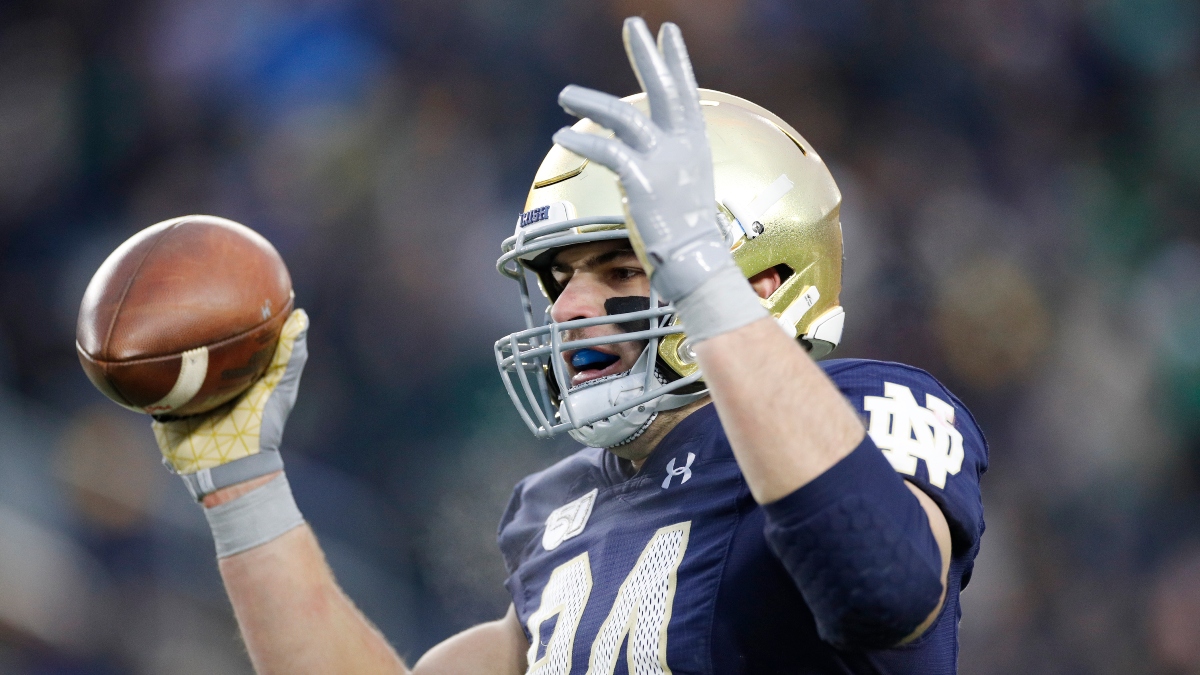
As a young two-sport athlete who didn't focus fully on football until 2019, when an elbow injury shelved his baseball career, Kmet should be able to develop enough as a route runner and blocker to be a functional three-down contributor.
Like most tight ends — even good ones — he will probably contribute little within his first couple of seasons. But he has top-five tight end potential and could offer great value in rookie dynasty drafts if he slides down the board as fantasy investors focus on this year’s glut of wide receivers, running backs and quarterbacks.
NFL Prospect Comp: Kyle Rudolph but younger
TIER 4
17. Michael Pittman Jr., WR, Colts
- Draft Position: 2.34 | School: USC
- Height: 6’4” | Weight: 223 pounds
- 40-yard dash: 4.52 seconds
- 2020 Age: 23 | Class: Senior
- Recruitment Stars: 4
"Pittman": More like "fit, man" — amirite? Because it's a good fit … get it? N-E-Wayz …
Pittman will be an immediate starter in Indianapolis and a strong No. 2 option for a team that has craved a complementary receiver to pair with the speedy T.Y. Hilton for years. And as much as I love Hilton, he turns 31 years old this year and will be a free agent in 2021. This could be his last season with the Colts.
Pittman could the team's No. 1 receiver as early as next year.
While he went near the top of Round 2, Pittman actually had some Round 1 buzz entering the draft, and although I never thought he'd crack the top 32, it wasn't had to see why draftniks were enthusiastic about him: He's a big-and-athletic Power Five receiver with a physical playing style and an NFL bloodline as the son of a long-time professional running back.
That seems like the kind of guy the NFL would want.
A reserve player as a freshman and rotational receiver as a sophomore, Pittman emerged as a junior to lead the Trojans with 758 yards and six touchdowns receiving, and then as a senior he had a full-on breakout with a 101-1,275-11 receiving campaign in 13 games.
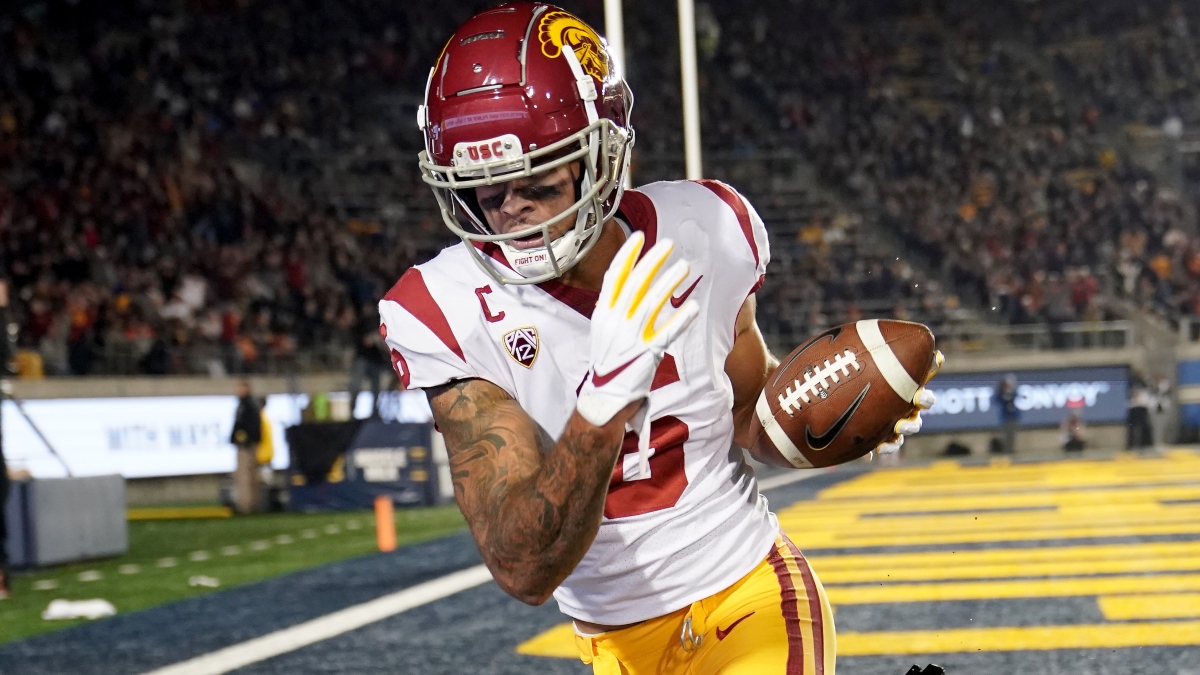
Pittman is somewhat limited in that he lined up heavily out wide to the left over the past two years: He's not a JuJu Smith-Schuster type of receiver who lines up all across the formation. And he's not the sharpest of route runners.
But Pittman is unbelievably physical at the catch point. He uses his large frame well to box out defenders on contested catches. He naturally high points the ball. He has a huge catch radius. And he has great hands: Throughout his college career, he dropped just five passes on 176 catchable targets (per PFF).
And although he's best on underneath and intermediate routes, he's an under-appreciated downfield receiver thanks to his ability to win in one-on-one situations.
Pittman has a disappointingly Mike Evans-esque inability to accumulate after-the-catch production: He's not quite a catch-and-fall specialist, but he doesn't do much once the ball is in his hands. But he still has the potential to be an elite NFL receiver.
In 2019, Pittman utterly outclassed the other top-eight receivers by draft rank in his man-on-man dominance of opposing cornerbacks, as evidenced by positive play rate vs. man coverage.
- Michael Pittman Jr.: 74%
- Justin Jefferson: 67%
- Tee Higgins: 62%
- Henry Ruggs III: 58%
- Jerry Jeudy: 48%
- CeeDee Lamb: 48%
- Brandon Aiyuk: 41%
- Jalen Reagor: 32%
With his ability to man up defenders, Pittman has a good chance to be a consistent chain-moving and touchdown-scoring NFL receiver, even if he's not an explosive yardage accumulator.
He has the upside for multiple 1,000-10 seasons.
NFL Prospect Comp: Marques Colston with major-program pedigree and way more draft capital
18. Denzel Mims, WR, Jets
- Draft Position: 2.59 | School: Baylor
- Height: 6’3” | Weight: 207 pounds
- 40-yard dash: 4.38 seconds
- 2020 Age: 23 | Class: Senior
- Recruitment Stars: 3-4
Someone had to go to the Jets. Unfortunately for Mims, it's hims.
You have to figure that if Mims is as talented as we think he is, he'll find a way to out-compete wide receivers Breshad Perriman and Quincy Enunwa and slot receiver Jamison Crowder for targets.
But even if Mims becomes the No. 1 receiver, he still might not have great production. Adam Gase has stifled and alienated talented receivers in the past — Jarvis Landry, Kenny Stills, DeVante Parker and Robby Anderson — and serious questions surround third-year quarterback Sam Darnold.
But at least Mims should get many of the targets vacated this offseason by Anderson, and outside of situation, Mims has a lot to recommend him to investors.
He is an elite athlete, as evidenced by his otherworldly 4.38-second 40-yard dash and position-best 6.66-second three-cone drill. He has the size to compete on contested catches. And he has multiple seasons of notable production at the FBS level (61-1,087-8 receiving in 2017; 66-1,020-12 receiving in 2019).
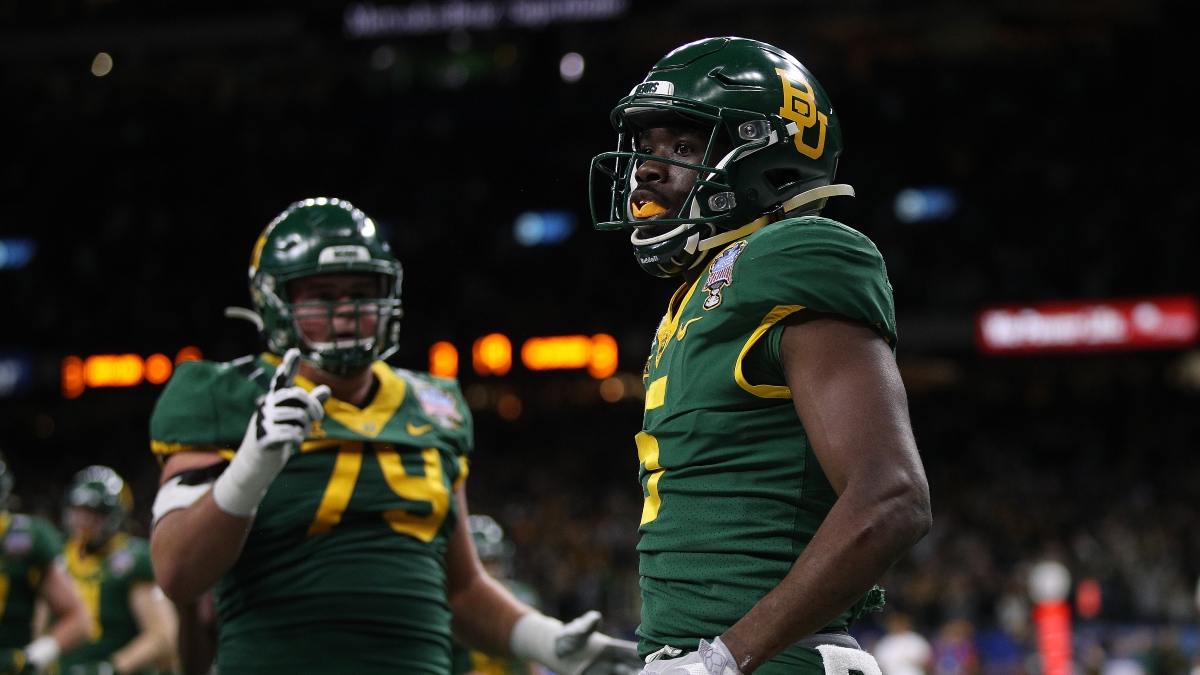
Mims isn’t a polished receiver. Coming from Baylor, he has a limited route tree. And over the past two seasons, he had an unsightly 12.9% drop rate (per PFF). But with his athleticism and skill set, he could be a top-five fantasy receiver in three years.
He has Chris Godwin-like potential.
If Mims wins in the NFL, it probably won’t be because he’s a smooth technician with jaw-dropping routes. It will be because he’s just so dominant as an athlete and aggressive at the catch point: In 2019, he finished No. 2 in the nation with 20 contested catches (per PFF).
Even a little improvement in his routes could go a long way. An outright track star, Mims needs to work on his release, sharpen his cuts and expand his repertoire beyond curls, fades and slants. Essentially, he needs to transition from a sprinter to a receiver.
And it wouldn't hurt if he got more work in the slot. In 2019, he played just 49 snaps in the interior; in 2018, zero. He's an outside-only receiver, and that restriction might limit his upside.
But even with his technical flaws, Mims is an enticing player. He can produce at all levels of the field, and with just a little more development, he could be a legitimate No. 1 wide receiver.
Because he's raw, he could certainly disappoint. He might never get even 800 yards in a season — especially with the Jets. But because of his talent, Mims might become a smaller Julio Jones-esque playmaker with a peak campaign of 1,600 yards.
NFL Prospect Comp: Martavis Bryant but with much more production
19. Chase Claypool, WR, Steelers
- Draft Position: 2.49 | School: Notre Dame
- Height: 6’4” | Weight: 238 pounds
- 40-yard dash: 4.42 seconds
- 2020 Age: 22 | Class: Senior
- Recruitment Stars: 4
It's hard to know what Claypool's role will be in 2020, given that the Steelers already have JuJu Smith-Schuster, James Washington and Diontae Johnson at wide receiver.
The Steelers have drafted a day two WR in four straight years.
2020- Claypool
2019- D Johnson
2018- Washington
2017- Smith-Schuster— Ryan McDowell (@RyanMc23) April 25, 2020
They also have Eric Ebron and Vance McDonald at tight end.
Targets might be hard to come by for Claypool in 2020, and it's always important to remember that caution is advisable with rookie receivers anyway. They need time to develop.
But if the Steelers were totally satisfied with their three wide receivers, you have to figure that they wouldn't have taken a fourth one in Round 2, right?
Smith-Schuster is slated to be a free agent in 2021; Washington, 2022. One way or another, there's a good chance that Claypool will eventually replace one of those guys in the starting lineup.
Or maybe he'll eventually replace Ebron and McDonald at tight end. They're both free agents in 2022, and Claypool — who is physically comparable to Darren Waller — has been projected to the NFL as a tight end by some scouts.
But I think he has the tools to be a professional wideout.
He's a perimeter-only receiver with average route-running technique, hands and after-the-catch production, but he is so physically dominant with his elite size, speed and explosiveness (per PP).
- Speed Score: 129.8 (99th percentile)
- Burst Score: 131.9 (92nd percentile)
Even if Claypool maxes out in the NFL as just a downfield specialist, he could still be a high-end producer thanks to his ability to beat overmatched cornerbacks in contested-catch situations.
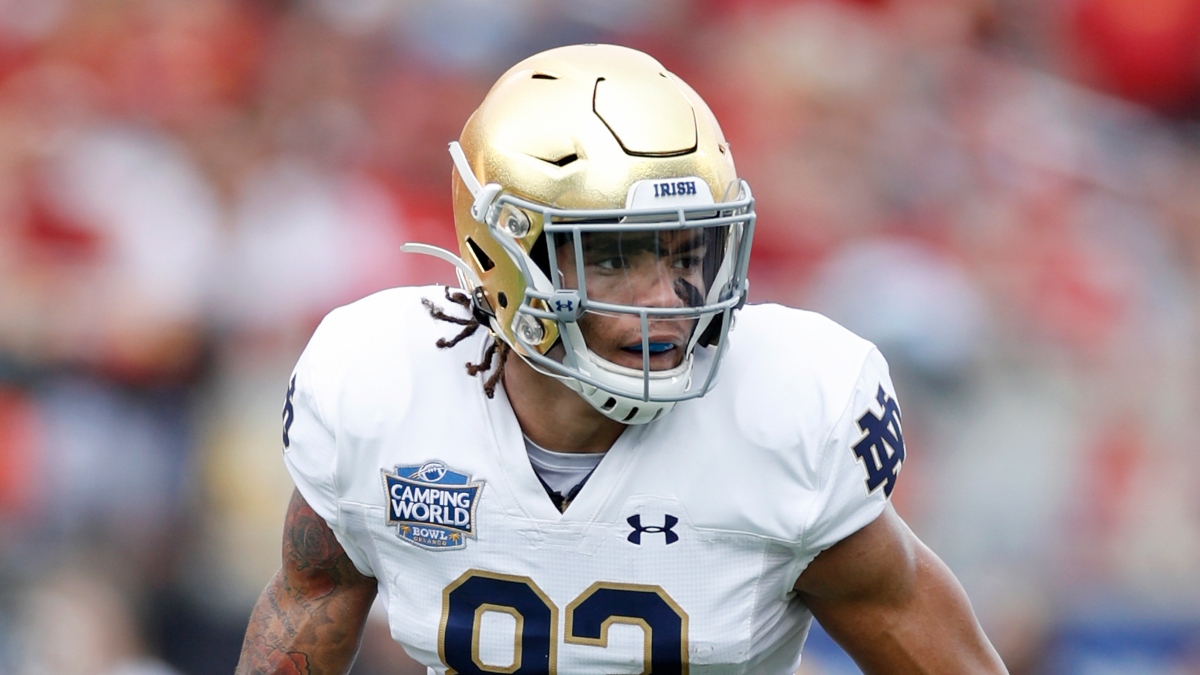
It might take Claypool some time to develop at the NFL level, but it's encouraging that he markedly improved each year at Notre Dame after playing primarily on special teams as a freshman (per PFF).
- 2017 (11 games): 61.4 PFF grade, 29-402-2 receiving on 45 targets
- 2018 (13 games): 69.1 PFF grade, 50-639-4 receiving on 73 targets
- 2019 (13 games): 83.3 PFF grade, 66-1,037-13 receiving on 108 targets
For his career, Claypool has been similarly effective against both man and zone defense (per SIS).
- Positive play rate vs. man: 59%
- Positive play rate vs. zone: 58%
And in 2019, he was just as effective as many of the top receivers in the class at turning targets into expected points added (EPA, per SIS).
- Chase Claypool: 0.50 EPA per target
- Brandon Aiyuk: 0.50 EPA per target
- Laviska Shenault Jr.: 0.41 EPA per target
- Michael Pittman Jr.: 0.36 EPA per target
- Denzel Mims: 0.34 EPA per target
- Jalen Reagor: -0.08 EPA per target
With his talent and skill set, Claypool has the potential for maybe a D.K. Metcalf-esque rookie season and a Mike Evans-lite career.
NFL Prospect Comp: Vincent Jackson with major-program pedigree but far less college production
20. K.J. Hamler, WR, Broncos
- Draft Position: 2.46 | School: Penn State
- Height: 5’9" | Weight: 178 pounds
- 2020 Age: 21 | Class: Redshirt Sophomore
- Recruitment Stars: 4
I should be higher on Hamler than I am: He might have the highest odds of NFL success of any Day 2 receiver, based on his young breakout age and college production.
But I don't like his landing spot in Denver.
Because of his playmaking ability and deep speed, Hamler will have some week-winning performances in 2020 and beyond, but he'll also be competing for targets for at least two more seasons with wide receivers Courtland Sutton and Jerry Jeudy and tight end Noah Fant.
And that doesn't even take into account the targets that will go to running backs Melvin Gordon and Phillip Lindsay, both of whom are above-average receivers.
There's a real chance that Hamler will never be anything more than a field-stretching complement, which means he could be very inconsistent. As a result, he's probably most investable in dynasty best ball.
Ultimately, Hamler feels like this generation's Deon Butler. Oh, you don't remember who that is?
That's my point.
Hamler is a college slot receiver with raw routes and the distinct inability to beat press coverage — and in the NFL, he might need to play on the perimeter, because the Broncos might seek to maximize Jeudy's matchups by giving him the majority of slot snaps.
And Hamler might struggle on the perimeter: If a defender gets his hands on Hamler before he builds up speed, he's neutralized. Essentially, he's a scheme- and usage-dependent producer, and he didn't have a wealth of production in his two years of playing time at Penn State (per PFF).
- 2018 (13 games): 42-754-5 receiving on 74 targets, 4-44-1 rushing
- 2019 (13 games): 56-904-8 receiving on 92 targets, 13-43-0 rushing
Hamler is a competent kick returner (23.5 yards per attempt for his career), and it's notable that he led the Nittany Lions in receiving in both his seasons.
But despite his versatility as a receiver, runner and returner, he's a limited player.
And here's the big problem: We don't have a 40 time for him because he didn't run at the combine. Everyone assumes that he's fast — but people made that same assumption about Jalen Reagor too. As a recruit, he ran a 4.43-second 40-yard dash, which is good, but he ran it at 156 pounds.
Now that he's 22 pounds heavier — and still small for an NFL receiver, by the way — we don't know for sure how fast he is.
And as a senior in high school, Hamler suffered a season-ending ACL tear, which caused him to redshirt his first year at Penn State.
So — in summation — Hamler is a production-deficient, scheme-reliant slot-bound receiver with uncertain athleticism and a problematic injury history.
I can see why the Broncos drafted him in Round 2. Frankly, with that kind of profile, I'm surprised he didn't go in Round 1.
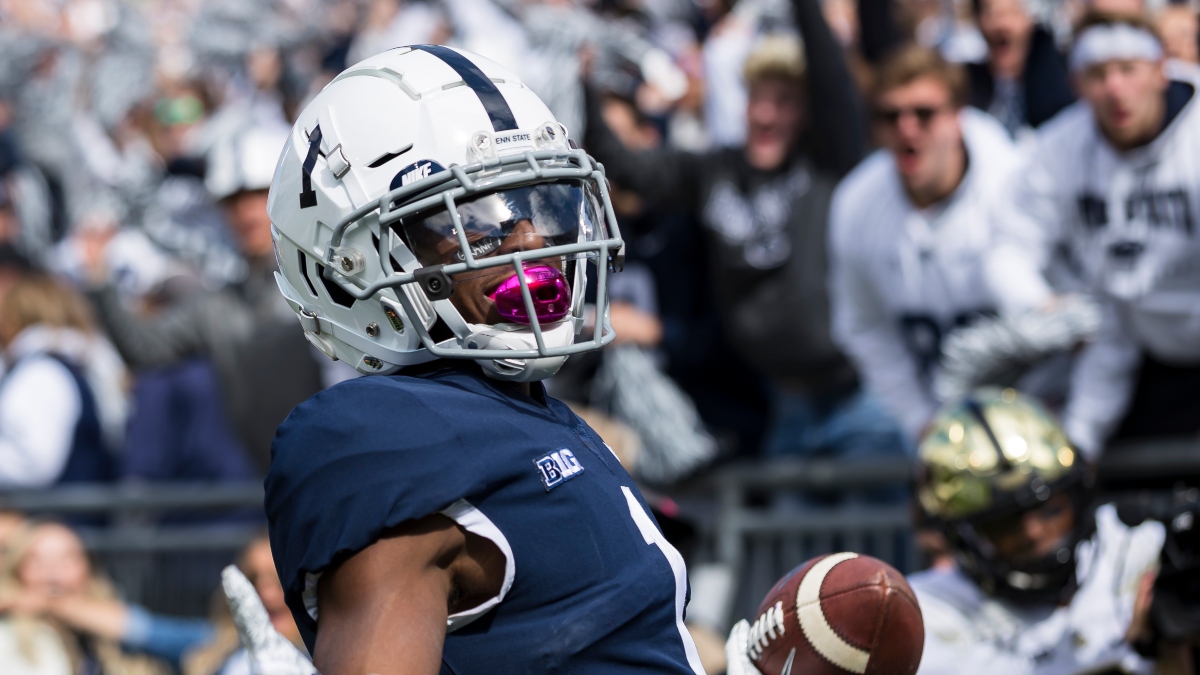
In all seriousness, Hamler is not untalented. Last year, he had at least a step of separation on 64% of his targets of 10-plus yards, good for the fourth-highest rate in the country. And since 2018, he has the fourth-most plays of 15-plus yards in the slot with 41 (per PFF).
Although I don't like to credit receivers with elite speed when we don't have a verified 40 time, it's undeniable that Hamler ran by a lot of defensive backs in college. He's a dynamic athlete.
And in 2019, Hamler was quite comparable to Ruggs against man coverage, judging by their positive play rates (per SIS).
- K.J. Hamler: 59%
- Henry Ruggs III: 58%
In fact, over the past two years, Hamler and Ruggs have had somewhat similar production.
- K.J. Hamler (26 games): 96-1,658-13 receiving on 166 targets, 17-87-1 rushing
- Henry Ruggs III (26 games): 86-1,487-18 receiving on 123 targets, 2-75-1 rushing
Ruggs is clearly the more explosive player — but he also has one more year of college experience.
They're both 21 years old. They're both speedsters. They're both top-50 picks. They were both highly recruited high-school stars.
If you really like Ruggs but aren't able to get him in your rookie drafts, take Hamler at a significant discount. He's likely to fail — but he's the arbitrage Ruggs.
NFL Prospect Comp: Ted Ginn but younger, shorter, less explosive as a return man and less invested with draft capital
TIER 5
21. Zack Moss, RB, Bills
- Draft Position: 3.86 | School: Utah
- Height: 5’9" | Weight: 223 pounds
- 40-yard dash: 4.65 seconds
- 2020 Age: 23 | Class: Senior
- Recruitment Stars: 3
Given his draft position, Moss is likely to carve out a significant role as the thunderous touchdown-scoring complement to starter Devin Singletary's lightning. As electric as he was last year, Singletary scored just four touchdowns.
But Singletary really flashed in 2019, especially in the second half of the season, when he put up 639 yards in the final eight games. There's a real chance that, for at least 2020, Moss will be nothing more than Alexander Mattison to Singletary's Dalvin Cook.
To me, Moss looks like an upside backup and maybe a lesser committee contributor. I have to acknowledge that there is significant enthusiasm around Moss in the scouting and draftnik communities, but I'm skeptical.
I appreciate that he was a strong producer for his three final collegiate campaigns.
- 2017 (13 games): 214-1,1173-10 rushing, 29-243-0 receiving on 35 targets
- 2018 (nine games): 179-1,096-11 rushing, 8-50-1 receiving on 10 targets
- 2019 (13 games): 235-1,416-15 rushing, 28-388-2 receiving on 31 targets
And based on a combination of his PFF rushing and receiving grades, missed tackles per carry, yards after contact per attempt and yards per route run, Moss is the No. 1 backfield prospect from the 2017-20 draft classes.
Top 10 in Average Ranking:
Zack Moss* – 2.5!🧐
Jonathan Taylor* – 7.75
Darrell Henderson – 8.25
Dalvin Cook – 8.75
Joe Mixon – 11.75
Kareem Hunt – 12
Josh Jacobs – 13
Rashaad Penny – 14.5
AJ Dillon* – 15.5
Saquon Barkley – 16.5* = 2020 RB Class
# = Average ranking per metric— Michelle Magdziuk (@BallBlastEm) April 17, 2020
PFF has him ranked as the most elusive back in the class and the No. 2 back overall. His profile in the PFF NFL Draft Guide is glowing.
Moss has been one of college football’s best running backs since his emergence as a true sophomore back in 2017. In each of the last three seasons, Moss has produced a PFF rushing grade that ranked among the 15 best at his position. He’s been one of the more elusive backs in that stretch, breaking 0.33 tackles per rush attempt, which was the third-highest rate. That’s very promising for his NFL future considering that trait translates from college to pro more than any other for ball carriers. He’s also produced the fifth-most explosive rushes of 10 or more yards since 2017, with 103 on his 626 carries. …
Moss ticks pretty much every box you'd like to see at the running back position except for speed. He's got the size, vision, hands, and especially elusiveness.
The player to whom PFF compares him is Kareem Hunt.
Ugh. I don't know.
I hate to go against the professional tape-grinding experts, because I openly admit that they know more than I do about what's happening on the field.
Moss and Hunt are physically comparable, and they probably have similar playing styles, but Moss is unlike Hunt in significant ways.
Hunt was younger as a rookie (22 years old), a four-year contributor (5,500 yards, 45 touchdowns) and a better pass-catching back (41-403-1 receiving in senior season).
In other words, Hunt was simply the superior prospect entering the league.
Without question, Moss is an above-average, well-rounded back who runs with balance, vision and physicality and catches the ball with adequacy. But that's what is always said about every over-hyped run-of-the-mill running back who gets drafted one year merely to be replaced the following year by yet another league-average back, who happens to look exactly like him.
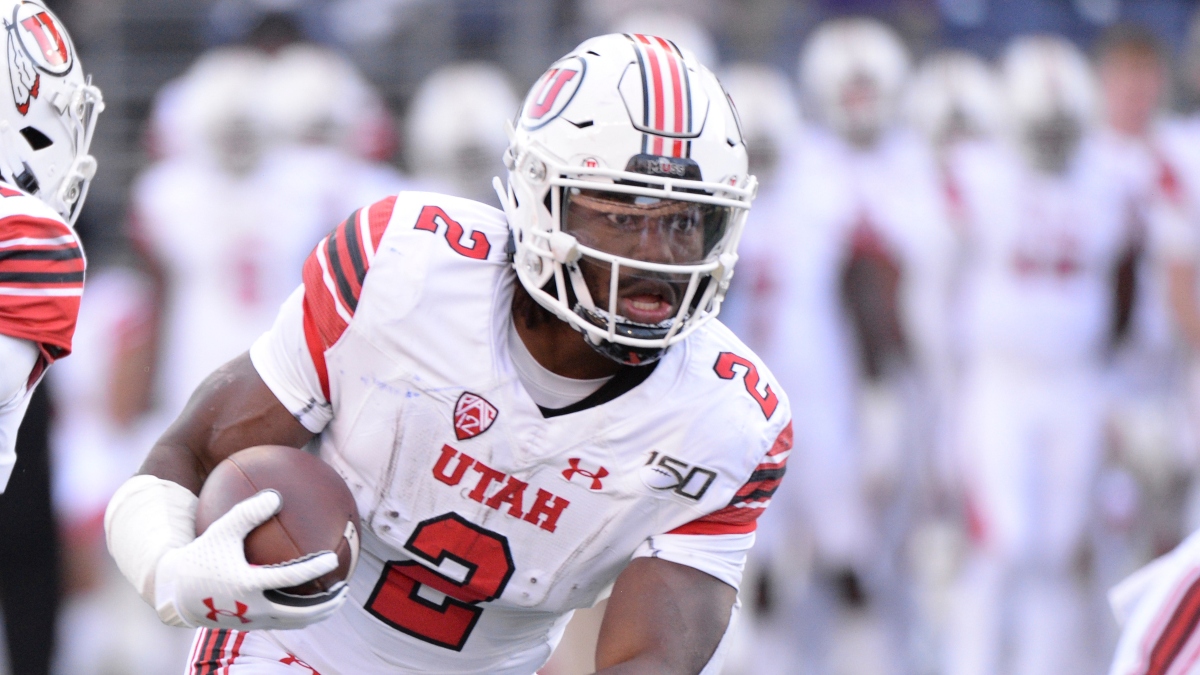
Moss might look like Hunt — but he also is pretty similar to Royce Freeman, Kenneth Dixon, Mike Davis, Robert Turbin and a whole host of backs people tend to forget.
And with backs who look like that, no one is very good at predicting which ones will have NFL success and which ones won't.
Moss might be an effective starter and fantasy contributor one day — but he's someone I will strongly consider fading in rookie drafts.
If I'm wrong, I can live with it.
NFL Prospect Comp: Montee Ball with a thicker, more compact frame and less production, program pedigree and draft capital
22. Ke'Shawn Vaughn, RB, Buccaneers
- Draft Position: 3.76 | School: Vanderbilt
- Height: 5’10” | Weight: 214 pounds
- 40-yard dash: 4.51 seconds
- 2020 Age: 23 | Class: Redshirt Senior
- Recruitment Stars: 3-4
UPDATE (Aug. 7): I have bumped Vaughn down from Tier 3 to Tier 5, which is pretty much where I wanted to rank him after the draft — but I felt the pressure of the entire dynasty community to bump Vaughn up my board, and I am nothing if not a man of the people. But now that the Bucs have signed LeSean McCoy and head coach Bruce Arians has tapped Ronald Jones as the "main guy," I am now free to move Vaughn down to where he belongs.
Where are all the Ke'Shawn Vaughn truthers from May?
— Matthew Freedman (@MattFtheOracle) August 5, 2020
You hate to see it.
This is a straight-up appeasement pick. If I have Vaughn any lower in my rankings, I'll have to forfeit my status as a card-carrying member of the dynasty industry guild.
The situation is ostensibly good for Vaughn in Tampa Bay.
He's bigger than third-year running back Ronald Jones, and he might be the better receiver, given his 41-440-3 pass-catching stat line in his two years as the lead back for the Commodores.
It's not hard to envision a scenario in which he wins the starting job, and there's a lot of enthusiasm in the industry for what Vaughn could accomplish as the lead back in an offense led by quarterback Tom Brady.
I’ve seen tweets calling Ronald Jones a winner from last night, and that he could still be starter. Keep in mind:
– Vaughn the superior pass-catcher
– Jones wasn’t drafted by this regime
– Vaughn has the frame to take on a decent-sized workload
– Jones isn’t very good— JJ Zachariason (@LateRoundQB) April 25, 2020
If we compare what Jones and Vaughn did in college, there's no question that Vaughn looks a lot better.
Have charted 57 RBs over the last 5 years for Yards Created.
– Ronald Jones: 3.97 YC per carry in 2017 at USC ranks 54th-of-57 RBs
– Ke’Shawn Vaughn: 5.41 YC per carry in 2019 at Vanderbilt ranks 16th-of-57
— Graham Barfield (@GrahamBarfield) April 25, 2020
But it's worth keeping in mind that Jones was significantly younger as a college prospect. In fact …
Cough, whispers: Ronald Jones is younger than Ke'Shawn Vaughn.
— Matthew Freedman (@MattFtheOracle) April 26, 2020
… well, that's interesting.
You know, it occurs to me that — as a general rule — older players with no NFL experience generally don't replace younger players with two seasons of professional service. Especially when the same general manager drafted both players, the younger guy at pick No. 38 and the older guy at pick No. 76. And especially when the same coach just saw the younger back get 1,000-plus scrimmage yards the year prior.
People are acting as if Jones is trash. He was admittedly horrible as a rookie (23-44-1 rushing, 7-33-0 receiving), but he was dealing with injuries, and the entire team was bad that year in the final season of head coach Dirk Koetter's tenure. With Bruce Arians in 2019, Jones had 1,033 scrimmage yards and six touchdowns on just 203 touches.
Other than Jones (and Saquon Barkley), only 23 other backs selected in Rounds 1-3 have had 1,000-plus scrimmage yards as 22-year-old second-season players (per Pro Football Reference). These guys are among the most elite in NFL history.
The first four guys on the list: Jim Brown, Walter Payton, Barry Sanders and Emmitt Smith.
The four most recent guys, right before Jones and Barkley, who did it last year: Todd Gurley, Ezekiel Elliott, Joe Mixon and Christian McCaffrey.
What did these 23 guys do the year after putting up 1,000 yards at the age of 22?
They dominated.
With the exception of Le'Veon Bell and Edgerrin James — both of whom played only six games because of injury, and both of whom returned to form in their fourth seasons — only one of the 22-year-old 1,000-yard producers failed to lead his team's backfield the following season: Marshawn Lynch in 2009, when he was benched in Buffalo and replaced by the 28-year-old veteran overachiever Fred Jackson.
You can say that Jones isn't comparable to Lynch or McCaffrey or anyone else in the cohort. That might be fair.
Counterpoint: I can say that Vaughn isn't comparable to F-Jax, who had five 1,000-yard campaigns in his career and was literally seven years removed from college when he took over for Lynch in 2009.
Vaughn is a rookie. A 23-year-old third-round rookie.
I shouldn't have to say this, but based on how people are currently viewing Vaughn, I guess I do.
This is a reminder that 23-year-old third-round RBs should probably be drafted after 21-year-old first- and second-round WRs in dynasty.
— Matthew Freedman (@MattFtheOracle) April 25, 2020
Over the past 20 years, only three backs to enter the league as 23-year-old third-rounders have had multiple seasons of NFL success: DeMarco Murray (2011, 3.71), Brian Westbrook (2002, 3.81) and Reuben Droughns (2001, 3.81).
I'm just going to assert out of hand that Vaughn is not Murray or Westbrook, both of whom were far superior as receivers in college.
- Brian Westbrook (46 games): 219 receptions, 2,582 yards receiving
- DeMarco Murray (50 games): 157 receptions, 1,571 yards receiving
- Ke'Shawn Vaughn (46 games): 66 receptions, 648 yards receiving
Yeah … not even close.
But if you want to say that Vaughn has some Droughns-esque potential … haha … sure, you do that.
By the way, Droughns had only 258 scrimmage yards in his first three NFL seasons and didn't accomplish anything in the NFL until Broncos HC Mike Shanahan decided to trade away lead back Clinton Portis and go cheap at the position.
But, yeah, Droughns is definitely the guy you want to hang your Vaughn hat on.
You can say that Vaughn is better than Jones as a receiver. He certainly was more productive in the passing game in college.
- Ke'Shawn Vaughn (46 games): 66 receptions, 648 yards receiving
- Ronald Jones (40 games): 32 receptions, 302 yards receiving
But last year Jones had a 31-309-0 receiving line on 40 targets — while splitting snaps with Ronald Jones and Dare Ogunbowale. That's not bad.
Are we sure that Vaughn can do better than that? Maybe he can, but of the two backs, Jones is the only who has faced major league pitching, you know what I mean?
I don't want to be in the position of needing to make a case against Vaughn — because entering the draft, I actually liked him as a prospect.

As an 18-year-old freshman at Illinois, he led his team in rushing with 723 yards on 157 carries. After he transferred to Vanderbilt, he had two productive seasons against tough SEC competition while playing on a subpar team (6-7 in 2018, 3-9 in 2019). Per SIS:
- 2018 (12 games): 157-1,244-12 rushing, 12-168-2 receiving on 17 targets
- 2019 (12 games): 198-1,028-9 rushing, 29-286-1 receiving on 34 targets
Vaughn is a no-nonsense powerful runner and a competent all-around football player.
But he doesn't make guys miss as a runner, and as a receiver, let's not pretend as if he's great. Per SIS: "He isn't a great route runner and runs most of his routes out of the backfield in the form of check & release, swing and screen routes."
If Vaughn had landed with any other team in the third round — literally any other team — people would not be talking about how underrated he is.
The circumstances look good for him in Tampa Bay … but circumstances can be hard to evaluate, and circumstances can change.
People are assuming that he'll be able to beat out Jones for the lead job — and, again, I can easily see how it could happen — but what if he doesn't?
What if the guy who had 1,000 yards last year and was selected with the higher pick and has two years of NFL experience and one year of credit with the coaching staff and is actually younger — what if that guy turns out to be the better NFL player?
If you like Vaughn, go ahead and draft him. Hopefully he does well for you. But I fear he'll turn out to be just another 23-year-old third-round back.
I want to draft guys at a discount, and if I have to draft Vaughn in Round 1, I won't be getting him on the cheap — and I don't know why anyone would want to pay up for an older third-round running back who doesn't have 100% unobstructed path to playing time.
NFL Prospect Comp: Kenneth Dixon with more draft capital and a little more speed but much less production
23. Lynn Bowden, RB/WR, Raiders
- Draft Position: 3.80 | School: Kentucky
- Height: 5’11" | Weight: 204 pounds
- 2020 Age: 23 | Class: Junior
- Recruitment Stars: 3-4
Bowden worked out with the wide receivers at the combine, but he was announced as a running back when the Raiders drafted him.
Unlike Gibson, Bowden doesn't have lead back potential, and he'll probably be used as more of a gadget player and return man than a regular pass-catching change-of-pace back.
A do-it-all weapon. 💥
With the 80th pick, we have selected WR Lynn Bowden Jr. from @UKFootball. pic.twitter.com/O5MR1iXWD8
— Las Vegas Raiders (@Raiders) April 25, 2020
But I still like him, and he could develop into either a starting slot receiver or a No. 2 back, because he's a talented player.
To put this in proper perspective: My mom's name is Lynn … and I might love Lynn Bowden more than my mother. If she had won the 2019 Paul Hornung Award as the nation's top all-purpose player and been named a first-team All-American for her all-around play, maybe I'd appreciate her.
But let's get down to business.
Bowden was a high-school dual-threat quarterback who rushed for 2,277 yards, passed for 1,366 yards and scored 57 total touchdowns as a senior, but he was recruited to college as a converted wide receiver.
After playing as a supplementary offensive weapon and return man as a freshman …
- Receiving: 17-210-0
- Rushing: 12-37-0
- Passing: 3-of-4 for 92 yards, 0-1 TD:INT ratio
- Kick Returning: 37-869-0
… Bowden broke out as a sophomore slot man with a team-leading 67-745-5 receiving line, to which he added 9-25-0 rushing and two punt return touchdowns. For the season, he had a 79.5 PFF receiving grade and was a dynamic after-the-catch producer with 7.7 YAC per reception and 17 missed tackles forced as a receiver.
As a junior, Bowden was poised to build upon his previous pass-catching campaign, but in the middle of the team's fifth game, he had to shift to quarterback because of injuries, and he stayed there for the rest of the season, going 6-2 as the starter and leading Kentucky to the postseason and a bowl victory.
While Bowden failed to impress as a thrower — he went 32-of-70 passing for just 364 yards and a 3-to-3 touchdown-to-interception ratio as a starter — he absolutely crushed as a wildcat runner.
In his eight full games at quarterback, Bowden rushed for 1,369 yards and 13 touchdowns on 172 attempts. He led all non-running backs with his 87.2 PFF rushing grade, and he bested most backs with his 0.3 broken tackles per carry.
And what did Bowden do in the first four games of 2019, before the team needed him to shift to quarterback? He had 385 yards from scrimmage and a touchdown on 27 receptions and seven carries: Not bad.
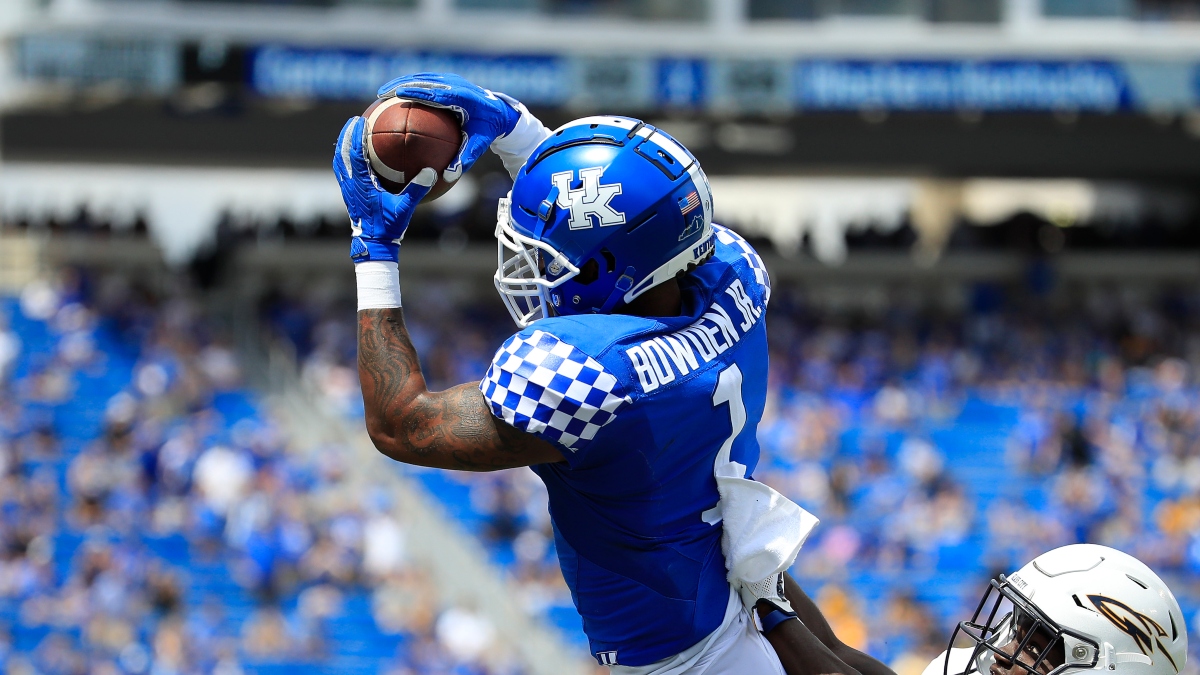
As an offensive weapon, Bowden will need to be schemed the ball. In addition to traditional halfback runs, we're talking about wildcat carries, jet sweeps, short routes and screens — and that likely limits his upside.
But he's my kind of player: His versatility speaks to his overall skill set and on-field ability, and he simply finds a way to produce.
And even though he's being listed as a running back now, I think he ultimately might end up at receiver. As a sophomore, he had a dominant 30% target share while playing 85% of his snaps in the slot (per SIS.
He has actual receiver capability, and the Raiders have a wide open depth chart at the position. If Bowden ever catches on in the slot, he could have a couple of top-24 fantasy seasons.
NFL Prospect Comp: Randall Cobb but older and thicker
24. Joe Burrow, QB, Bengals
- Draft Position: 1.01 | School: LSU
- Height: 6’3” | Weight: 221 pounds
- 2020 Age: 24 | Class: Redshirt Senior
- Recruitment Stars: 4
I like Burrow, but I don't place a high value on quarterbacks outside of the 2QB/superflex format, so I won't think about Burrow until the very end of Round 2, and even then, I'll take him only if one of the players ranked Nos. 1-23 isn't available.
In almost all single-quarterback leagues, Burrow shouldn't be drafted until Round 3.
He's almost certain to start in Week 1, but unlike Kyler Murray last year, Burrow is not a dual-threat option, and so his scoring potential is capped.
Against subpar opponents, Burrow will likely have some startable weeks as a rookie, but not until 2021 is he likely to be a reliable fantasy producer.
It certainly helps that he has an under-appreciated wide receiver unit in A.J. Green, Tyler Boyd, John Ross and second-rounder Tee Higgins and two strong receiving backs in Joe Mixon and Giovani Bernard.
At this point, there's not much that needs to be said about Burrow.
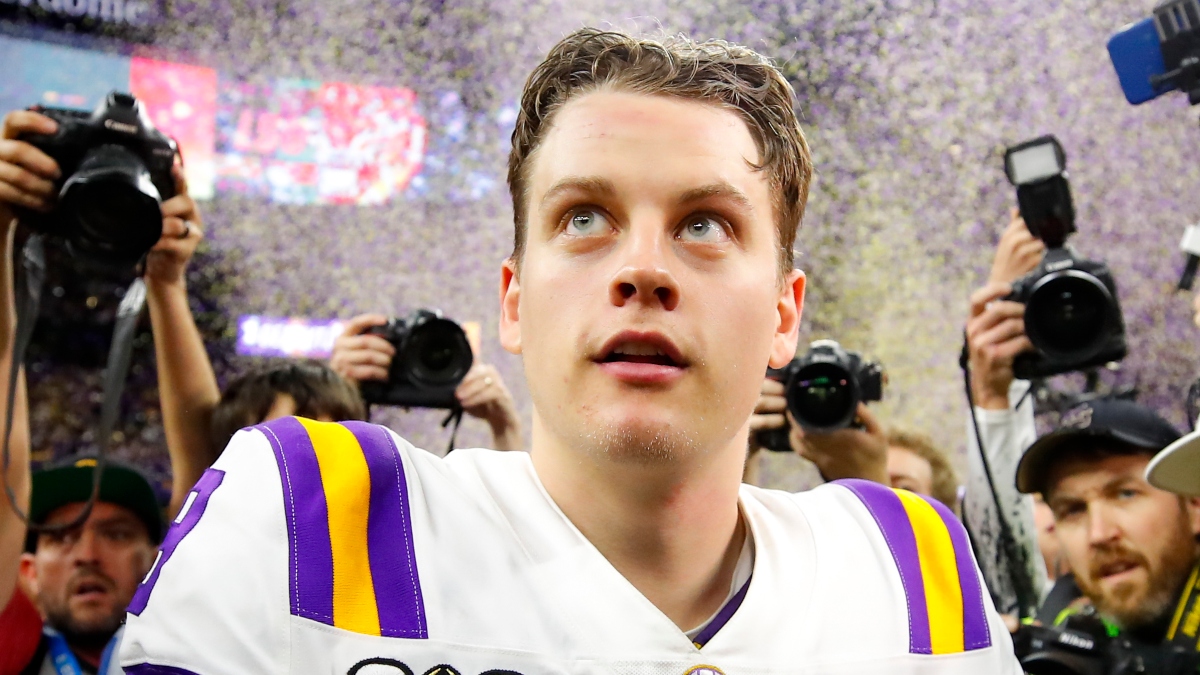
He's a Heisman Trophy-winning redshirt senior quarterback who went No. 1 overall to the Cincinnati Bengals and suits up as a 24-year-old rookie after a dominant final college season in which he turned two unknown underclassmen into 1,000-yard producers.
Wait, that is Joe Burrow, right?
Wrong. That's 2003 Carson Palmer.
His receivers? The original Mike Williams and Keary Colbert.
As the wise man says, "Time is a flat circle."
History reminds us that we should keep our quarterback expectations in check. Even though Palmer was the No. 1 overall pick, he didn't even play as a rookie, and in his second season, he passed for just 2,897 yards and had an 18-18 touchdown-to-interception ratio.
In 2019, Burrow had probably the greatest passing season ever for a collegiate quarterback with 5,671 yards and 60 touchdowns to six interceptions. His 76.3% completion rate and 12.5 adjusted yards per attempt were immaculate.
But I doubt strongly Burrow will be any better than a low-end fantasy QB1 in 2020 — and even that seems like a stretch. With Burrow, patience is advisable.
I am, though, optimistic about Burrow's long-term potential. In 2005, Palmer's second season as a starter, he was the No. 1 overall fantasy quarterback, and even after his serious knee injury in the 2005-06 playoffs, he was the the fantasy QB5 and QB9 for the 2006-07 seasons.
Burrow isn't a dual-threat quarterback, but he is functional as a runner (3.2 yards per carry, including sacks, at LSU), and he has the pocket presence and accuracy to be perhaps a Tom Brady-esque impact passer: Last year, he led all draft-eligible passers with his 83% on-target rate (per SIS).
Burrow needs to work on his eye discipline: Sometimes he stares down his receivers, and he rarely manipulates defenders out of position with his eyes. And even though he started for two seasons at LSU, he is the epitome of a one-year wonder.
But, again, I like Burrow's long-term potential and see him as a perennial QB1 in fantasy with top-five upside at his peak.
NFL Prospect Comp: Baker Mayfield with less youth and starting experience but superior size and peak production
TIER 6
25. Bryan Edwards, WR, Raiders
- Draft Position: 3.81 | School: South Carolina
- Height: 6’3” | Weight: 212 pounds
- 2020 Age: 22 | Class: Senior
- Recruitment Stars: 4
UPDATE (Aug. 7): I have come around on Edwards and decided to bump him up a couple of spots. He broke out as an 18-year-old freshman, and he could see more playing time as a rookie than I originally expected given the recent report that Henry Ruggs III will start the season in the slot.
Like former teammate Deebo Samuel, Edwards never had a truly dominant seasons for the Gamecocks, but he's a four-year SEC starter who had a small breakout as a freshman and then consistently produced in his three final seasons.
- 2017 (13 games): 64-793-5 receiving on 106 targets
- 2018 (13 games): 55-846-7 receiving on 94 targets
- 2019 (10 games): 71-816-6 receiving on 111 targets
A lot of his production came on screens, so he might not be an NFL-ready player, and he struggled to win consistently in one-on-one matchups. But he's a big-bodied physical receiver, and even though he didn't work out at the combine, he had a 4.53-second 40 as a recruit at 209 pounds, so he's probably athletic enough.
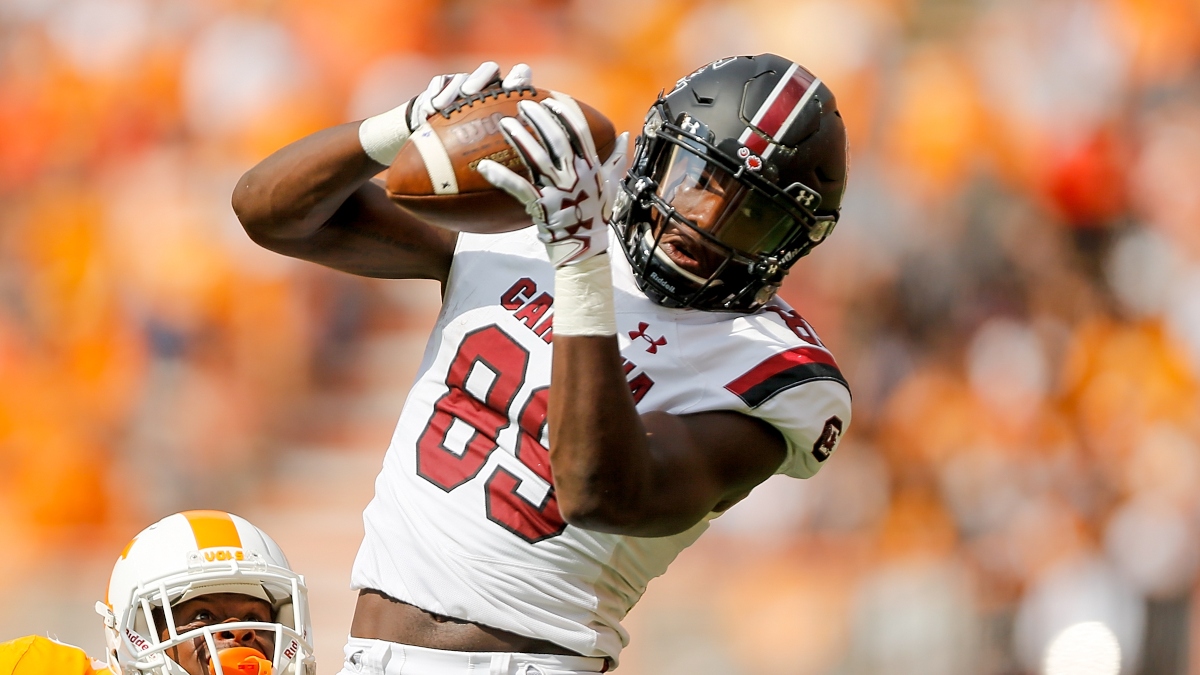
He might not play much as a rookie, but Zay Jones is in the final year of his contract, and the Raiders could easily part ways with Tyrell Williams after the seasons, which means that in 2021, Edwards could be a starting receiver for the Raiders alongside the first-rounder Ruggs and slot man Hunter Renfrow.
NFL Prospect Comp: Brandon LaFell but significantly younger
26. Devin Duvernay, WR, Ravens
- Draft Position: 3.92 | School: Texas
- Height: 5’10” | Weight: 200 pounds
- 40-yard dash: 4.39 seconds
- 2020 Age: 23 | Class: Senior
- Recruitment Stars: 4
Duvernay was a steady if underwhelming contributor with 70-1,082-7 receiving in his three years at Texas, but as a senior he shifted into the slot, where he played 96% of his snaps (per SIS), and he broke out with a strong 106-1,386-9 receiving performance on 129 targets.
He also chipped in with 10-24-1 rushing and 10-205-0 kick returning in his final season.
With his elite speed, Duvernay will be able to stretch defenses vertically, and there could be targets to go around, given that the Ravens entered the draft with the No. 1 overall opportunity receiving score.
An Albert Wilson-esque slot man in his style of play, Duvernay could challenge veteran incumbent Willie Snead for playing time this year, and with Snead in the final season of his contract, Duvernay could be the starting slot receiver for quarterback Lamar Jackson in 2021.
NFL Prospect Comp: Josh Huff but much faster
27. Van Jefferson, WR, Rams
- Draft Position: 2.57 | School: Florida
- Height: 6’1” | Weight: 200 pounds
- 2020 Age: 24 | Class: Redshirt Senior
- Recruitment Stars: 4
An Ole Miss recruit, Jefferson actually played ahead of A.J. Brown and D.K. Metcalf as a redshirt freshman in 2016, putting up a 49-543-3 receiving line, but in 2017, he fell behind Brown, Metcalf and also DeMarkus Lodge, so he transferred to Florida.
Because he graduated from Mississippi in three years, Jefferson was able to play right away for the Gators, and he's led the team in receiving in each of the past two years.
- 2018 (11 games): 35-503-6 receiving
- 2019 (12 games): 49-657-6 receiving
I'll be honest: This is a humility ranking. I'm putting Jefferson at No. 28 because he's a second-round pick, and he has a decent chance to play a lot of the snaps vacated by the traded Brandin Cooks.
But he's a 24-year-old mid-sized receiver who never flashed in college. That's not the type of player I value. He can play inside and outside, and he's a smooth route runner with above-average speed, but he's not at all physical, and I doubt he'll be able to compete against NFL corners.
Maybe I'm wrong. It's promising that he had a 76% positive play rate vs. man coverage last year (per SIS).
NFL Prospect Comp: Deon Cain but older and with significantly more draft capital
28. Tua Tagovailoa, QB, Dolphins
- Draft Position: 1.05 | School: Alabama
- Height: 6’ | Weight: 217 pounds
- 2020 Age: 22 | Class: Junior
- Recruitment Stars: 4-5
UPDATE (Aug. 16): Tagovailoa has bumped up another tier.
UPDATE (Aug. 7): Tagovailoa bumps up from the bottom of Tier 7 to the top of it thanks to the recent reports that he has been cleared to return to football activities.
The Dolphins actually did tank for Tua, after all.
I like the landing spot for Tagovailoa in Miami. I doubt that he will play in 2020, as the Dolphins will want to give him as much time as possible to recover from his hip injury, but he should be able to learn on the bench as a rookie behind veteran journeyman Ryan Fitzpatrick, who should be a willing and intelligent mentor.
And whenever Tagovailoa gets the starting job in 2021, he'll have wide receivers DeVante Parker and Preston Williams and tight end Mike Gesicki at his disposal.
On the whole, it's a very positive situation for Tagovailoa, and maybe the best he could have hoped for after a potentially career-threatening hip injury in November ruined his hopes of going No. 1 overall.
His talent is unquestioned: In his abbreviated junior campaign, Tagovailoa completed 71.4% of his passes and had an elite 13.4 adjusted yards per attempt (AY/A).
If you look at the SIS quarterback leaderboards, you'll see Tagovailoa at the top of several key statistics for 2019.
- Yards per attempt: 11.3 (1st)
- Independent quarterback rating: 146.6 (1st)
- Expected pointed added per dropback: 0.49 (1st)
And of course Tagovailoa's numbers are almost as good for 2018, when he completed a nice 69.0% of his passes for 3,966 yards, a 12.8 AY/A and a 43-6 touchdown-to-interception ratio.
- Yards per attempt: 11.2
- Independent quarterback rating: 140.6
- Expected pointed added per dropback: 0.43
For context: Burrow had only 0.39 expected points per dropback last year. Tagovailoa has bested that number twice.
But he also has massive injury concerns.
For Tagovailoa to be the better player, he actually has to be able to play. In the words of Aldous Snow, "How can you read when you are blind?"
It looks as if Tagovailoa is recovering well.
Practicing social distancing with the long ball today. Feels good to spin it again. #Processpic.twitter.com/BZnBF7Sfdc
— Tua. T 🇦🇸 (@Tuaamann) March 24, 2020
But multiple teams reportedly were worried about Tagovailoa’s health throughout the lead-up to the draft.
https://t.co/rYm5U1TEgXpic.twitter.com/baIJLb23gS
— Michael Lombardi (@mlombardiNFL) April 8, 2020
It's hard to know if that was all a smokescreen, but there's no question that Tua carries medical questions with him.
He has dealt with all manner of injuries over the past two years (broken finger, sprained knee, strained quad, twisted ankles, dislocated and fractured hip). More than a few NFL evaluators reportedly believe that Tagovailoa is fragile. Brittle. Too small to be a dependable starter.
And that might be the case.
His talent, though, is too immense to ignore. He might be the best quarterback in the class. Throughout his entire college career, he almost never played bad football.
He's definitely worth a speculative selection in Round 3 of rookie drafts, because if NFL evaluators are wrong, he could be a big hit.
Tagovailoa doesn't have elite arm strength, but he's highly accurate to most areas of the field, quick with his delivery and careful with the ball. He's an anticipatory thrower and an above-average scrambler.
He has perennial top-12 upside and "It's too bad Tua couldn't stay healthy" downside.
I'm comfortable betting on his potential.
NFL Prospect Comp: Drew Brees but left-handed and with more draft capital
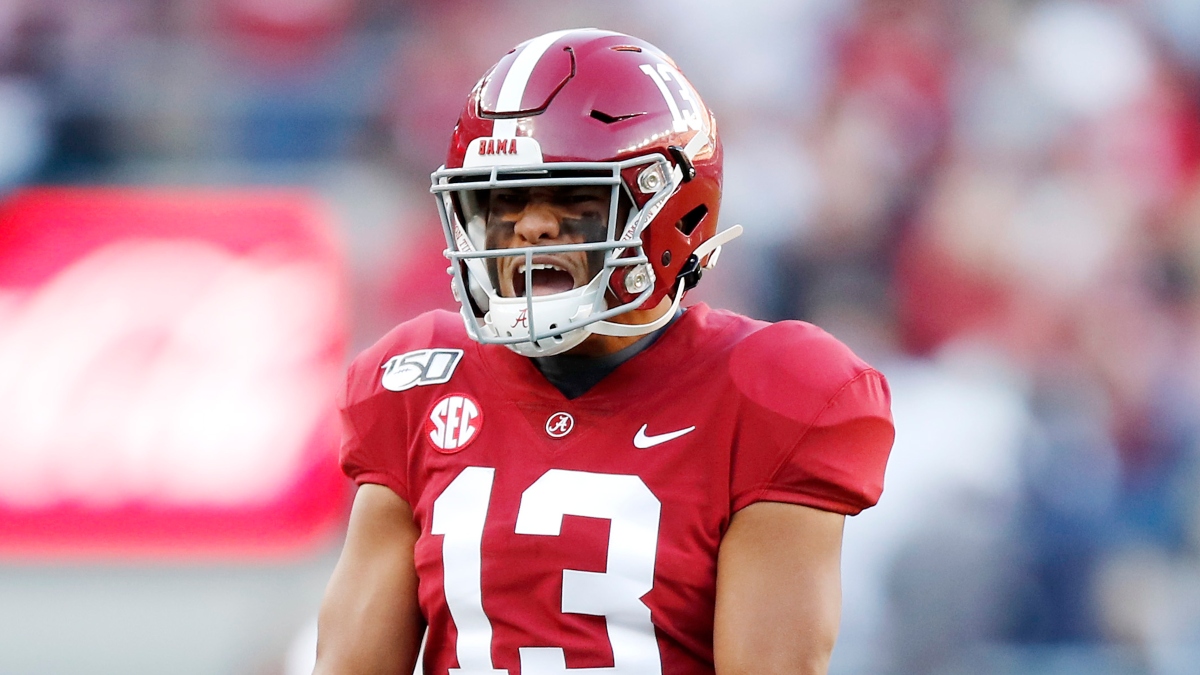
29. Darrynton Evans, RB, Titans
- Draft Position: 3.93 | School: Appalachian State
- Height: 5’10” | Weight: 203 pounds
- 40-yard dash: 4.41 seconds
- 2020 Age: 22 | Class: Redshirt Junior
- Recruitment Stars: 2
UPDATE (Aug. 16): Evans has bumped up another tier.
UPDATE (Aug. 7): I have bumped Evans up from Tier 8 to Tier 7. His ranking is still significantly lower than his average draft position, so it's not as if I'm making a massive correction, but I was probably too pessimistic about Evans in the immediate aftermath of the draft.
Maybe I should have Evans higher in the rankings: He's a top-100 pick who is slated to be the direct backup to the volume-ridden franchise-tagged starter on a run-heavy team.
If Derrick Henry were to suffer an injury in 2020 or leave after the season, Evans could be incredibly productive, because he has great athleticism, and in college he was a dynamo.
- 2017 (12 games): 48-217-0 rushing, 6-34-0 receiving
- 2018 (13 games): 179-1,187-7 rushing, 12-87-1 receiving
- 2019 (14 games): 255-1,480-18 rushing, 21-198-5 receiving
To this production, he's also added three kick return touchdowns. But my sense is that Evans is intended to be a long-term backup and change-of-pace option to Henry, and that doesn't interest me.
I'd just rather draft a wide receiver, tight end or quarterback who slides down the board.
NFL Prospect Comp: Joe McKnight with more production but no major-program pedigree
TIER 7
30. Dalton Keene, TE, Patriots
- Draft Position: 3.101 | School: Virginia Tech
- Height: 6’4” | Weight: 253 pounds
- 40-yard dash: 4.71 seconds
- 2020 Age: 21 | Class: Junior
- Recruitment Stars: 3
UPDATE (Aug. 7): I have dropped Keene from Tier 6 to Tier 7, but his ranking is still markedly above his nearly nonexistent average draft position. He remains criminally undervalued and has potential as a 2020 fantasy sleeper.
As mentioned in the earlier analysis on Kmet, 21-year-old tight ends are rare — although they've become less rare in recent years — and Day 2 is a decent place to dig for tight end value.
Ahead of Keene on the Patriots' depth chart are Matt LaCosse and Ryan Izzo — fellow third-round selection Devin Asiasi is also in the mix. LaCosse is an undrafted 28-year-old veteran with 403 yards in his career, and Izzo is a second-year seventh-round who had nine targets last year.
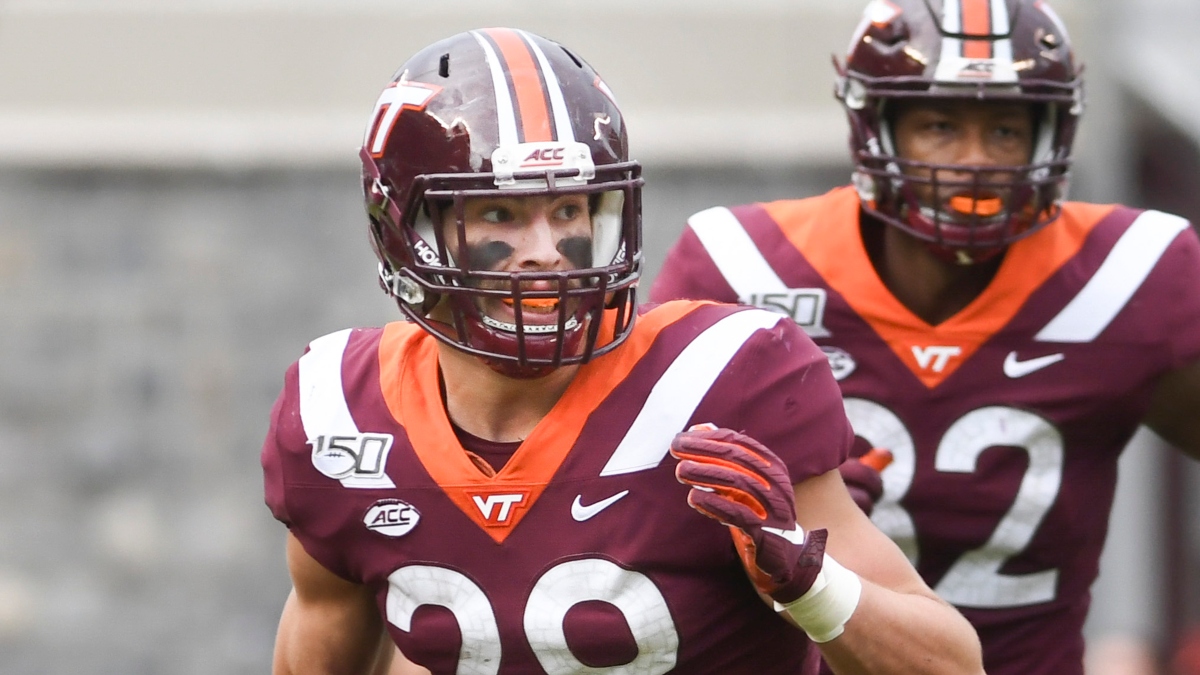
Asiasi is billed as more of the receiving tight end, as Keene was just 21-240-5 receiving on 26 targets last year, but I think Keene has some underrated pass-catching potential. He can line up inline and in the slot, and for his career he averaged and impressive 9.7 yards after the catch per reception (per SIS).
He has an 81st-percentile 117.6 SPARQ-x score (per PP). In the RV Combine Explorer, Austin Hooper is the closest physical comp, and in the RV Prospect Box Score, Mark Andrews pops up as one of his five closest comps based on physical profile, college production and draft position.
Like all tight ends, he will need time to develop, but he has potential.
NFL Prospect Comp: Ian Thomas but younger
31. Devin Asiasi, TE, Patriots
- Draft Position: 3.91 | School: UCLA
- Height: 6’3” | Weight: 257 pounds
- 40-yard dash: 4.73 seconds
- 2020 Age: 23 | Class: Redshirt Junior
- Recruitment Stars: 4
UPDATE (Aug. 7): Asiasi has jumped up from Tier 9 to Tier 7, as I was simply way too low on him. Now he's more in line with his average draft position. I still prefer Keene, as Asiasi simply does not look the part on tape (said the guy who knows nothing about breaking down football), but I shouldn't have been so quick to ignore a guy whose fourth-closest comp in RV Prospect Box Score Scout is Travis Kelce.
Asiasi was drafted 10 picks before the aforementioned Keene, and of the two, he's generally thought as of more of the pass-catching tight end. But he's less athletic and older, and his final season, though fine, was nothing remarkable (44-641-4 receiving in 12 games).
Asiasi might beat out Keene for the starting job in New England, but I'd rather back the guy with the advantage in age and athleticism since they have similar draft capital.
I should say that the RV Prospect Box Score Scout has some intriguing player comps, including Mark Andrews, Martellus Bennett, Aaron Hernandez and Jordan Reed.
But if you watch Asiasi play, he just doesn't look like those guys. Maybe I'm wrong, but I just don't see it. Neither does Mike Renner of PFF: "He profiles as a No. 2 tight end off the bat in the NFL, but I wouldn't expect too much more."
Renner comps Asiasi to Michael Hoomanawanui. To me, that seems about right.
NFL Prospect Comp: Austin Hooper but older and less productive and less skilled as a route runner
32. Albert Okwuegbunam, TE, Broncos
- Draft Position: 4.118 | School: Missouri
- Height: 6’5” | Weight: 258 pounds
- 40-yard dash: 4.49 seconds
- 2020 Age: 22 | Class: Redshirt Junior
- Recruitment Stars: 3
There are a number of factors going against Albert O: Tight ends take a while to develop anyway, he dropped out of Day 2, and he's now buried on the depth chart behind a second-year first-rounder.
TE Albert Okwuegbunam going to the Broncos at 4.118.
Stuck behind Noah Fant, one of his closest pre-draft comps.
Not ideal.
— Matthew Freedman (@MattFtheOracle) April 25, 2020
But on the positive side, at least Okwuegbunam is reuniting with college quarterback Drew Lock, who threw Albert O. an SEC-high 11 touchdowns in his 2017 redshirt freshman season.
If Fant falls out of favor in Denver, perhaps Okwuegbunam will be able to step up and produce.
If you invest in Albert O., you should do so with the long term in mind. If he breaks out at all, it will likely be in 2022 at the earliest, and it's difficult to anticipate the circumstances that might lead to such a breakout.
But he's probably still worthy of investment because of his immense talent: Okwuegbunam is Okwuegbunawesome.
At the combine, he blazed an amazing 4.49-second 40, which puts him in incredibly elite company. Over the past 15 years — about as far back as the league has reliable combine data — these are the players to run faster than a 4.55-second 40-yard dash and be drafted in the first five rounds.
- Vernon Davis (2006, 1.06): 4.38 seconds
- Evan Engram (2017, 1.23): 4.42 seconds
- Jared Cook (2009, 3.89): 4.50 seconds
- Noah Fant (2019, 1.20: 4.50 seconds
- O.J. Howard (2017, 1.19): 4.51 seconds
- Greg Olsen (2007, 1.31): 4.51 seconds
- George Kittle (2017, 5.146): 4.52 seconds
- Ladarius Green (2012, 4.110): 4.53 seconds
- Mike Gesicki (2018, 2.42): 4.54 seconds
It's hard to find a cohort much better than that.
Athleticism means so much at the tight end position, and Okwuegbunam is rarely gifted with his physical abilities: The tight end prospect of the past 20 years to whom Albert O. is most comparable — based only on combine measurables — is two-time All-Pro Travis Kelce. The overall prospect to whom he's most physically similar? Former All-Pro edge rusher Robert Quinn (per MD).
In the best of ways, Okwuegbunam is a true freak.
In the RV Prospect Box Score Scout, three of his 10 most comparable players are Kittle, Kelce and Martellus Bennett.
I think Okwuegbunam was criminally under-drafted at No. 118. Entering the draft, he was No. 39 in Gil Brandt's Hot 150, and given how connected Brandt is in the league, his rankings usually reflect the NFL's valuation of most rookies.
In Brandt's estimation, Okwuegbunam is a "take-a-chance prospect who is 70% boom and 30% bust."
I agree. NFL teams were pigheaded not to make him a top-100 pick.
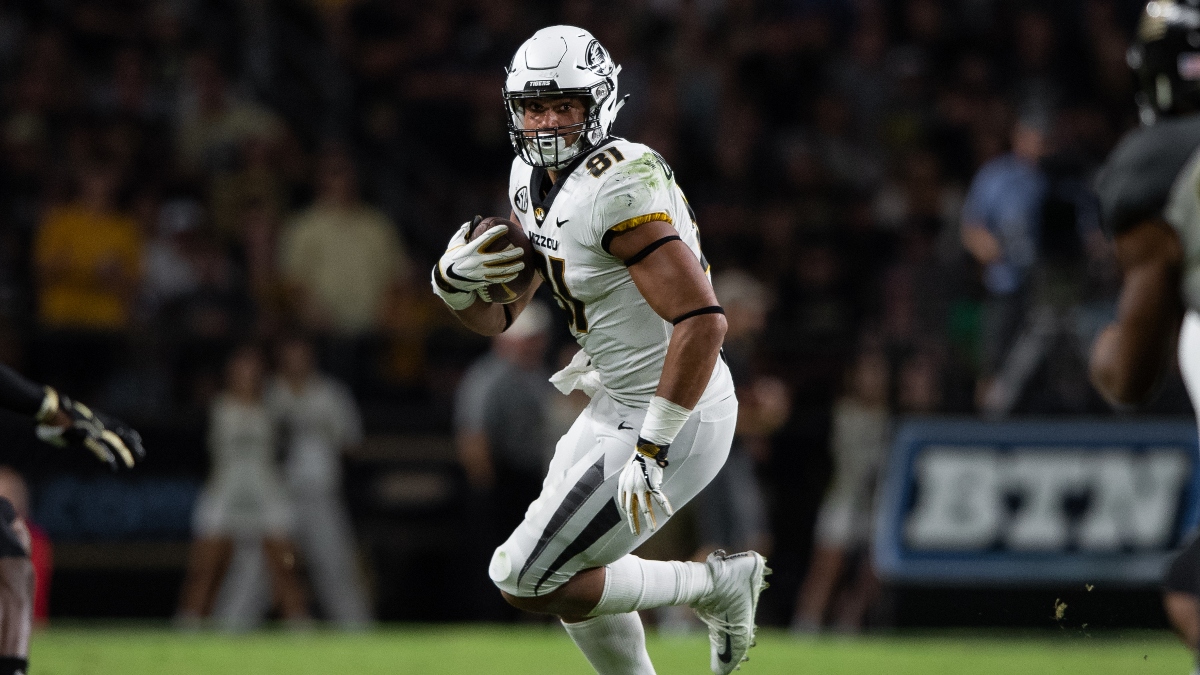
If he had declared last year, Albert O. might have been a first-rounder as a 21-year-old redshirt sophomore à la David Njoku in 2017. But he instead returned to Missouri, where he missed games and struggled with a shoulder injury for a second consecutive season. And so he slipped in the draft, even though his masterful combine performance gave him a position-high 99 Draft Score from Next Gen Stats.
Albert O. isn't much of a blocker or route runner, but he has near-elite above-the-rim ability at the catch point and matches up incredibly well with linebackers and defensive backs alike.
A massive boom/bust prospect, Albert O. has No. 1 overall tight end upside and “I can’t believe I thought that guy was good” downside.
I don't mind betting on his upside this late in the draft.
NFL Prospect Comp: Jimmy Graham but more productive and two years younger with a little less draft capital.
33. Adam Trautman, TE, Saints
- Draft Position: 3.105 | School: Dayton
- Height: 6’5” | Weight: 255 pounds
- 40-yard dash: 4.80 seconds
- 2020 Age: 23 | Class: Redshirt Senior
- Recruitment Stars: 0
Another tight end. Please contain yourself.
A high-school quarterback, Trautman received no interest from FBS scouts, so he enrolled at Dayton, took a redshirt year, converted to tight end and quickly became one of the best tight ends in college football.
- 2016 (11 games): 24-238-3 receiving
- 2017 (11 games): 43-537-5 receiving
- 2018 (11 games): 41-604-9 receiving
- 2019 (11 games): 70-916-14 receiving
As a senior, Trautman had a position-high 94.2 PFF grade and played all across the formation: Inline, on the wing, in the slot and out wide.
Trautman isn't fast, but he is notably quick for his size, as evidenced by his 95th-percentile 11.05 agility score (per PP). And he's not a great blocker, but he's functional. He's a fairly well-rounded player
The issue with Trautman is that he played at a small school, so his production and ability might not translate to the NFL, and even if he does develop into a starter, by the time that happens, quarterback Drew Brees will almost certainly be retired.
He's worth drafting at the end of Round 3, but, like Albert O., he's a speculative investment.
NFL Prospect Comp: Dallas Goedert with less draft capital and maybe less speed
34. Gabriel Davis, WR, Bills
- Draft Position: 4.128 | School: UCF
- Height: 6’2” | Weight: 216 pounds
- 40-yard dash: 4.54 seconds
- 2020 Age: 21 | Class: Junior
- Recruitment Stars: 3
I'd be happy to get Davis at the end of Round 3. He's young, big and adequately athletic, and he improved each year of college.
- 2017 (10 games): 27-391-4 receiving on 44 targets
- 2018 (12 games): 53-815-7 receiving on 92 targets
- 2019 (12 games): 72-1,241-12 receiving on 132 targets
Even though Davis isn't a burner, he can get deep with his 13.6-yard average depth of target (per SIS), and despite playing outside at a mid-major school, he might be able to hang with NFL corners.
He put a show on against respected Stanford cornerback Paulson Adebo last year, and in his two games against Power Five opponents last year, he was 14-214-3 receiving.
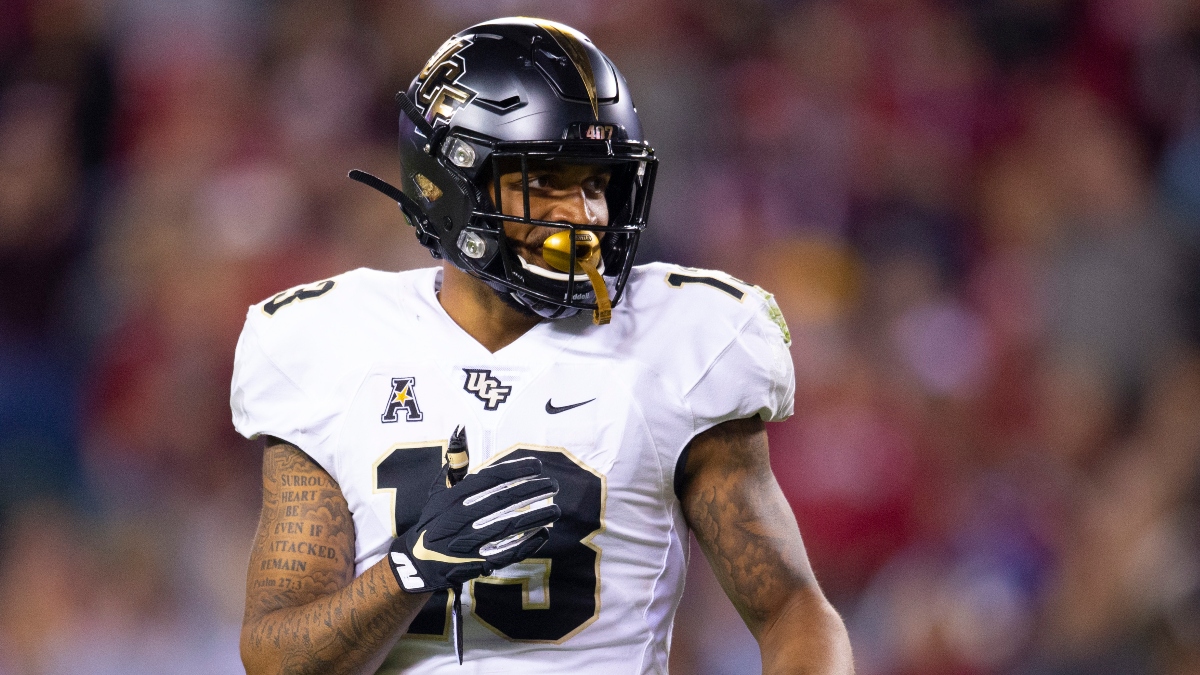
Davis is inconsistent, but he has upside. In the RV Prospect Box Score Scout, one of his five closest comps on the basis of draft position, physical profile and college production is JuJu Smith-Schuster.
One of his 10 most comparable players is Michael Thomas.
If the team parts ways with John Brown or Cole Beasley over the next two years, Davis could find his way into the starting lineup.
NFL Prospect Comp: Jaelen Strong but slower and with less draft capital
35. Antonio Gandy-Golden, WR, Redskins
- Draft Position: 4.142 | School: Liberty
- Height: 6’4” | Weight: 223 pounds
- 40-yard dash: 4.60 seconds
- 2020 Age: 22 | Class: Senior
- Recruitment Stars: 2
Gandy-Golden isn't fast per se, but he has good speed and explosiveness for his size (per PFF).
- Speed score: 103.7 (80th percentile)
- Burst score: 124.7 (70th percentile)
Thanks to his size, AGG is a better-than-expected downfield receiver, as evidenced by his 92.4 PFF deep grade, and he's frequently targeted deep with his 14.0-yard average depth of target (per SIS).
In the RV Prospect Box Score Scout, Kenny Golladay, Courtland Sutton and Eric Decker are among his 10 most comparable players, and while those players might seem like a stretch, Gandy-Golden has the collegiate production to match them.
- 2017 (10 games): 69-1,066-10 receiving
- 2018 (11 games): 71-1,037-10 receiving
- 2019 (13 games): 79-1,396-10 receiving
Gandy-Golden isn't much of a separator, so he might struggle downfield in the NFL, but he has the potential to be a reliable possession receiver opposite No. 1 receiver Terry McLaurin, and all that stands between AGG and a starting spot right now is second-year sixth-rounder Kelvin Harmon.
I think that's a competition AGG can win. In fact …
NFL Prospect Comp: Kelvin Harmon but taller, younger, more productive and more invested with draft capital
36. Tyler Johnson, WR, Buccaneers
- Draft Position: 5.161 | School: Minnesota
- Height: 6’1” | Weight: 206 pounds
- 2020 Age: 22 | Class: Senior
- Recruitment Stars: 3
I don't want to be hyperbolic, but Johnson has a non-zero chance of being quarterback Tom Brady's starting slot receiver this year. That job is currently occupied by Chris Godwin — but Johnson is a slot savant, and Godwin can line up anywhere.
Bucs head coach Bruce Arians is a sharp thinker, and he might decide that — even with Godwin's slot success last year — the team's best three-receiver alignment for 2020 is Mike Evans and Godwin on the perimeter and Johnson in the middle.
It's not likely, but it's possible.

Johnson feels like Brady's kind of receiver. He's not fast or particular agile, but he's maybe the best route runner in the class and strong at making tough catches in traffic.
Even with his lack of athleticism, he has been an outstanding producer for the past three years, especially based on Dominator Rating (a player's market share of team receiving yards and touchdowns, per RV).
- 2017 (10 games): 76.6 PFF, 35-677-7 receiving, 62% Dominator Rating
- 2018 (13 games): 89.6 PFF, 78-1,169-12 receiving, 51% Dominator Rating
- 2019 (13 games): 91.8 PFF, 86-1,318-13 receiving, 40% Dominator Rating
He might have gone late in the draft, but Johnson has the production profile of a first-rounder and the route-running technique of an NFL veteran.
NFL Prospect Comp: Corey Davis with a little less size and far, far less draft capital
TIER 8
37. Justin Herbert, QB, Chargers
- Draft Position: 1.06 | School: Oregon
- Height: 6’6” | Weight: 236 pounds
- 40-yard dash: 4.68 seconds
- 2020 Age: 22 | Class: Senior
- Recruitment Stars: 3
It's hard to know what Herbert's role will be with the Chargers in 2020. I expect that he will open the season as the backup behind journeyman Tyrod Taylor but will eventually "pull a Baker Mayfield" and send Taylor to the sideline.
But whether that happens in Week 2 or Week 12 is anyone's guess. Either way, I expect him to enter 2021 as the locked-in starter … but that doesn't mean I'll be starting him in fantasy.
Right after the 2019 season, Herbert was a tier below Burrow and Tagovailoa in draftnik conversations, but after his Senior Bowl MVP performance and combine workout, he was locked in as a top-three quarterback and top-six pick.
Although Herbert is generally thought of as a strong-armed pocket passer — and that’s true — that’s not all he is. At the combine he had impressive top-three positional marks with a 4.68-second 40, 35.5-inch vertical jump, 123-inch broad jump and 7.06-second three-cone drill.
The dude is an actual athlete: He might be a version of Josh Allen who is more of a thrower and less of a runner.
That said, now that I've done more research, I'm not sure how much I want to play up the running angle. Herbert averaged 2.4 yards per carry in college (including sacks), and that's respectable, but last year he had -4.2 expected points added as a rusher (per SIS). He has the raw tools to be a competent runner in the NFL, but it's troubling that he cost his team points when he left the pocket.
And it's also less than ideal that he failed to develop as a passer at Oregon. Based on the raw numbers (completion rate, yards passing and touchdown-to-interception ratio), Herbert ended his four-year college career with his best season.
- 2016 (eight games): 63.5% | 1,936 yards | 19-4 TD:INT
- 2017 (eight games): 67.5% | 1,983 yards | 15-5 TD:INT
- 2018 (13 games): 59.4% | 3,151 yards | 29-8 TD:INT
- 2019 (14 games): 66.8% | 3,471 yards | 32-6 TD:INT
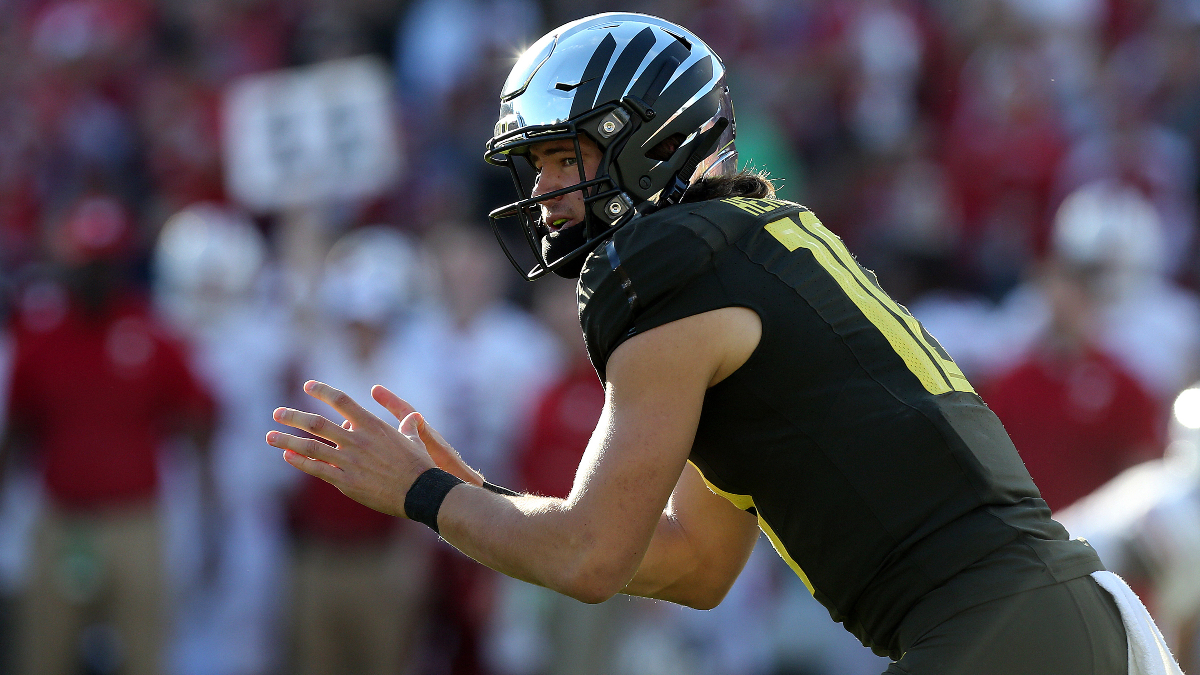
In a vacuum, there's nothing wrong with what Herbert did last year. And he did finish with a career-high 55.7 expected points added as a passer. But his 2019 efficiency was unremarkable, based on his adjusted yards per attempt (AY/A) and expected points added per dropback (per SIS).
- 2016 (eight games): 8.4 AY/A | 0.11 EPA
- 2017 (eight games): 10.0 AY/A | 0.18 EPA
- 2018 (13 games): 8.3 AY/A | 0.11 EPA
- 2019 (14 games): 9.0 AY/A | 0.13 EPA
Herbert simply failed to mature as a passer in college. He entered 2018 as a strong candidate to be the No. 1 pick in the 2019 draft, but he regressed, and so he returned for his senior season, in which he rebounded ever so slightly but clearly failed to reach the heights of his sophomore campaign.
With his size, arm strength and pocket-focused playing style, Herbert looks like an NFL quarterback. But he makes questionable decisions, progresses slowly through his reads and loses his technique when pressured. He's more of a thrower than a passer — and that's not what you'd hope for from a four-year Power Five starter — and over the past two years, he has "developed his reputation for coming up small in big games" (per PFF).
I used to think that he would be a fine candidate to be the No. 1 overall pick if not for Burrow and Tagovailoa. Now, I'm not so sure.
Because quarterbacks are so important, Herbert deserved to go in the top 10 of the NFL draft. I am, however, rather skeptical about his future.
He should go in Round 3 of rookie dynasty drafts for the simple reason that he's a first-round quarterback, but he has a very Josh Rosen-esque feel to him. Even late in Round 3, I'm not at all desirous to take him.
NFL Prospect Comp: Jared Goff with more size and college experience
38. Anthony McFarland, RB, Steelers
- Draft Position: 4.120 | School: Maryland
- Height: 5’8” | Weight: 208 pounds
- 40-yard dash: 4.44 seconds
- 2020 Age: 22 | Class: Redshirt Sophomore
- Recruitment Stars: 4
Over the past three years, the Steelers have drafted James Conner, Jaylen Samuels and Benny Snell, all of whom are still on the roster, so they probably didn't need to draft McFarland, but Conner is in the final year of his contract, and McFarland adds decent depth.
If Samuels and Snell disappoint in 2020 and Conners leaves in free agency, McFarland could get a shot to start in 2021. He's undersized, but he is thickly built and has an 85th-percentile 107.0 speed score (per PP).
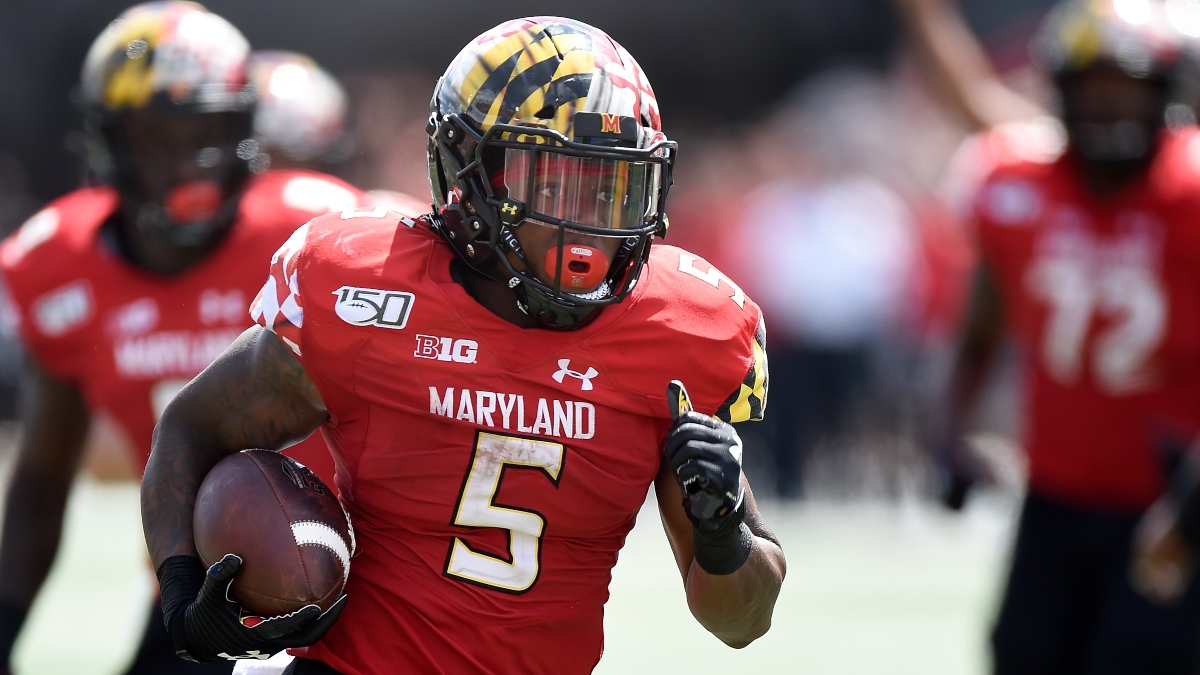
He was moderately productive in college and flashed as a freshman, but his sophomore season underwhelmed and he hasn't developed in the passing game.
- 2018 (12 games): 131-1,034-4 rushing, 7-73-0 receiving
- 2019 (11 games): 114-614-8 rushing, 17-126-1 receiving
Based on his collegiate usage, McFarland will probably never be a lead back in the NFL. But with his physical profile, he might have some success if he randomly gets the job.
NFL Prospect Comp: Devonta Freeman with more athleticism but much less production
39. Joshua Kelley, RB, Chargers
- Draft Position: 4.112 | School: UCLA
- Height: 5’11” | Weight: 212 pounds
- 40-yard dash: 4.49 seconds
- 2020 Age: 23 | Class: Redshirt Senior
- Recruitment Stars: 2-3
Kelley is a physical, straight-ahead runner who will likely slot on as the big-bodied backup and change-of-pace short-yardage grinder to No. 1 back Austin Ekeler.
Overlooked coming out of high school, Kelley played two years at Cal-Davis as a backup before transferring to UCLA, redshirting per NCAA rules and then stepping up to play as the No. 1 back for his two final seasons.
- 2015 (10 games): 106-530-3 rushing, 1-10-0 receiving, 22-574-0 kick returning
- 2016 (11 games): 87-609-4 rushing, 3-11-0 receiving, 23-559-1 kick returning
- 2018 (11 games): 225-1,243-12 rushing, 27-193-0 receiving
- 2019 (11 games): 229-1,060-12 rushing, 11-71-1 receiving
He's not much of a receiver, but Ekeler will handle most of the pass-catching workload anyway.
In the RV Combine Explorer, the back to whom he's most physically comparable is Miles Sanders. If Kelley somehow gets the starting job, he'll have some upside.
NFL Prospect Comp: Jamaal Williams with more speed
TIER 9
40. Jordan Love, QB, Packers
- Draft Position: 1.26 | School: Utah State
- Height: 6’4” | Weight: 224 pounds
- 40-yard dash: 4.74 seconds
- 2020 Age: 22 | Class: Redshirt Junior
- Recruitment Stars: 2-3
The circle of life in one tweet.
Jordan Love to the Packers at No. 26.
Aaron Rodgers just got Favre'd.
— Matthew Freedman (@MattFtheOracle) April 24, 2020
If Love starts a game in 2020 outside of Week 17, the Packers will probably not be pleased. The same goes for his fantasy investors.
Dana Carvey impersonating President George H.W. Bush puts it best: "Not gonna do it. Wouldn't be prudent at this juncture." Or any juncture.
At no point, in the history of this universe or any other universe, is Love likely to be on a fantasy team of mine.
Sure, he has great “tools.” His arm is strong. He can make all the throws required of an NFL quarterback … except for the accurate ones.
Love looked great as a sophomore in 2018, completing 64.0% of his passes with 9.4 adjusted yards per attempt (AY/A) and a 32-6 touchdown-to-interception ratio. But he massively regressed in 2019.
There are, of course, extenuating circumstances. There always are. After the 2018 season, head coach Matt Wells left for Texas Tech, and new head coach Gary Andersen tried to run Wells’ offense so that Love wouldn’t need to learn a new scheme.
Basically, that meant Love was playing for a coach who didn’t know what he was doing. And most of the offensive starters from the 2018 season graduated, so Love was playing with new guys in 2019.
It’s easy to see why and how Love’s final college season underwhelmed.
But here’s the thing about postmortem analysis: The body is still dead.
Love was bad in 2019. There’s no getting around it. His completion percentage dropped to 61.9%. His AY/A plummeted to 6.4. And his interception total screamed up to a nation-high 17 as his touchdown total sagged to 20.
And here's what's most disqualifying in all of this: His 2018 season — his breakout campaign — wasn't all that good anyway.
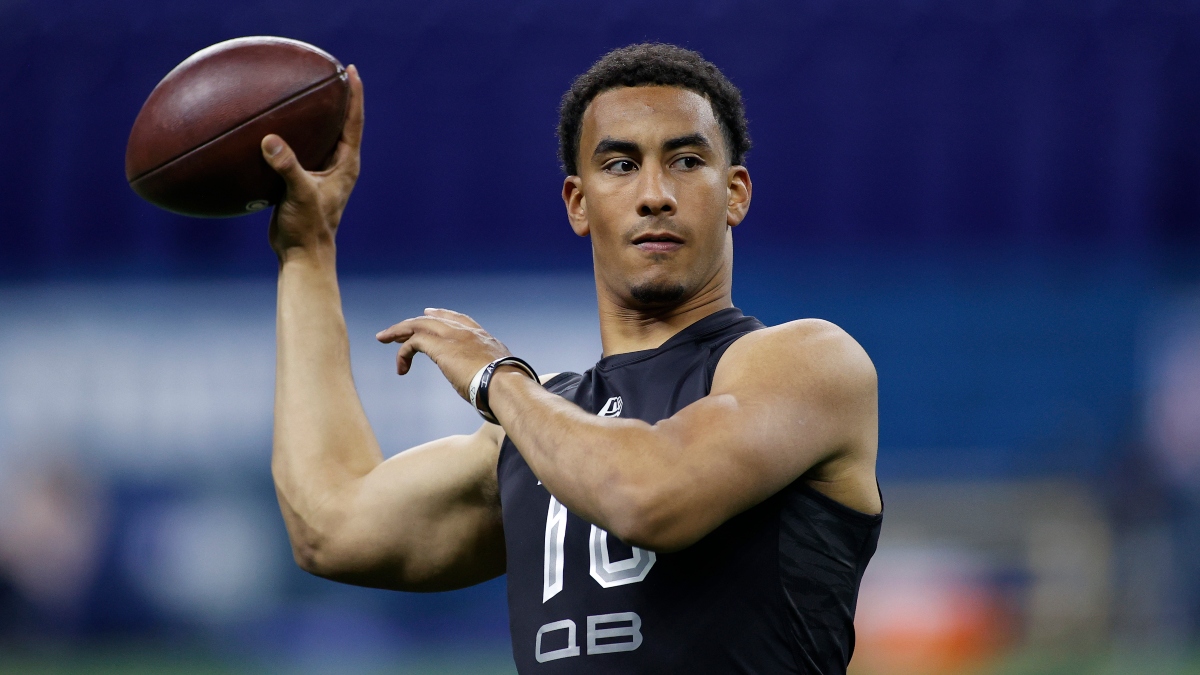
What Love did in his best season doesn't compare at all to what Burrow did in 2019. Or what Tagovailoa did in 2018-19. Or Jalen Hurts in 2019 — at least based on a number of metrics, including AY/A, average depth of target (aDOT), independent quarterback rating (IQR), catchable ball rate (Cbl%) and expected points added (EPA) as a passer, runner and per dropback (per SIS).
- Love (2018): 9.4 AY/A | 8.8 aDOT | 120.3 IQR | 80% Cbl% | 95.4 paEPA | 6.7 ruEPA | 0.22 EPA/db
- Burrow (2019): 12.5 AY/A | 9.1 aDOT | 145.3 IQR | 91% Cbl% | 215.1 paEPA | 26.0 ruEPA | 0.39 EPA/db
- Tagovailoa (2019): 13.4 AY/A | 8.3 aDOT | 146.6 IQR | 87% Cbl% | 133.8 paEPA | 3.4 ruEPA | 0.49 EPA/db
- Tagovailoa (2018): 12.8 AY/A | 9.5 aDOT | 140.6 IQR | 83% Cbl% | 150.0 paEPA | 12.3 ruEPA | 0.43 EPA/db
- Hurts (2019): 12.2 AY/A | 10.6 aDOT | 134.5 IQR | 85% Cbl% | 132.9 paEPA | 53.9 ruEPA | 0.38 EPA/db
It's wrong even to compare Love to Burrow and Tagovailoa, and there's a strong case to be made that Hurts should have been drafted ahead of him.
And remember that 2018 was him at his best. In 2017 and 2019, when he was decidedly not his best, it was ugly.
- 2017: 6.5 AY/A | 9.2 aDOT | 91.0 IQR | 83% Cbl% | -26.7 paEPA | -2.5 ruEPA | -0.08 EPA/db
- 2019: 6.4 AY/A | 9.6 aDOT | 81.3 IQR | 78% Cbl% | -28.2 paEPA | -0.2 ruEPA | -0.04 EPA/db
Throughout his college career, when he has been less than his best, whether he's been throwing the ball or running it, Love has cost his team points.
Here's an excerpt from his profile in the SIS Rookie Handbook — it's so long and detailed that I feel I can't help but quote it.
He isn't consistent when it comes to his decision making. He locks onto his first read far too often and tends to bail out before continuing through his progressions. He sometimes pulls the trigger late, due to his slightly slower processing ability, and relies on his arm strength to bail him out. When it comes to his performance under pressure, Love is a bit of a mixed bag. When he is hemmed up in the pocket, he tends to get a bit sloppy with his footwork and needs to do a better job of throwing the ball away as opposed to trying to force something.
Riddle me this: Does that sound like someone who was worthy of being selected in Round 1 of the NFL draft? More importantly, does that sound like someone you want on your fantasy football team?
In the words of President Laura Roslin: "No. Not now. Not ever. Do you hear me?" By the way, I definitely don't have Battlestar Galactica playing in the background as I write this. Wouldn't be prudent.
Here's what PFF has to say: "Most of Love’s best throws came in favorable situations, but when throwing into tight windows, he led the FBS in interceptions."
Can I interest you in a barrel of crude oil?
If we're all being honest, it’s generous to call Love even a project. When optimistic evaluators see him, they think of a raw Patrick Mahomes. But that’s not who Love is. He lacks Mahomes’ improvisational wizardry — his consistent ability to turn a near sack into a long completion. For Mahomes, a broken play is an opportunity to throw a touchdown. For Love, it’s the excuse to throw an interception.
Because of his athleticism and willingness to run, I expect that Love will have fantasy utility at some point, just as Josh Allen and Daniel Jones do for the Buffalo Bills and New York Giants. Just as Blake Bortles did with the Jacksonville Jaguars.
But that doesn’t mean Love will be a good NFL quarterback. I’m betting that he won't be. He might randomly luck into a top-12 fantasy finish, but he looks a lot like the kind of passer who will be out of the league in half a decade.
It's going to be incredibly painful for me in 30 years when he's inducted into the Hall of Fame.
I personally can't justify using a roster spot on him for two-plus years when I strongly suspect that my "reward" for holding him will be subpar fantasy production. But he is a first-round quarterback who's likely to start some games at some point, so he should probably be rostered by someone in your league … just maybe not you.
NFL Prospect Comp: Blaine Gabbert but smaller and slower and with less draft capital.
41. Jalen Hurts, QB, Eagles
- Draft Position: 2.53 | School: Oklahoma
- Height: 6’1” | Weight: 222 pounds
- 40-yard dash: 4.59 seconds
- 2020 Age: 22 | Class: Senior
- Recruitment Stars: 4
A developmental project, Hurts is unlikely to see regular playing for at least two years as the direct backup to starter Carson Wentz. Probably longer.
But in the event of an injury, Hurts will have league-winning potential thanks to his top-tier rushing ability, and if he shows well in limited action, he eventually could be traded to a team that will give him a starting job.
And if he ever does get a full-time gig, I think he'll do well.
Think Tyrod Taylor, Russell Wilson, Dak Prescott, Deshaun Watson and Lamar Jackson: In the words of Voldemort, "They never learn. Such a pity."
For much of the past decade, NFL executives have repeatedly misevaluated and underrated many quarterbacks who don't match the prototype, specifically guys who generate a significant portion of their value via the running game and have less than optimal size or arm strength.
Hurts is one of those guys.
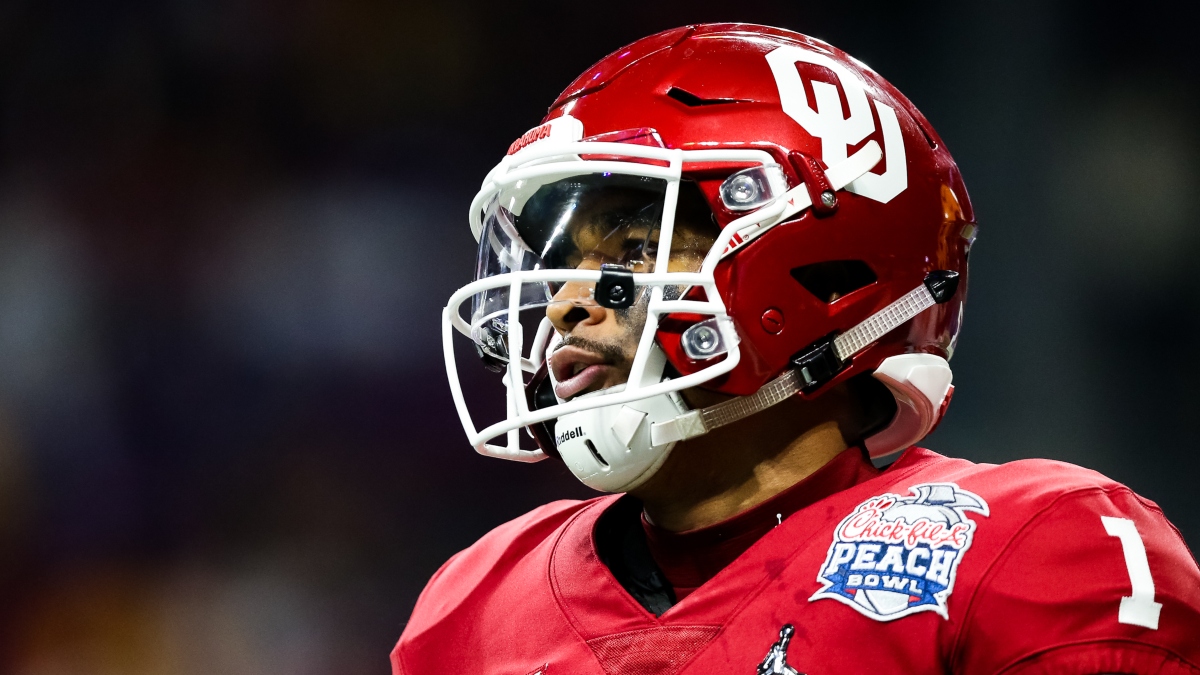
Although he's just the No. 5 quarterback drafted in the class, the truth is that Hurts unquestionably has the highest fantasy upside of any 2020 rookie quarterback, including Burrow and Tagovailoa, his former Alabama teammate.
If not for what Burrow did in 2019, Hurts might have become the third straight transfer quarterback to win the Heisman Trophy for Oklahoma.
Hurts entered college as the No. 1 dual-threat quarterback recruit in the nation, and he opened his career at Alabama with two strong seasons, leading the Crimson Tide to the College Football Championship in each campaign.
- 2016 (15 games): 62.8% completion rate, 2,780 yards passing, 23:9 TD:INT, 191-954-13 rushing
- 2017 (14 games): 60.4% completion rate, 2,081 yards passing, 17:1 TD:INT, 154-855-8 rushing
I don't want to make too much of this, but as a passer, Hurts in his 19-year-old sophomore season was highly comparable to Wilson in his 20-year-old redshirt freshman campaign.
- Jalen Hurts (2017): 154-of-255 passing, 2,081 yards passing, 17:1 TD:INT
- Russell Wilson (2008): 150-of-275 passing, 1,955 yards passing, 17:1 TD:INT
What's more is that Hurts made tangible year-over-year improvements in his second season, based on a number of metrics, including adjusted yards per attempt (AY/A), average depth of target (aDOT), independent quarterback rating (IQR), catchable ball rate (Cbl%) and expected points added (EPA) as a passer, runner and per dropback (per SIS).
- 2016: 7.4 AY/A | 7.7 aDOT | 108.0 IQR | 81% Cbl% | -7.7 paEPA | 12.2 ruEPA | 0.02 EPA/db
- 2017: 9.3 AY/A | 8.5 aDOT | 128.1 IQR | 83% Cbl% | 19.5 paEPA | 32.2 ruEPA | 0.11 EPA/db
By most objectives measures, Hurts had a promising sophomore season. But in the 2017-18 title game, he got Tua'ed, as head coach Nick Saban benched him in the second half and went with the heralded true freshman backup instead, who led the team to victory.
After that, Hurts was predictably demoted for the 2018 season, and after a year of riding the bench, he transferred to Oklahoma for 2019.
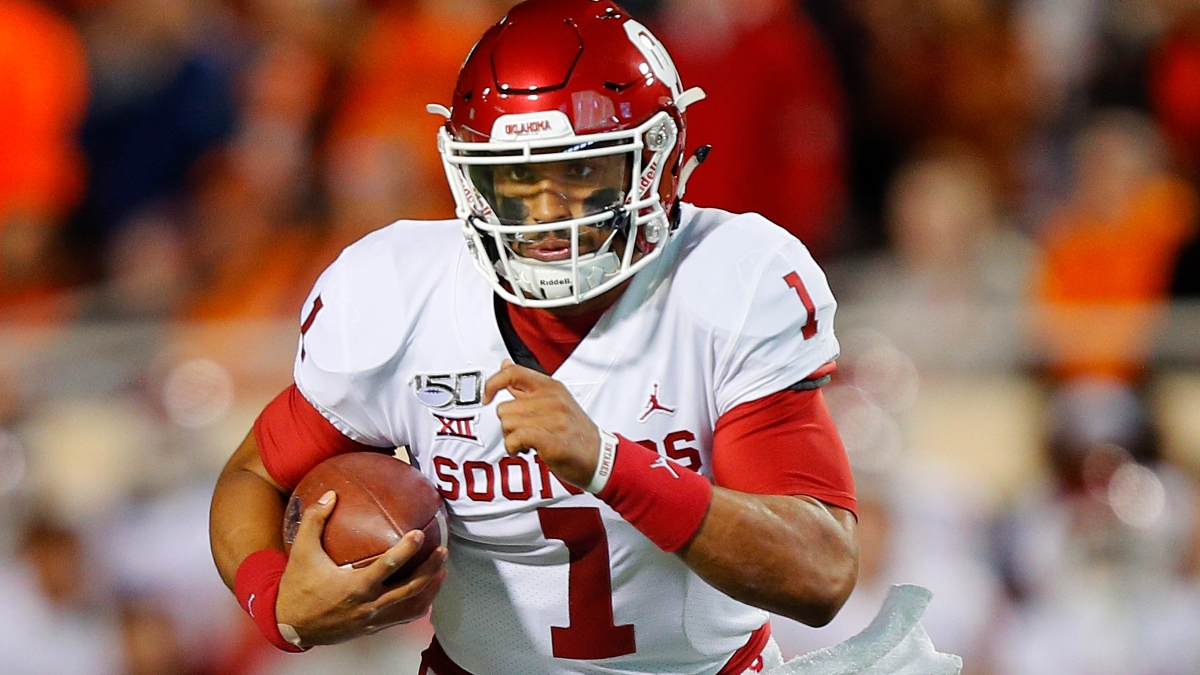
Given how well Hurts played as a senior in head coach Lincoln Riley's offense, you have to figure that he's kicking himself at least a little for not transferring as a junior.
In 2019, Hurts had himself a transformational season.
- Passing: 69.7% completion rate, 12.2 AY/A, 32-8 TD:INT ratio
- Rushing: 1,298 yards, 20 touchdowns, 5.6 yards per carry (including sacks)
- Awards: Semifinalist – Heisman Trophy, Maxwell Award, Davey O’Brien Award
With his performance, Hurts put himself in the top three of many statistical categories on the SIS quarterback leaderboards, ranking right up there with Burrow and Tagovailoa.
- Yards per attempt: 11.3 (1st-t)
- On-target percentage: 81% (3rd)
- Independent quarterback rating: 134.5 (3rd)
- Expected pointed added per dropback: 0.38 (3rd)
And as a runner, Hurts absolutely dusted Burrow and Tagovailoa in expected points added.
- Jalen Hurts: 53.9 ruEPA
- Joe Burrow: 26.0 ruEPA
- Tua Tagovailoa: 3.4 ruEPA
If you want to, you can discount Hurts' production because it came in a spread offense against subpar Big 12 defenses — but what Hurts did, he accomplished in his first year in a new system at a new school with new teammates.
What did Burrow do in his first year at LSU? And for that matter, what did Burrow do in his first year at Ohio State? (You don't actually need to answer that. We both know he did nothing.)
And by the way, we didn't discount quarterbacks Baker Mayfield and Kyler Murray for what they did at Oklahoma, and Hurts performed comparably.
% of accurate passes beyond 10 yards in Lincoln Riley's offense:
2017 Baker Mayfield – 51.7%
2018 Kyler Murray – 51.4%
2019 Jalen Hurts – 51.8%spooky scary
— Seth Galina (@pff_seth) April 21, 2020
Per PFF, Hurts trailed only Burrow in 2019 with his overall grade of 91.6.
Again, I wish to assert in no uncertain terms that Hurts has the highest fantasy upside of any quarterback in this class.
Hurts isn’t a traditional, strong-armed pocket passer with pinpoint accuracy. He sometimes holds onto the ball too long as he waits for plays to develop, and he has a slow release. He's accurate to the short and intermediate areas of the field, but his downfield throws are a smidgen scattershot.
But Hurts is extremely careful with the ball. He rarely turns it over. On top of that, he’s smart, tough and accurate enough to deliver the ball almost anywhere it needs to be, and his ability to make plays out of the pocket and to rush the ball on designed runs and forced scrambles gives him a true edge.
How high is Hurts' upside?
With his college production, athleticism and skill set, Hurts is essentially a combination of Jackson and Prescott: He’s a better thrower than L-Jax, a better runner than Dak and probably not as good as either — but he’s got potential.
He's going to open his career as a backup, but I wouldn't be shocked to see him get a full-time gig in a few years.
NFL Prospect Comp: Tim Tebow but right-handed, more accurate and just better overall
42. Colby Parkinson, TE, Seahawks
- Draft Position: 4.133 | School: Stanford
- Height: 6’7” | Weight: 252 pounds
- 40-yard dash: 4.77 seconds
- 2020 Age: 21 | Class: Junior
- Recruitment Stars: 4-5
UPDATE (Aug. 7): I am still bullish on Parkinson's long-term potential, but he suffered a broken foot in June and is still rehabbing. As a result, his average draft position is nonexistent, and he can easily be dropped down the rankings. He's not someone to draft, but he should be monitored after he returns to action.
I want to be clear: There's almost nothing on the field that's special about Parkinson. He has great hands: He has only three drops on 165 career targets (per PFF). And across his career, he's had acceptable raw production.
- 2017 (14 games): 10-97-4 receiving
- 2018 (13 games): 29-485-7 receiving
- 2019 (12 games): 48-589-1 receiving
But this production has come with a subpar 51% catch rate, and over the past two years he's had just 1.5 yards per route (per SIS).
It's disturbing that he's not more efficient as a receiver because he's an average-at-best blocker.
But he's worth a speculative pick because he's just 21 years old, he was a top-30 national recruit when he enrolled at Stanford and he has long-term potential on the Seahawks, who have an unsettled tight end depth chart: Greg Olsen and Jacob Hollister are both on one-year deals, and Will Dissly has missed most of the past two seasons with first a torn patella tendon and then a torn Achilles tendon — injuries that normally derail NFL careers.
It's not unfathomable that Parkinson could be the starting tight end for quarterback Russell Wilson in 2021.
NFL Prospect Comp: Kevin Boss with more draft capital and significantly more youth but also less production
43. La'Mical Perine, RB, Jets
- Draft Position: 4.120 | School: Florida
- Height: 5’11” | Weight: 216 pounds
- 40-yard dash: 4.62 seconds
- 2020 Age: 22 | Class: Senior
- Recruitment Stars: 3
We've officially reached the point where we're looking at guys who really don't interest me. Congratulations.
On the depth chart for the Jets, it's pretty much just Le'Veon Bell, who is now 28 and entering what could be his last year in New York, given that the Jets can cut him in 2021 while eating only $4 million in dead money.
Perine never had even 1,000 scrimmage yards in any season at Florida, but he did have a strong 40-262-5 receiving line as a senior.
With good size and pass-catching skills, Perine could be a serviceable backup to Bell in 2020 and, perhaps, the lead back in 2021.
NFL Prospect Comp: Vick Ballard with more draft capital but less production
44. DeeJay Dallas, RB, Seahawks
- Draft Position: 4.144 | School: Miami
- Height: 5’10” | Weight: 217 pounds
- 40-yard dash: 4.58 seconds
- 2020 Age: 22 | Class: Junior
- Recruitment Stars: 4
Dallas is basically the Seattle version of Perine: He's a below-average athlete who never had even 1,000 scrimmage yards in any college season.
I doubt he does anything notable in the NFL, but Chris Carson and Rashaad Penny both suffered season-ending injuries last year. You never know.

NFL Prospect Comp: James Davis with more draft capital but way less production
45. Eno Benjamin, RB, Cardinals
- Draft Position: 7.222 | School: Arizona State
- Height: 5’9" | Weight: 207 pounds
- 40-yard dash: 4.57 seconds
- 2020 Age: 21 | Class: Junior
- Recruitment Stars: 4
UPDATE (Aug. 16): I have bumped Benjamin up a tier. He's simply too skilled to be lumped in with the wide receivers drafted late on Day 3.
Benjamin was projected as a Round 3 pick by Zierlein and comped to Devin Singletary, but he fell all the way to Round 7, where the Cardinals grabbed him.
With his skill set, Benjamin has a decent chance to unseat Chase Edmonds for the backup role, and although starter Kenyan Drake seems likely to sign a long-term deal with the team, he is currently on the transition tag and slate to be a free agent next year.
So there's a chance that Benjamin could enter 2020 as the backup to Drake and then enter 2021 as the presumptive starter. That probably won't happen, but it could.
Why did Benjamin fall down the draft? I think it's because, in the vernacular of Larry David, he is a yo-yo. An inverse yo-yo.
At the combine, he weighed in at a respectable 207 pounds, but just a month before at the Senior Bowl, he weighed in at a terrifying 195 pounds.
With his combine measurements, he can be compared to guys like LeSean McCoy (5-foot-10 and 208 pounds), Devonta Freeman (5-foot-8 and 206 pounds) and Felix Jones (5-foot-10 and 207 pounds).
With his Senior Bowl measurements, we're talking about guys like Kenjon Barner (5-foot-9 and 196 pounds), Kerwynn Williams (5-foot-8 and 196 pounds) and maybe Steve Slaton (5-foot-9 and 197 pounds) — but all of those guys were significantly faster.
Put simply: If Benjamin plays at his combine weight, he might be a lead back, even with his subpar speed. Slow-ish 40 times haven't hindered McCoy and Freeman. In Round 1, Edwards-Helaire was taken as the No. 1 back in the class despite his timed sluggishness.
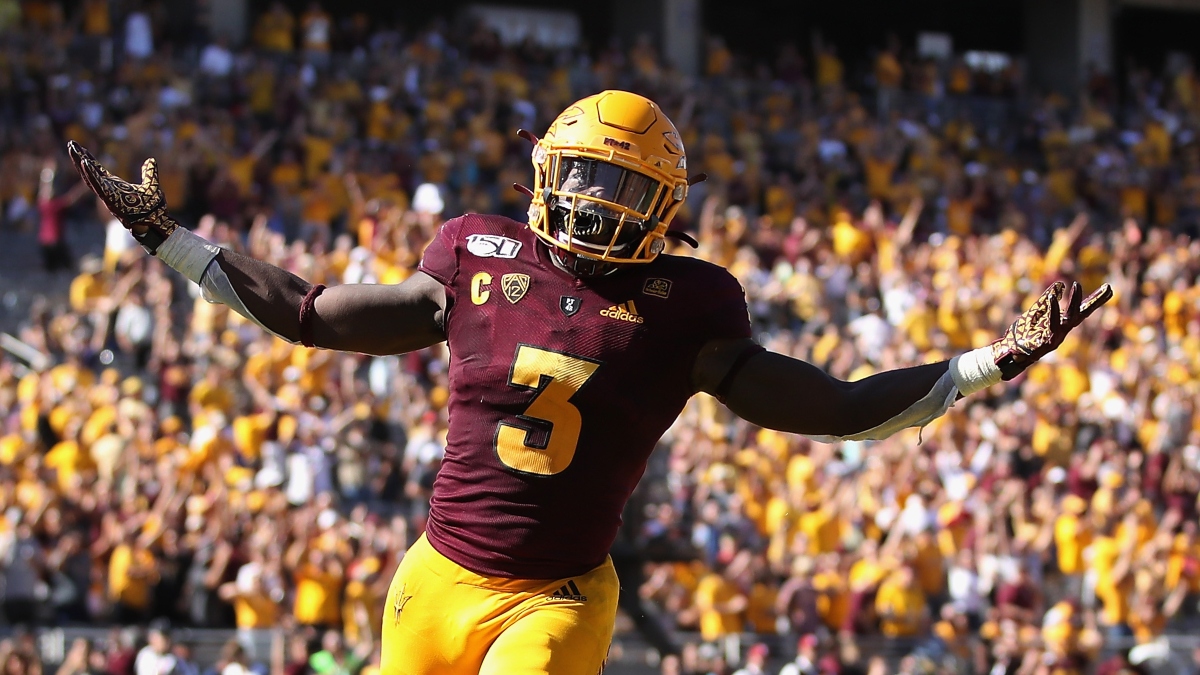
If, however, Benjamin plays at his Senior Bowl weight, he'll likely be nothing more than a change-of-pace No. 2 option in a committee. At the absolute best, he'll be a slightly bigger version of Dion Lewis, who has just one season of 1,000-plus yards.
And it's not as if Lewis is a bad player or has had a substandard career — but he's not a hoped-for outcome.
Size concerns aside, Benjamin could surprise in the NFL if he gets regular work. After playing as the No. 3 back behind Demario Richard and Kalen Ballage as a rookie, Benjamin broke out as a sophomore and continued to produce as a junior.
- 2018 (13 games): 300-1,642-16 rushing, 35-263-2 receiving on 44 targets
- 2019 (12 games): 253-1,083-10 rushing, 42-347-2 receiving on 52 targets
What stands out most about Benjamin is his receiving workload. He was heavily utilized in the passing game at Arizona State and is a natural hands catcher with just six drops on 88 catchable targets for his career (per PFF).
If he manages to become a lead back, he could be a true three-down asset because of his pass-catching ability.
I don't think much of Benjamin's running style. He's more of a slasher than a grinder, and for his career, he's averaged a rather pedestrian 3.1 yards after contact per attempt (per SIS). He seems to lack the power necessary to move a pile.
But I also don't know how much running style matters. It seems like the kind of thing focused on most by people who don't win their fantasy leagues.
NFL Prospect Comp: Paul Perkins with less draft capital but more youth
TIER 10
46. Donovan Peoples-Jones, WR, Browns
- Draft Position: 6.187 | School: Michigan
- Height: 6’2” | Weight: 212 pounds
- 40-yard dash: 4.48 seconds
- 2020 Age: 21 | Class: Junior
- Recruitment Stars: 4-5
People-Jones was one of the top recruits in the country entering college, but he never had even 750 yards in a season at Michigan.
He's still just 21 years old and is extremely fast and explosive for his size (per PP).
- Speed score: 106.7 (86th percentile)
- Burst score: 145.2 (99th percentile)
But he's a total project.
NFL Prospect Comp: Chris Conley with less production, less speed and far, far less draft capital
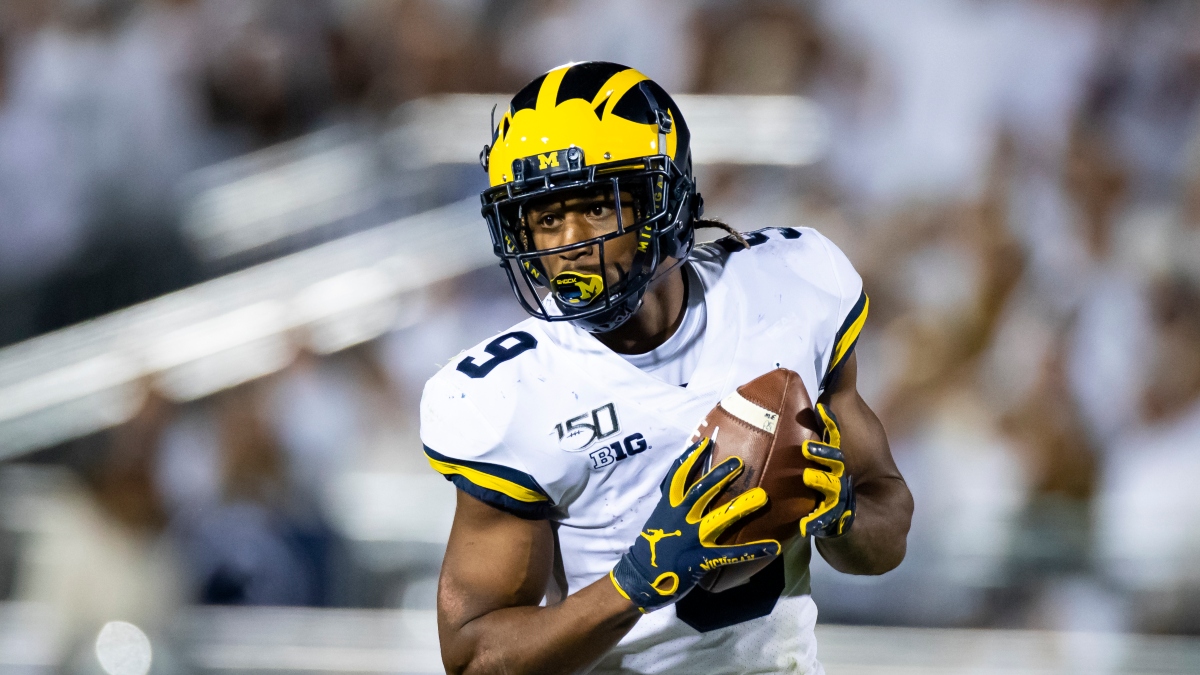
47. Isaiah Hodgins, WR, Bills
- Draft Position: 6.207 | School: Oregon State
- Height: 6’4” | Weight: 210 pounds
- 40-yard dash: 4.61 seconds
- 2020 Age: 22 | Class: Junior
- Recruitment Stars: 3-4
Hodges is a middling athlete, but he has PFF's No. 1 hands at the position, and he consistently improved each year in PFF grade, total receiving production and Dominator Rating.
- 2017 (11 games): 66.2 PFF, 31-275-2 receiving, 15% Dominator Rating
- 2018 (11 games): 84.6 PFF, 59-876-5 receiving, 30% Dominator Rating
- 2019 (12 games): 90.1 PFF, 86-1,171-13 receiving, 40% Dominator Rating
He's buried on the depth chart, and he'll need to get past fourth-rounder Gabriel Davis in order to have a shot at cracking the starting lineup eventually, but Hodgins is better than the typical sixth-rounder.
He wouldn't be the first late-round receiver in recent history to become a starter for the Bills.
NFL Prospect Comp: Stevie Johnson with more college production
48. James Proche, WR, Ravens
- Draft Position: 6.201 | School: SMU
- Height: 5’11” | Weight: 201 pounds
- 2020 Age: 24 | Class: Redshirt Junior
- Recruitment Stars: 3-4
Proche reportedly slipped in the draft because of health concerns, perhaps related to an episode of acute kidney failure he had his senior year of high school. But the Ravens snagged him in Round 6, and he's intriguing in Baltimore.
Proche is a limited athlete, but he didn't let that stop him from producing at SMU.
- 2016 (12 games): 57-709-6 receiving
- 2017 (12 games): 40-816-6 receiving
- 2018 (12 games): 93-1,199-12 receiving
- 2019 (13 games): 111-1,225-15 receiving
Because of his athleticism, Proche might be forced into the slot in the NFL, but in college he has moved around the formation freely and been targeted regularly regardless of where he's lined up.
Proche is just a mid-sized receiver, but he is ferocious in attacking the ball and out-muscling defensive backs for position when the ball is in the air. Too many small guys get praised for playing big — but with Proche, it's true. He plays bigger than his size.
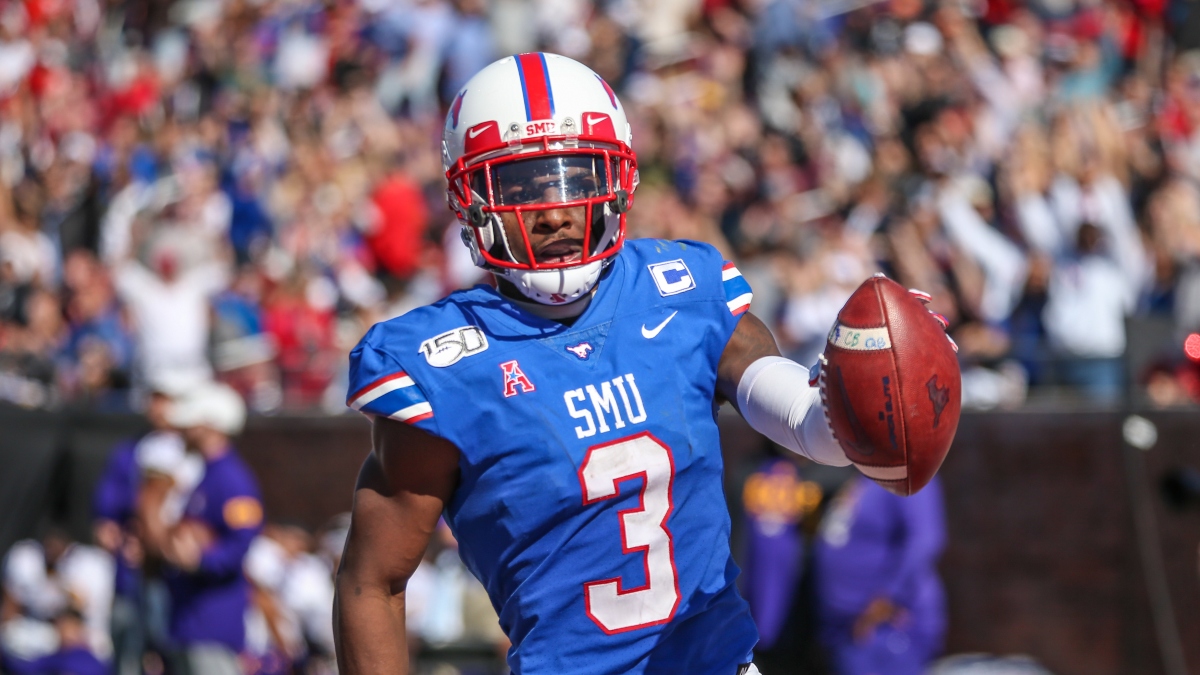
With the third-rounder Duvernay ahead of him on the depth chart, Proche is a longshot ever to get consistent playing time.
But if he does somehow get an opportunity, he could grab it.
NFL Prospect Comp: Victor Cruz with less speed but more production and draft capital
49. Jacob Eason, QB, Colts
- Draft Position: 4.122 | School: Washington
- Height: 6’6” | Weight: 231 pounds
- 40-yard dash: 4.89 seconds
- 2020 Age: 23 | Class: Redshirt Junior
- Recruitment Stars: 4-5
My unofficial over/under for games Eason starts this season: 0.5. And that's probably my over/under for Eason starts in 2021 as well.
Eason is a developmental prospect. That is all.
Even if quarterback Philip Rivers plays for only one year in Indianapolis, I doubt that Eason will be ready to take over for him in 2021.
If you're looking for a strong-armed quarterback who looks the part, that's Eason. But that doesn't mean he's actually an NFL quarterback.
Eason was the No. 1 pro-style quarterback recruit when he enrolled at Georgia in 2016, and as a true freshman he had an adequate season as the starter, completing 55.1% of his passes for 2,430 yards with 6.5 adjusted yards per attempt (AY/A) and a 16-8 TD:INT ratio.
Not great, but for a 19-year-old true freshman, pretty good.
In 2017, though, he suffered a knee injury in the season opener and lost his starting job to freshman backup Jake Fromm, who gave Eason the straight-up Wally Pipp treatment as he led the Bulldogs to the national title game.
As a result of his injury-induced demotion, Eason left Georgia and transferred back home to Washington (he grew up in the Seattle area), and after redshirting in 2018 due to NCAA rules, he started 13 games for the Huskies last year, completing a respectable 64.2% of his passes for 3,132 yards and a 23-8 TD:INT ratio.
For his 2019 effort, Eason earned a strong 84.3 PFF grade.
But for a peak season, 2019 wasn't all that special.
What Eason did in his best season doesn’t compare at all to what Burrow, Tagovailoa, and Hurts did in 2019 or even to what Love did in 2018, based on AY/A, independent quarterback rating (IQR) and expected points added (EPA) per dropback (per SIS).
- Eason (2019): 8.0 AY/A | 109.7 IQR | 0.04 EPA
- Burrow (2019): 12.5 AY/A | 145.3 IQR | 0.39 EPA
- Tagovailoa (2019): 13.4 AY/A | 146.6 IQR | 0.49 EPA
- Hurts (2019): 12.2 AY/A | 134.5 IQR | 0.38 EPA
- Love (2018): 9.4 AY/A | 120.3 IQR | 0.22 EPA
Despite his talent, it's clear that Eason never belonged in the Day 1 conversation.
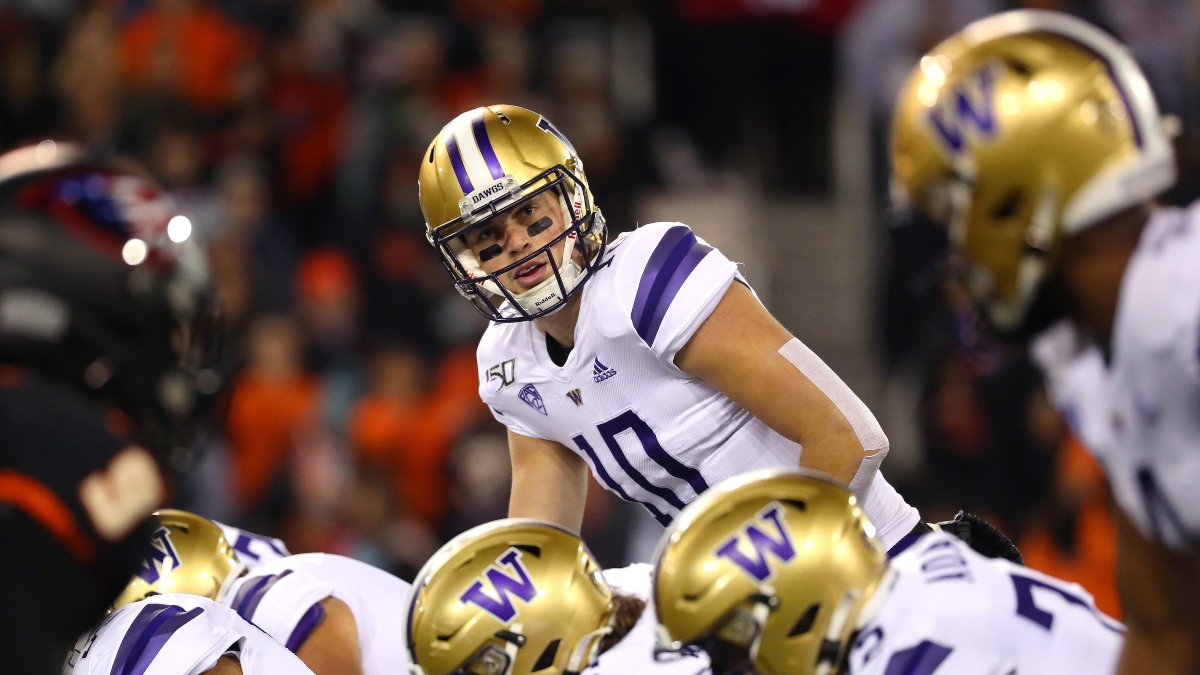
When everything around him is perfect and he can get in the groove, he is as good as anyone, per PFF: "Eason’s 91.7 clean-pocket passing grade led the Pac-12 in 2019." He has elite arm strength and is unafraid to make throws other quarterbacks wouldn't attempt. He can throw it all over the field. But he's a garden statue.
He has no speed and even less agility. His 7.50-second three-cone (3rd percentile) and 4.75-second 20-yard shuttle (2nd percentile) speak to his utter inability to navigate the pocket (per MD).
On top of that, Eason is inconsistently accurate. He stares down receivers. He is slow to progress through his reads. He is often too willing to trust his arm strength. And he falls apart under pressure, per PFF: "Has not handled pressure well whatsoever. One of the lowest grades in country."
In fact, Eason is such a pressure-sensitive passer that at times in 2019 he bailed from the pocket simply because he imagined pressure that wasn't there.
I think Zierlein puts it best: "His elite size and arm talent are reminiscent of Carson Palmer, but issues with pocket poise and getting through progressions cleanly are more reminiscent of Brock Osweiler."
For at least 2020 and maybe 2021 as well, Eason will play the Osweiler role to Philip Rivers' late-career Peyton Manning.
And Rivers might be an ideal guy for Eason to back up: Stylistically, he's pretty similar to Rivers, who himself opened up his career with two straight years on the bench behind Drew Brees.
But I'm still skeptical that Eason will develop into an NFL starter.
NFL Prospect Comp: Tom Savage but taller
50. Harrison Bryant, TE, Browns
- Draft Position: 4.115 | School: Florida Atlantic
- Height: 6’5” | Weight: 243 pounds
- 40-yard dash: 4.73 seconds
- 2020 Age: 22 | Class: Senior
- Recruitment Stars: 2
In the RV Prospect Box Score Scout, Bryant has Jordan Reed, George Kittle and Martellus Bennett among his 10 closest comps, thanks primarily to his draft position and prodigious college production.
- 2016 (12 games): 6-63-0 receiving
- 2017 (11 games): 32-408-5 receiving
- 2018 (12 games): 45-662-4 receiving
- 2019 (13 games): 65-1,004-7 receiving
I want to like Bryant, but he has an 18th-percentile 95.0 SPARQ-x score (per PP), which is a really bad mark for someone who is undersized at the position and supposed to be a move tight end.
On top of that, he's buried behind Austin Hooper and David Njoku on the depth chart. Even if Njoku leaves after this season, I still doubt that Bryant will get a wealth of playing time as the No. 2 tight end.
But Bryant was productive in college and is comparable to a number of guys who've had NFL success. Maybe it will work out for him.
NFL Prospect Comp: Jace Sternberger but skinnier and less invested with draft capital
Matthew Freedman is the Editor-in-Chief of FantasyLabs, part of The Action Network.
How would you rate this article?

